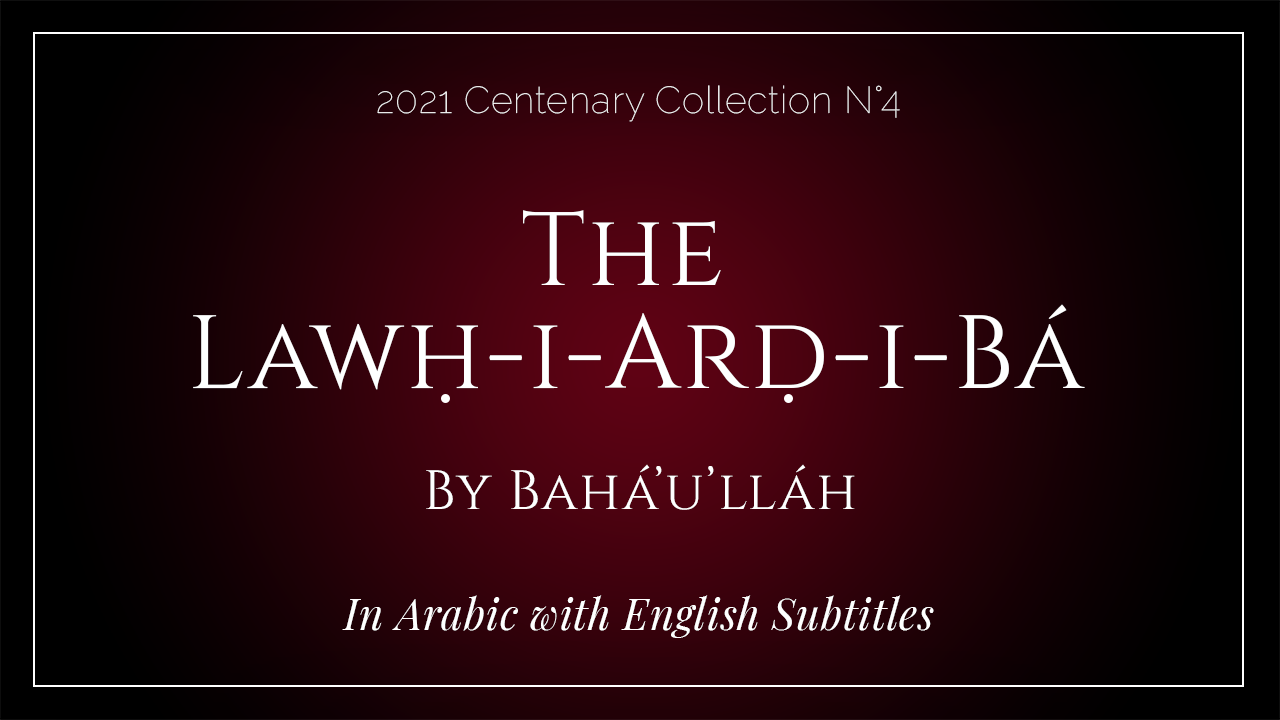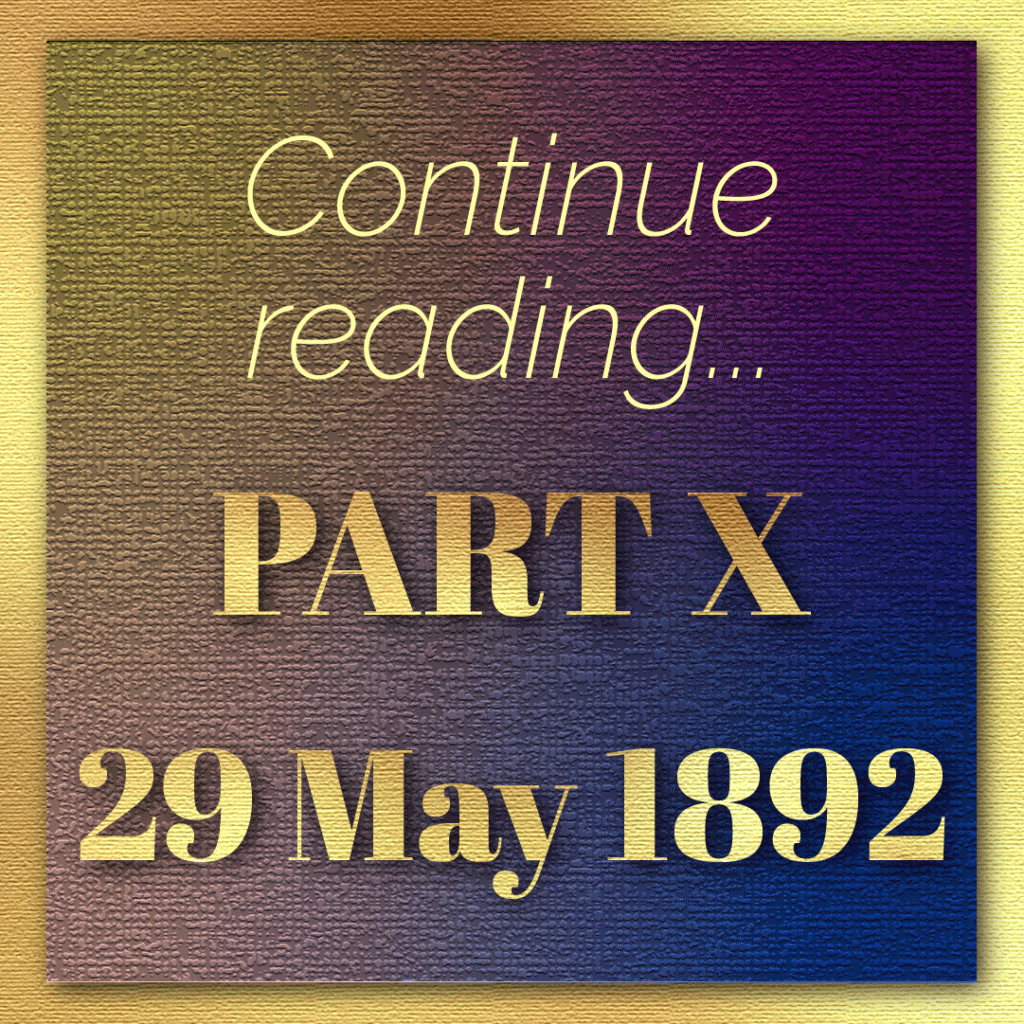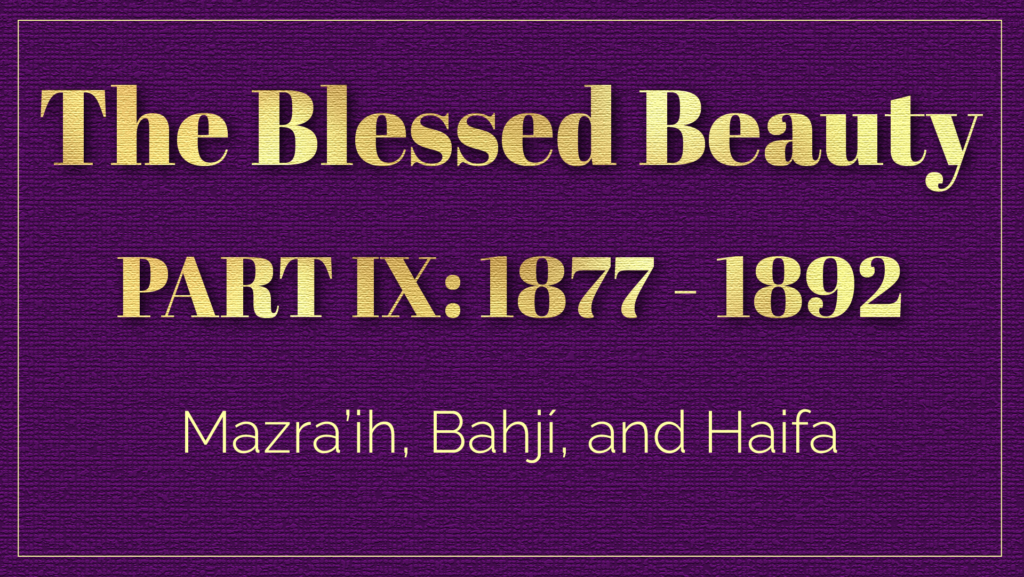
Written and illustrated by Violetta Zein
This part covers the life of Bahá’u’lláh between the age of 60 in 1877 to the age of 75 in 1892.
“The Almighty … hath transformed this Prison-House into the Most Exalted Paradise, the Heaven of Heavens.”
Bahá’u’lláh, quoted by Shoghi Effendi in God Passes By
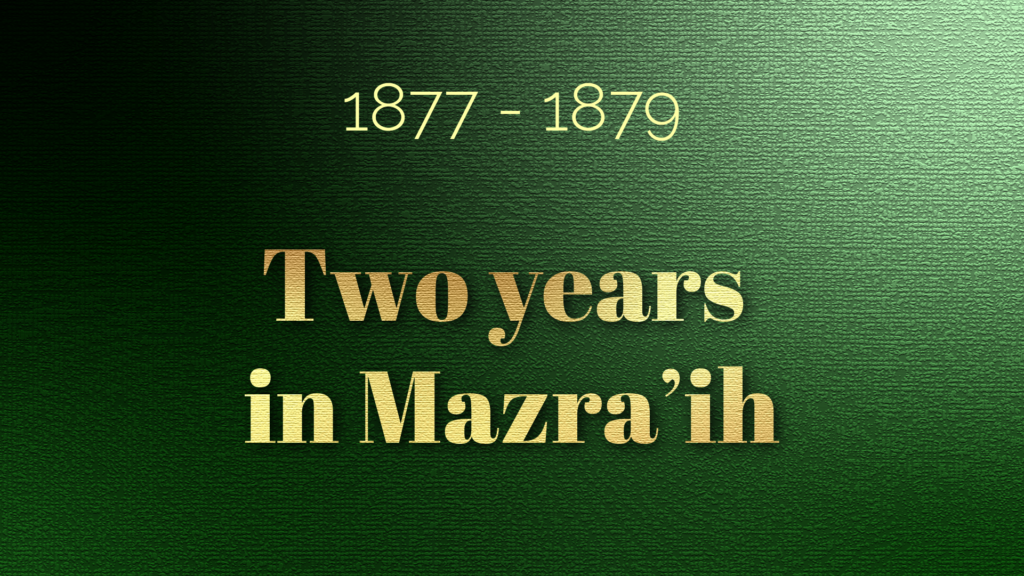
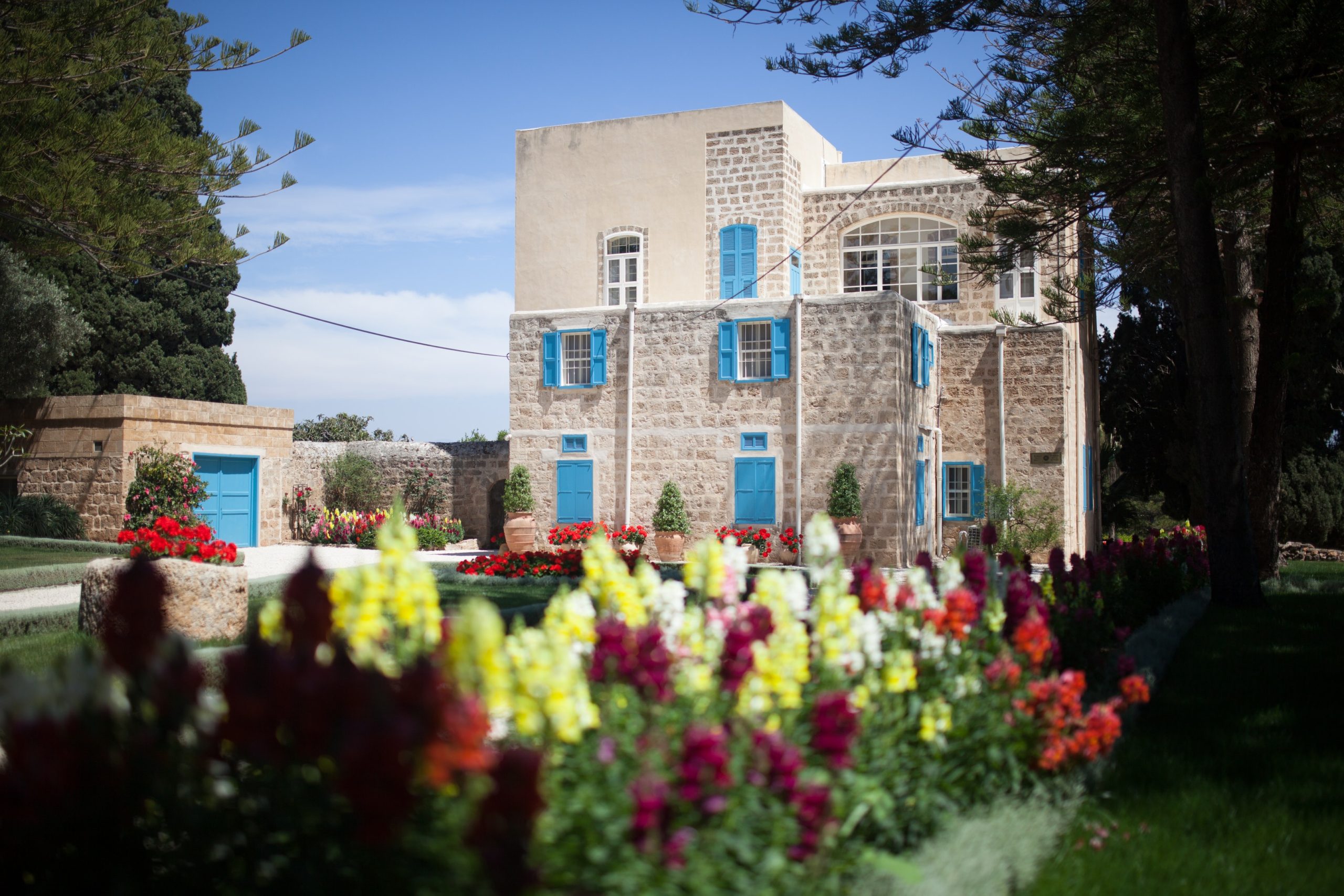
The Mansion of Mazra'ih. Source: Bahá'í Media Bank © Bahá'í International Community.
Once 'Abdu'l-Bahá drove Bahá'u'lláh to Mazra’ih, He returned to ‘Akká to ensure His Father’s tranquility by shouldering as many responsibilities as He could. Mazra’ih was a delightful pleasant mansion nestled in a vast plain with charming countryside, and surrounded by a lush garden. The air was fresh, the water pleasant, it boasted views of the Galilee hills to the east and the Mediterranean Sea to the west, and it was quiet. It was Bahá'u'lláh’s first haven of peace for decades, and He lived surrounded with nature. Bahá'u'lláh would later recount the delightful scenery at Mazra'ih in a Tablet to Áqá Mírzá Áqá, speaking in delightful language about its beautiful vistas and the charm of the orange trees weighed down with fruit as brilliant as balls of fire.
Mazra’ih was a small mansion, and Bahá'u'lláh used the ground floor as a reception room, in which many Bahá'ís attained His presence. His bedroom was on the upper floor of the Mansion, with a balcony overlooking the beautiful countryside.
The first 25 tumultuous years of Bahá'u'lláh’s ministry were a series of grave afflictions. Bahá'u'lláh was imprisoned five times, tortured, stripped of His wealth and properties, poisoned several times, once almost fatally, banished to four cities in three countries, with His last, perpetual, banishment in the desolate, stone wasteland of 'Akká where His 22-year-old son died in His arms.
Bahá'u'lláh’s move to this oasis of tranquility would be a turning point in His ministry, the inauguration of His final years in the plenitude of His glory and majesty. Bahá'u'lláh was still a prisoner in perpetuity of the Ottoman Empire, and He described this transformation of surroundings in spiritual terms: “The Almighty … hath transformed this Prison-House into the Most Exalted Paradise, the Heaven of Heavens.” 'Abdu'l-Bahá described this significant change in majestic terms: “Bahá'u'lláh proceeded out of the fortress with authority and might, and in a kingly Mansion beyond the city, made His home,” even calling the event miraculous: “…And this is one of Bahá'u'lláh's greatest miracles: that He, a captive, surrounded Himself with panoply and He wielded power. The prison changed into a palace, the jail itself became a Garden of Eden.
Mazra’ih had limited space, and Bahá'u'lláh mostly lived there with Mírzá Áqá Ján. 'Abdu'l-Bahá visited Mazra’ih often, and Bahíyyih Khánum also visited Bahá'u'lláh.
Bahá'u'lláh quoted by Shoghi Effendi in God Passes By.
H.M. Balyuzi, Bahá'u'lláh: The King of Glory, pages 359-361.
Adib Taherzadeh, The Revelation of Bahá'u'lláh Volume 4: Mazra’ih and Bahjí 1877-1892, pages 1 and 6-8.
David Ruhe, Door of Hope: The Bahá’í Faith in the Holy Land, pages 83-90.
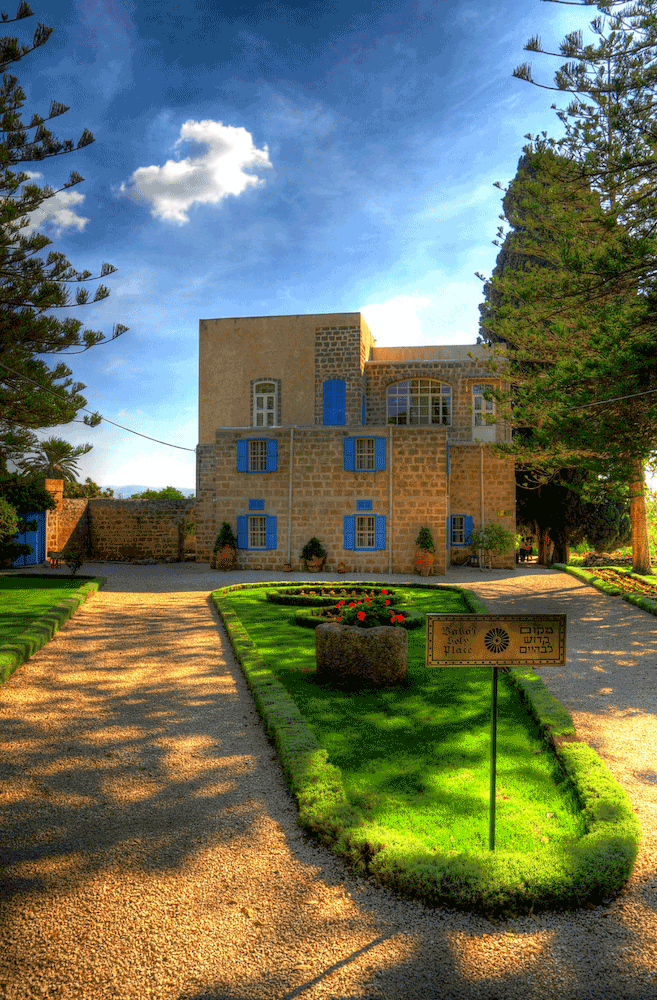
The Mansion of Mazra'ih, where feasts were held, as in the story below. © Chad Mauger, all rights reserved, used with permission. Source: Flickr.
Mazra’ih was a source of delight for both the resident and pilgrim Bahá'ís, elated at Bahá'u'lláh’s new freedom, and wonderful living conditions. Bahá'ís in Baghdád, Adrianople, the Most Great Prison, and 'Akká had developed the practice of holding feasts, something that became much easier in Mazra’ih. After obtaining Bahá'u'lláh’s permission, the believers would hold feasts in various locations in the countryside, which Bahá'u'lláh sometimes attended.
At times Bahá'u'lláh would sit amongst them, or as they all stood, He would mingle, speaking to them one at a time or in groups, and sometimes even eating with them before they returned at night to the Pilgrim House, the Khán-i-‘Avámíd.
On one occasion, a Bahá'í had invited Bahá'u'lláh and all the believers in ‘Akká for lunch on the first day of Ayyám-i-Há, and a large tent was set up in a delightful open space in front of the entrance to the garden at Mazra’ih. Two hundred Bahá'ís attended and gathered in front of the tent. Bahá'u'lláh came down from the upper floor of the Mansion around noon, entering the tent with great dignity, and Mírzá Áqá Ján chanted a dawn prayer which Bahá'u'lláh had revealed that very morning. Ater the prayer, Bahá'u'lláh invited the believers to sit, He spoke for some time, then asked: “What happened to the Feast, is it really going to happen?”
The believers sprung to their feet and lunch was soon brought in, placed on a low table in the center of the tent where Bahá'u'lláh sat with some of His sons, calling individual believers to come and join them.
Adib Taherzadeh, The Revelation of Bahá'u'lláh Volume 4: Mazra’ih and Bahjí 1877-1892, pages 7-10.
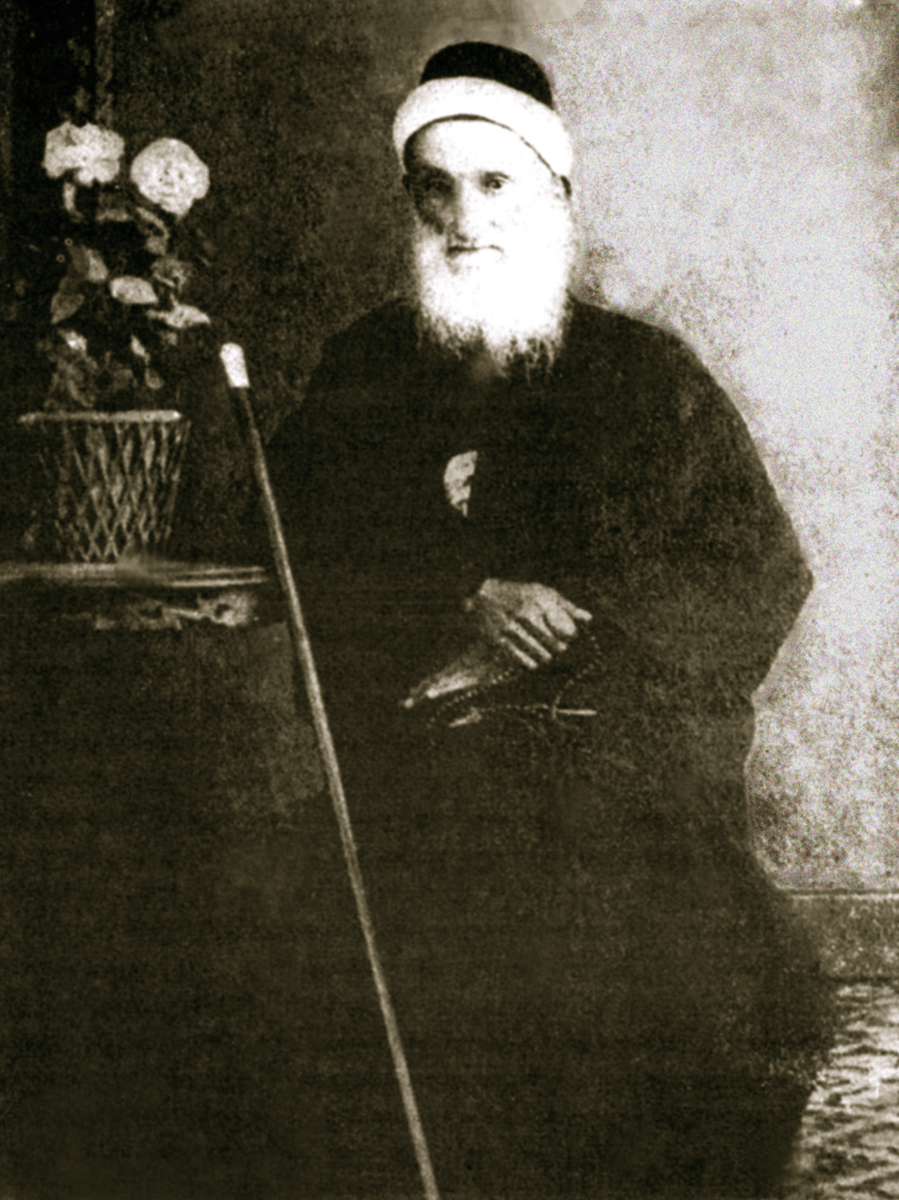
Sulayman Khan from Tunukabun, Mázindarán. He would later be known by the title bestowed on him by Bahá'u'lláh, Jamál Effendi, and would enter the annals of the Faith as the spiritual father of the subcontinent of India and of Burma. Photograph kindly provided for the chronology by Tahirih Taherzadeh from the website We are Bahá'ís: Jamal Effendi - The spiritual father of India and Burma -- the first Baha'i teacher sent to India and Burma by Baha'u'llah in 1875.
By the time Bahá'u'lláh arrived in ‘Akká, the Bahá'í Faith had spread from Persia to ‘Iráq, Turkey, the Holy Land, Syria, Lebanon, Turkmenistan, Egypt, the Sudan and India where Afnáns had established a printing press under the imprint Náṣirí, and had begun attracting believers. They wrote to Bahá'u'lláh asking if He could send them an experienced and knowledgeable Bahá'u'lláh teacher.
In 1878, Jamál Effendi, a tireless and renowned teacher of the Faith, came on pilgrimage after years of promulgating the Cause throughout Persia and the Ottoman Empire. Bahá'u'lláh sent Jamál Effendi to India after his pilgrimage, where he traveled and taught extensively throughout India, Ceylon and Burma for ten years, creating bonds of friendship and love with everyone, thanks to his pleasant manner and kind character. He received several encouraging Tablets from Bahá'u'lláh, who showered His confirmations on his teaching-work and assured him of His good-pleasure. Bahá'u'lláh also addressed Indian believers.
After returning for a short pilgrimage, Bahá'u'lláh sent him back to India, and he traveled to Badakhshán, Balkh, Burma, Ceylon, Java, Kashmir, Laddakh, Lahore, Malaya, Punch, Punjab, Siam, Tibet, Yarkand, and the islands of Celebes and Bali, establishing the Bahá'í Faith far and wide in the remote Indian subcontinent during the lifetime of Bahá'u'lláh.
Adib Taherzadeh, The Revelation of Bahá'u'lláh Volume 4: Mazra’ih and Bahjí 1877-1892, pages 177-183.
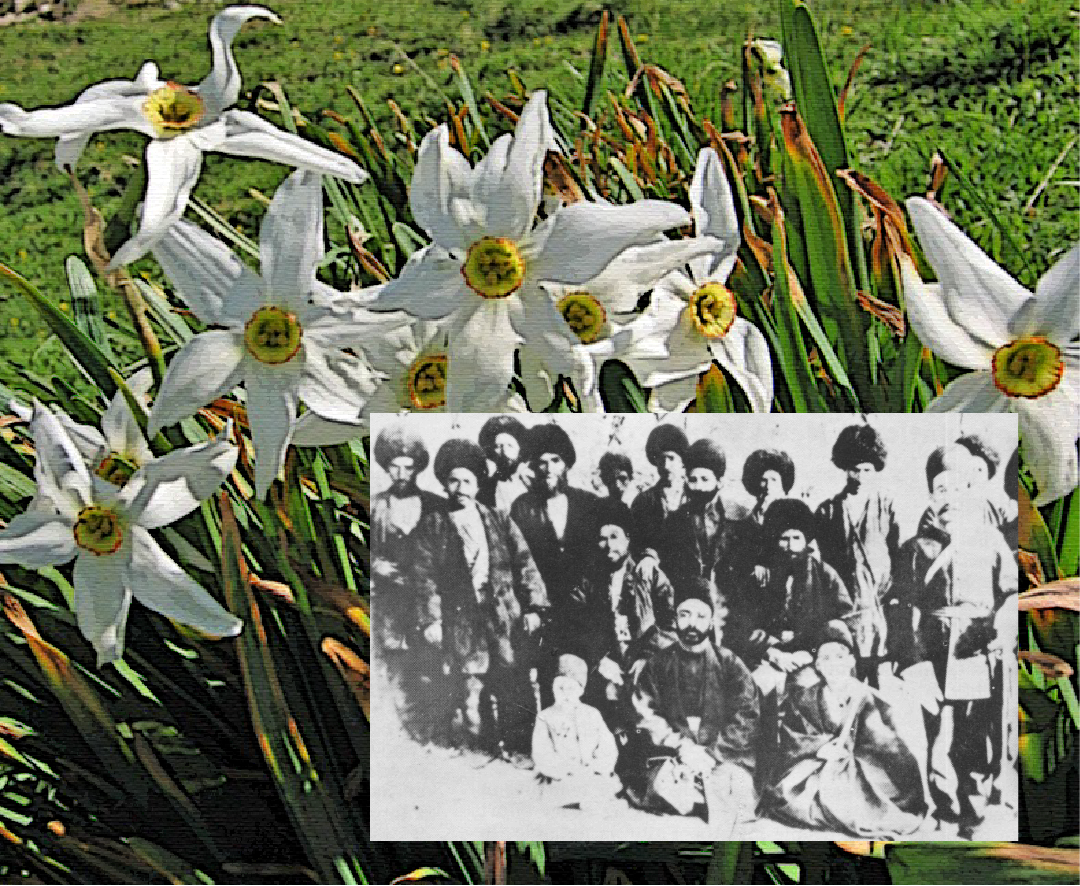
One of the oldest photos of the Bahá'ís of Saysán, the third man from the left is one of the two believers who carried the narcissus to Bahá'u'lláh in the Holy Land. Source: Bahá'í Library Online: Flowers to 'Akká. Posterized background of wild narcissus: Wikimedia Commons.
Saysán was a remote village, nested in barren mountains approximately 70 kilometers (40 miles) southwest of Tabríz. In 1850, shortly after the martyrdom of the Báb, a wave of excitement and conviction swept through the village and 2,700 of the 3,000 inhabitants, 90% of the population, became Bábís, and later Bahá'ís. The first group of Saysán pilgrims to the Holy Land included Ismá’íl Áqá, who later became 'Abdu'l-Bahá’s faithful gardener, and they arrived around 1878, bringing great happiness to Bahá'u'lláh with their zeal, enthusiasm, and sweet provincial remarks. The Saysánís were saddened by the lack of fresh vegetables in 'Akká, and invited Bahá'u'lláh to return to Saysán with them.
Before they left, Bahá'u'lláh advised them to plant potatoes, and they returned to Saysán with a stock of potato seeds. The new crop flourished in the soil of Ádhirbáyján, and with time, other farmers in the area adopted the crop, which became a staple food in the region, saving them from famine when their traditional grain crops failed some years later.
As soon as they returned to Saysán, two of the pilgrims set out again to 'Akká, this time with a the most befitting gift they could find for Bahá'u'lláh: two pots of narcissus, the Persian symbol of purity and love, which they carried on their heads, with a mule carrying the rest of their belongings, through 1,100 kilometers (700 miles) of desert, mountains, and border guards. They entered Bahá'u'lláh’s presence with swollen and blistered feet, and laid their gift of living beauty, carried with zeal and love, before the Blessed Beauty, Who showered them with blessings, bounty and favor. Their gift was not only accepted, but considered the most precious gem that could ever be presented, the richest and finest gift in the world.
Abu'l-Qásim Faizi, Flowers to ‘Akká, published in Bahá'í News 1969, Number 5, pages 8-11, on Bahá'í Library Online.
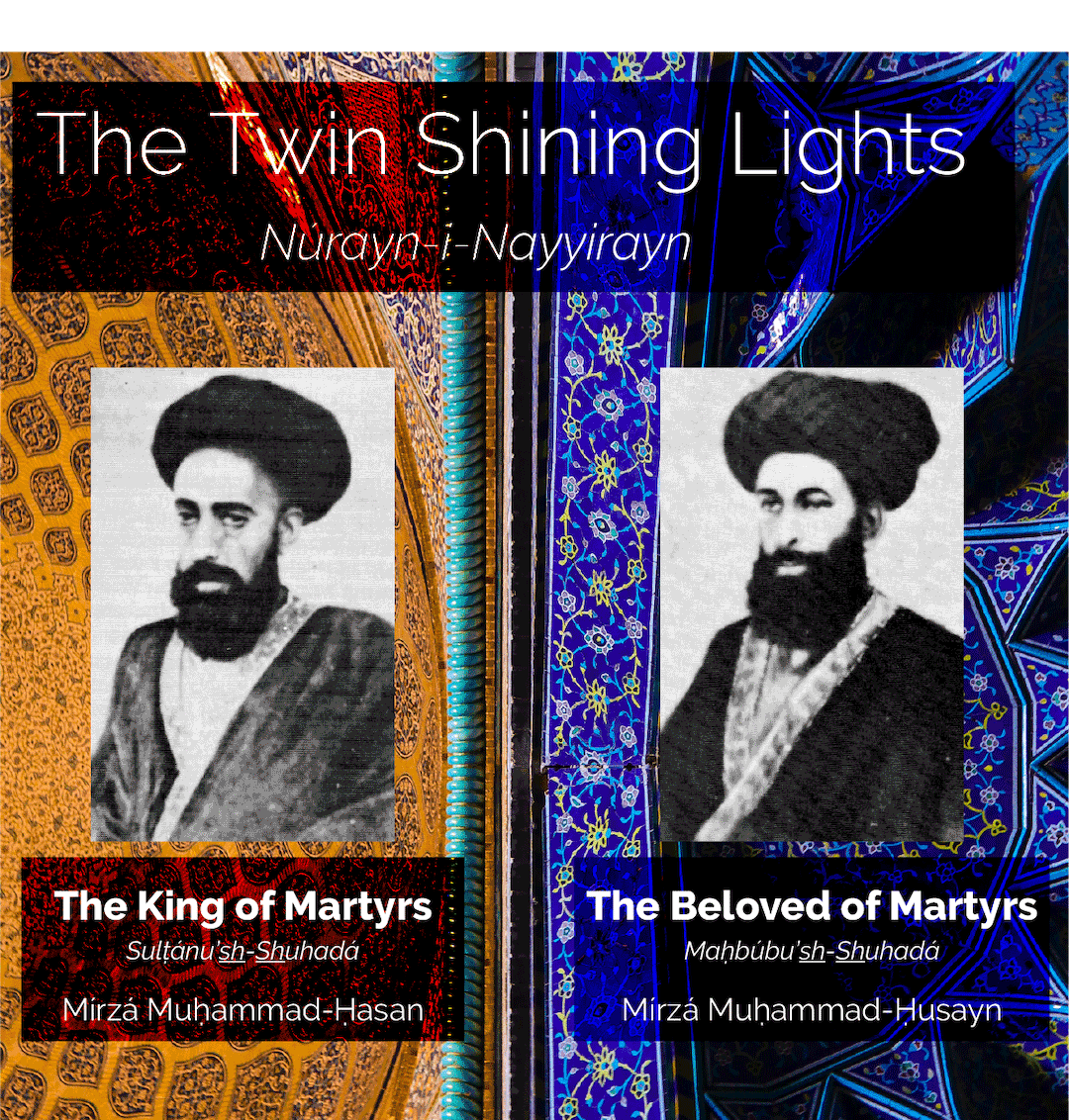
Left: The King of Martyrs, Mírzá Muḥammad-Ḥasan, and his brother, right: The Beloved of Martyrs, Mírzá Muḥammad-Ḥusayn. Source: Wikimedia Commons, scanned from H.M. Balyuzi, Eminent Bahá'ís in the time of Bahá'u'lláh, page 47. Background: Single photo of the inside architecture of Shaykh Lotfulláh mosque in Iṣfahán by Hossein Farahani on Unsplash.
Mírzá Muḥammad-Ḥasan and Mírzá Muḥammad-Ḥusayn, were born into an illustrious Bábí family. They had attained the presence of the Báb in Iṣfahán, and entered the presence of Bahá'u'lláh in Baghdád, and had been the recipients of many Tablets. They were highly prosperous merchants in Iṣfahán, utterly detached and generous in helping both their fellow believers and the needy, providing food during famines, and renowned through the city for their trustworthiness.
The Imám-Jumi’h of Iṣfahán, Mír Muḥammad-Ḥusayn, the Imám-Jumi’h, entrusted the management of his affairs to the capable brothers. After his investment had prospered, he realized he owed the brothers a considerable amount of money for their services, and decided to kill them. Bahá'u'lláh condemned the evil man as “Raqshá” (the She-Serpent), for his swift and violent attack on the kind and compassionate brothers. The brothers were executed on 17 March 1879, their arms wrapped around each other, each one pleading with the other to be martyred first.
Many in the crowd clamoring for their execution had, over the years, been the recipient of their generosity, even their executioner, a man named Ramaḍán, to whom Mírzá Ḥasan, the King of the Martyrs, gave a precious ring from his own finger. After their martyrdom, ropes were tied to their feet, and their bodies dragged through the streets of Iṣfahán for all to see, before being abandoned in a dilapidated building, and later buried by their younger brother.
Their entire estate was confiscated, including their vast stores of merchandise and considerable financial assets, their homes were plundered, and even some of their trees were uprooted and stolen. Their families were left in completely empty houses, helpless, terrified and surrounded by a hostile mob.
Adib Taherzadeh, The Revelation of Bahá'u'lláh Volume 4: Mazra’ih and Bahjí 1877-1892, pages 73-80.
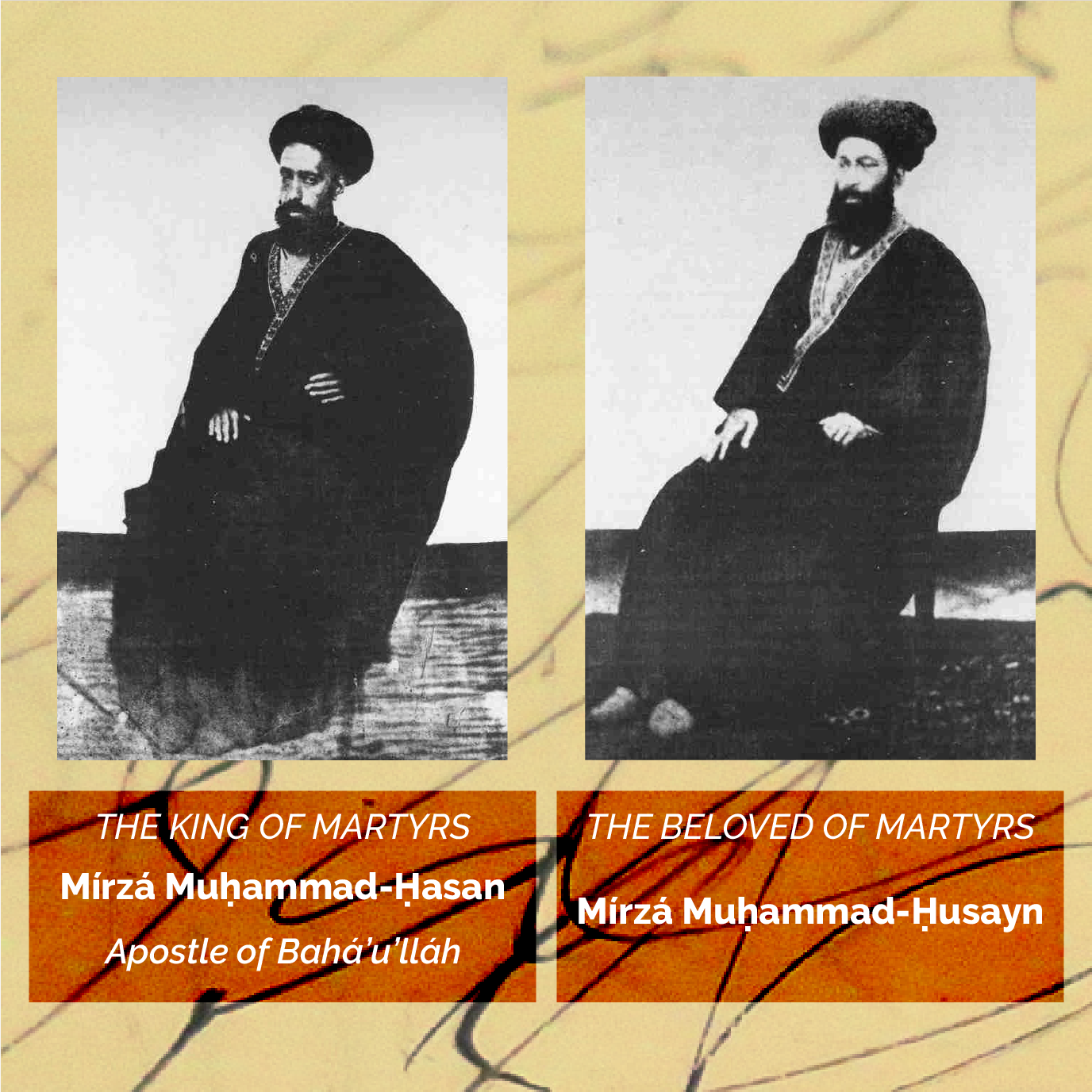
Left: The King of Martyrs, Mírzá Muḥammad-Ḥasan, appointed Apostle of Bahá'u'lláh by Shoghi Effendi, and his brother, right: The Beloved of Martyrs, Mírzá Muḥammad-Ḥusayn Source: Adib Taherzadeh, The Revelation of Bahá'u'lláh Volume 4: Mazra’ih and Bahjí 1877-1892, between pages 76-78.
Mírzá Muḥammad-Ḥasan and Mírzá Muḥammad-Ḥusayn’s martyrdom shook the Bahá'í community to its core and brought Bahá'u'lláh incalculable sorrow. Bahá'u'lláh named the two brothers Sulṭánu'sh-Shuhadá (King of the Martyrs) and Maḥbúbu'sh-Shuhadá (Beloved of the Martyrs), and as He had done after Badí’s martyrdom, He lamented their loss for years, revealing almost one hundred Tablets in their honor in which He extolled their station and virtues and praised their sacrifice. Perhaps the most astounding statement Bahá'u'lláh makes, in a Tablet to one of the Afnáns, is that sacrifice of the King and Beloved of Martyrs made a greater impression, exerted more influence and was more heart-breaking than the Martyrdom of the Báb.
In these hundred Tablets, Bahá'u'lláh refers to the brothers as the “twin shining lights,” “the great trust of God”, “the spirit which appeared in the form of a human temple to serve God,” “the tree of love,” “the breeze of God that wafted over the city,” “the luminous stars,” “the ocean of the love of God,” and “a fruit upon the tree of fidelity,” among other designations. Bahá'u'lláh also affirming their martyrdom had been the greatest sacrifice in this Cause, through which the standards of victory “were hoisted,” and “the horizon of steadfastness illumined.”
In a Tablet to Varqá, Bahá'u'lláh describes their spiritual recreation during their pilgrimage to Baghdád, affirming that, following their return to Iṣfahán, the Hand of Power exalted them among the believers, and the clouds of heaven and generosity rained wealth, luck and fame upon them. Addressing Himself to Shaykh Káẓim-i-Samandar, Bahá'u'lláh states that the soul of the Prophet Muḥammad wept at their martyrdom. Again in a Tablet to Varqá, Bahá'u'lláh proclaims that God had bestowed on them special favors, that they had appeared among the people as the embodiments of honor and glory, and that their true station was so lofty it would dumbfound the people.
In another Tablet, Bahá'u'lláh declares that the King and Beloved of the Martyrs had attained the station of martyrdom twice: once during their life, so fully had they sacrificed themselves for the Faith, and once in death, and that their living martyrdom was astonishingly glorious. And in another Tablet, Bahá'u'lláh testifies that the Messengers of God and His Chosen Ones were desirous of attaining to the exalted station of the King and the Beloved of the Martyrs.
Adib Taherzadeh, The Revelation of Bahá'u'lláh Volume 4: Mazra’ih and Bahjí 1877-1892, pages 88-90.
TABLETS ABOUT THE KING AND THE BELOVED OF MARTYRS (IN THE ORDER QUOTED IN THE STORY)
Partial Inventory ID: BH00391
Abdu'l-Ḥamíd Ishráq-Khávarí, Kitáb-i Núrayn-i Nayyirayn (Biographies of the King and Beloved of martyrs), page 147.
Partial Inventory ID: BH00391
Abdu'l-Ḥamíd Ishráq-Khávarí, Kitáb-i Núrayn-i Nayyirayn (Biographies of the King and Beloved of martyrs), page 146-7.
Partial Inventory ID: BH02301
Abdu'l-Ḥamíd Ishráq-Khávarí, Kitáb-i Núrayn-i Nayyirayn (Biographies of the King and Beloved of martyrs), page 169-70.
Partial Inventory ID: BH00829
Abdu'l-Ḥamíd Ishráq-Khávarí, Kitáb-i Núrayn-i Nayyirayn (Biographies of the King and Beloved of martyrs), page 185-6.
Partial Inventory ID: BH00534
Abdu'l-Ḥamíd Ishráq-Khávarí, Kitáb-i Núrayn-i Nayyirayn (Biographies of the King and Beloved of martyrs), page 151.
Partial Inventory ID: No number
Unpublished compilation, National Archives Committee, no. 28, P. 517.
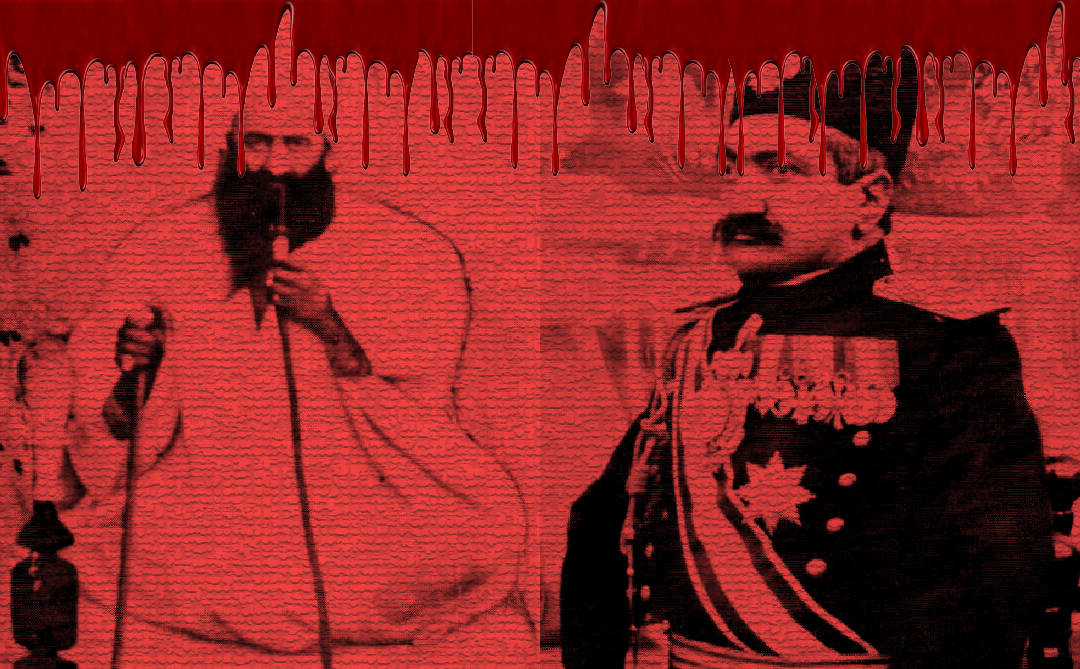
On the right: Masu’d Mírzá, the son of Naṣiri'd-Dín Sháh, and Governor of Iṣfahán, and one of the men responsible for the deaths of the King and Beloved of Martyrs. (Wikimedia Commons). No images could be found for Mír Muḥammad Ḥusayn or Shaykh Báqir, but on the left is a photograph of Shaykh Muḥammad-Taqí, known as Áqá Najafí, one of the sons of Shaykh Báqir (the Wolf), who had volunteered to execute the brothers himself. (Wikimedia Commons).
Very shortly after their martyrdom, Bahá'u'lláh revealed the weighty Lawḥ-i-Burhán (Tablet of the Proof) unleashing the wrath of God on Shaykh Báqir (the Wolf) and Mír Muḥammad Ḥusayn (the She-Serpent) for their vile roles in the senseless death of the King and Beloved of Martyrs. A copy of the Lawḥ-i-Burhán arrived in Ṭihrán on 24 April 1879, 38 days after the martyrdom of the King and Beloved of martyrs and Mírzá Abu'l-Faḍl made two copies in his own handwriting and delivered them to Shaykh Báqir and Mír Muḥammad Ḥusayn.
In the Lawḥ-i-Burhán, Bahá'u'lláh stigmatizes the two Muslim clerics and apostrophizing one and the other as “the heedless one,” “the perverse hater,” “the ignorant” who had “gone far astray”, who was “engulfed in evident folly,” “wrapped in thick veil,” and had “joined partners with God,” stating that the heinous crime they committed against the King and the Beloved of the Martyrs caused the Prophet Muḥammad to lament, “the hearts of the Concourse on high” to be consumed, “the soul of the Chaste One [Fáṭimih, daughter of the Prophet Muḥammad and holiest woman in Islám]” to melt, “the inmates of Paradise” to weep, “Gabriel [who had appeared to the Prophet Muḥammad as the Holy Spirit]” to groan, “all created things” to lament, “the limbs of the holy ones” to quake, and “darkness” to fall “upon all regions.”
Bahá'u'lláh addresses Himself to Shaykh Báqir, who issued their death warrant, declaring: “Hadst thou realized that which thou hast done, thou wouldst have cast thyself into the fire, or abandoned thine home and fled into the mountains.” Shaykh Báqir fell into disgrace and was exiled to Najf, where he died in a state of deep remorse in 1883.
In a deeply condemnatory statement to Mír Muḥammad Ḥusayn, Bahá'u'lláh prophesies “...O heedless outcast! Ere long will the breaths of chastisement seize thee, as they seized others before thee.” After being exiled from Iṣfahán, Mír Muḥammad Ḥusayn wandered from village to village, afflicted with a terrible vile form of throat cancer, and died in such disfavor that no one attended his funeral.
Partial Inventory ID: BH00336
Bahá'u'lláh, Lawḥ-i-Burhán (Tablet of the Proof)
Steven Phelps "The Writings of Bahá'u'lláh" in Routledge World: The World of the Bahá'í Faith, First Edition, Edited By Robert H. Stockman, page 69.
Adib Taherzadeh, The Revelation of Bahá'u'lláh Volume 4: Mazra’ih and Bahjí 1877-1892, pages 91-101.
DATE
The King and Beloved of Martyrs were martyred on 17 March 1879 and the Lawḥ-i-Burhán arrived in Ṭihrán 38 days later, on 24 April 1879. It follows the Tablet was revealed between these two dates. 24 April date obtained from Google AI.
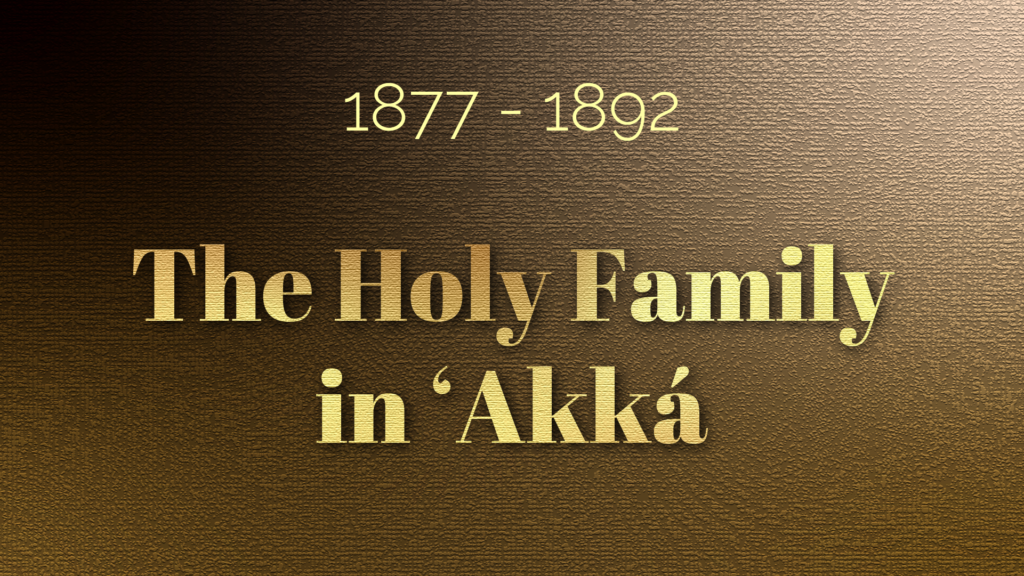
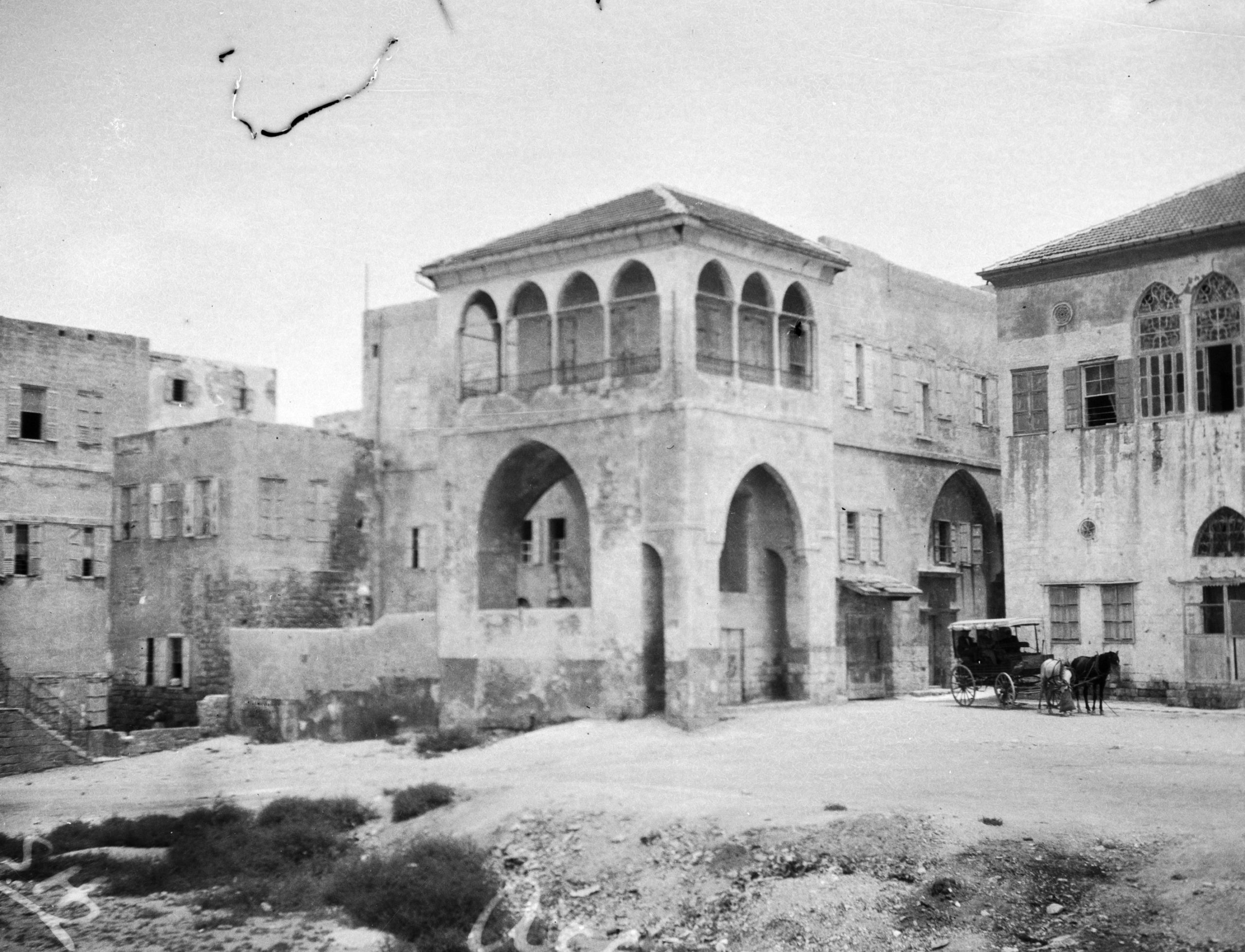
A view of the house of 'Abbúd in the 1920s. Source: Bahá'í Media Bank © Bahá'í International Community.
When Bahá'u'lláh left ‘Akká and took up residence in Mazra’ih, Ásíyih Khánum was 57 years old and they had been married for 42 years. Navváb and Bahá'u'lláh had never been separated, except for Bahá'u'lláh’s incarceration in the Siyáh-Chál, and His two years in Kurdistán. During the long march from Baghdád to Constantinople, they had traveled in the same howdah, and she had shared His imprisonment in the Most Great Prison. Yet, when Bahá'u'lláh moved to Mazra’ih, , Ásíyih Khánum remained in the house of ‘Abbúd with 'Abdu'l-Bahá, her daughter Bahíyyih Khánum then 31 years old, her daughter-in-law Munírih Khánum and her two grandchildren.
In the Palestine of the late 1870s, even traveling the short distance of 7 kilometers (4.3 miles) from 'Akká to Mazra’ih was a taxing and complex endeavor for a woman of good health. Women could not travel by mule, as Bahá'u'lláh and 'Abdu'l-Bahá did, the roads were terrible, and custom dictated that they would need to travel separately from men and wear veils. Even had she moved to Mazra’ih, she would have been left alone and isolated in the country when Bahá'u'lláh made His frequent trips to 'Akká. It was so complicated for women to move around, she never could have accompanied Bahá'u'lláh on every trip, and, the most important reason was that Ásíyih Khánum had become frail.
Twenty-five years of exile, constant travel in difficult conditions and inclement weather, incarceration in the Most Great Prison, losing her beloved Mírzá Mihdí, and nine years of breathing the unhealthy air of 'Akká and drinking its foul water, all the while exerting herself beyond her strength in arduous work for her family, had left deep marks in the exalted Navváb’s delicate body and on her health. During the last seven years of Ásíyih Khánum’s life when she was too ill to travel, Bahá'u'lláh spent long stretches of time with her in the house of ‘Abbúd during the winter, and wrote her kind and loving letters, full of feeling and deep care. In an illuminated Tablet displayed in the International Archives Building, Bahá'u'lláh hopes Navváb is well and gives her health advice.
In a moving Tablet, Bahá'u'lláh bears witness to the difficulties Ásíyih Khánum endured in the path of God, exhorting His beloved Wife not to let such afflictions cause her sadness: “In the Name of God! O Khánum, O Amatalláh! That is, O My handmaid, O thou the handmaid of God! It is hoped that in the path of His love thou art sanctified from all else save Him, fixing thy gaze upon the Holy Court in such wise that the tribulations encompassing thee in the path of God, the King, the Omnipotent Protector, the Self-Subsisting, will not cause thee sadness.”
Baharieh Rouhani Ma'ani, Leaves of the Twin Divine Trees, pages 113-114 and 154-155.
TWO GRANDCHILDREN
Baharieh Rouhani Ma'ani, in Leaves of the Twin Divine Trees, page 154, states that 'Abdu'l-Bahá and Munírih Khánum “possibly” had two children by 1877.
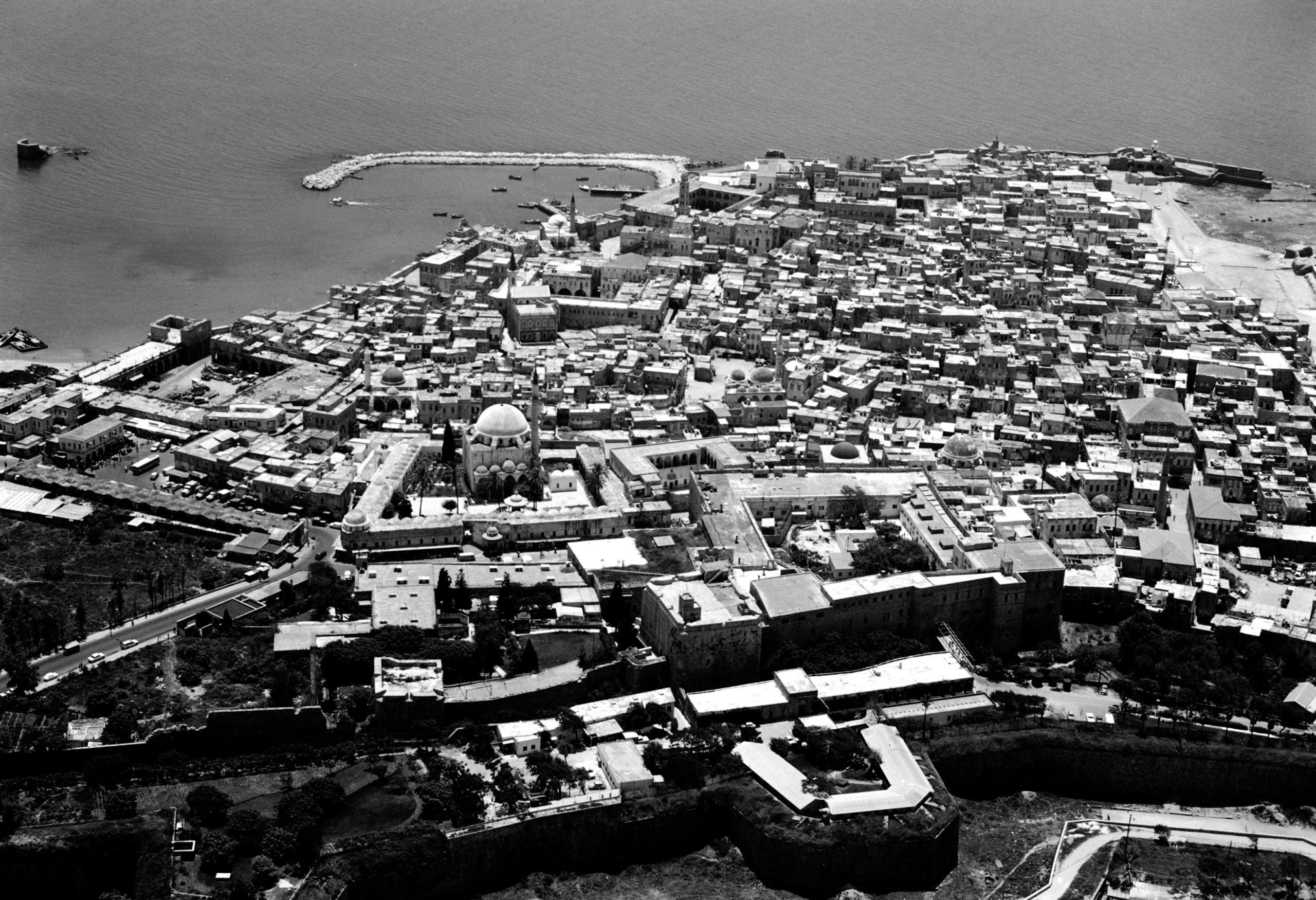
Aerial view of city of ‘Akká, May 1972. Source: Bahá'í Media Bank © Bahá'í International Community.
'Abdu'l-Bahá carried a staggering weight of responsibilities in 'Akká enabling Bahá'u'lláh to devote Himself completely to Revelation. 'Abdu'l-Bahá took on the leadership of the Bahá'í community, guiding its growth, and managed the increasing flow of pilgrims. In His bírúní, across the square from the house of ‘Abbúd, 'Abdu'l-Bahá met everyone in 'Akká, from Ottoman officials, to religious leaders and the destitute and suffering.
Bahá'u'lláh once stated that in Baghdád, He had met with believers and officials, and that, by contrast, in the Holy Land, He had “completely closed the door of association with the people.” Keenly aware of 'Abdu'l-Bahá’s protective role, Bahá'u'lláh stated His Son had made the sacrifice of taking “upon Himself this arduous task for Our comfort. He is a mighty shield facing the world and its peoples, and so He has relieved Us [from every care]” stating that 'Abdu'l-Bahá faced “every ordeal and suffering. Because to deal and associate with these people is the most arduous task of all.”
'Abdu'l-Bahá’s 24-year-old half-brother Muḥammad ‘Alí was deeply jealous of 'Abdu'l-Bahá’s exalted relationship with Bahá'u'lláh, and Bahá'u'lláh’s constant praise of His eldest Son. Remaining behind in 'Akká was also an attempt by 'Abdu'l-Bahá to lessen the fire of envy that burned in Muḥammad ‘Alí’s heart, but it was a forced separation from Bahá'u'lláh that caused both Father and Son pain, and Bahá'u'lláh wrote moving and tender Tablets to 'Abdu'l-Bahá, lovingly asking Him to come visit Him.
Adib Taherzadeh, The Revelation of Bahá'u'lláh Volume 4: Mazra’ih and Bahjí 1877-1892, pages 1-6.
Adib Taherzadeh, The Covenant of Bahá'u'lláh, Chapter 9: The Relationship of Bahá'u'lláh and Abdu'l-Bahá.
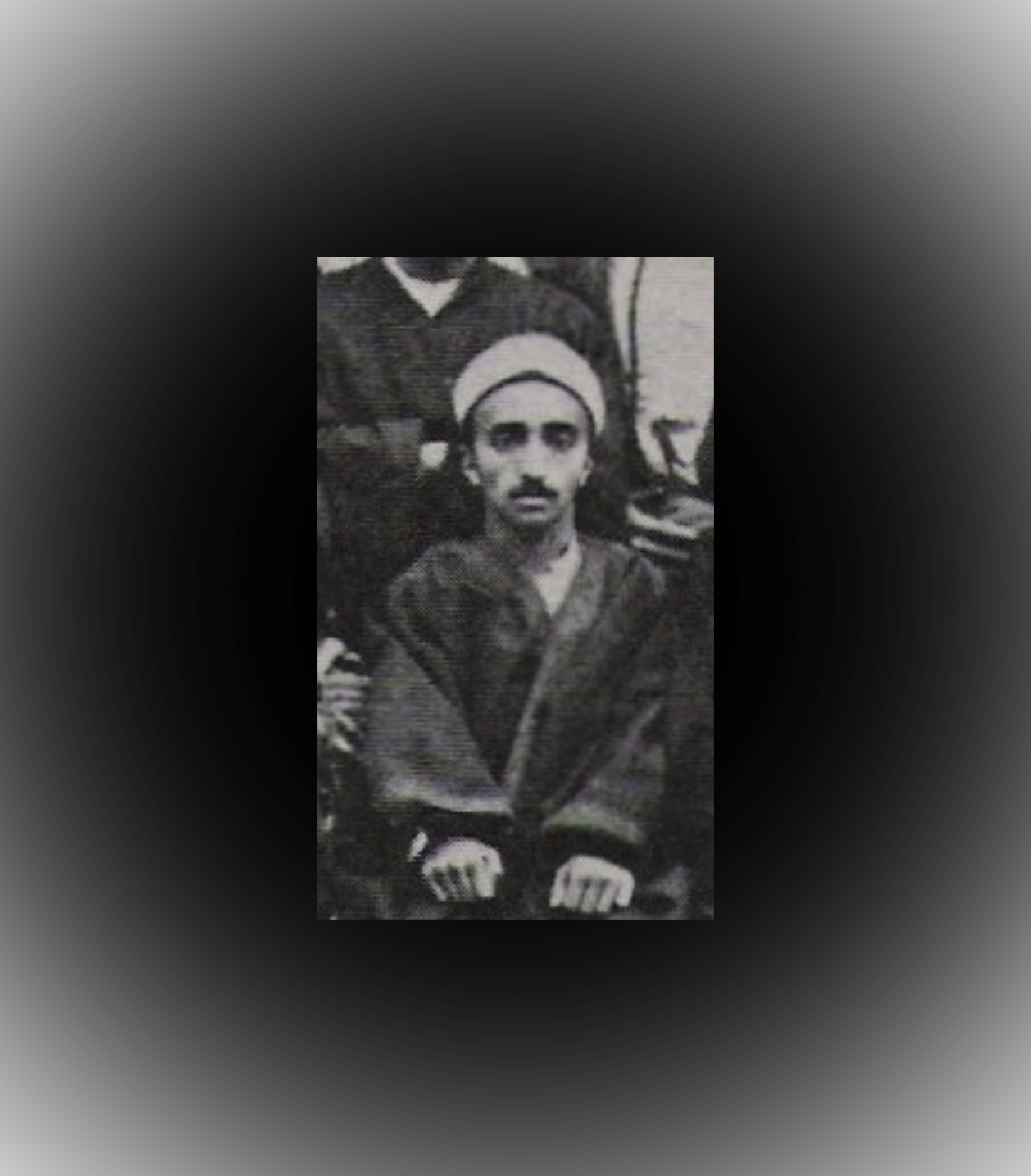
A photograph of Mírzá Muḥammad ‘Alí at the age of 16, around 1868 in Adrianople, ten years before the story recounted below. The other photos available of Muḥammad ‘Alí show him in middle age. Source: Wikimedia Commons.
After his teenage declaration of prophethood in Adrianople, Mírzá Muḥammad-'Alí continued on his path of ambition and sedition, and never followed 'Abdu'l-Bahá’s example of humility and servitude to Bahá'u'lláh. More than anything, he wanted to emerge from his relative obscurity and claim some sort of position for himself and began writing letters and sending them to Persia in secret. His behavior pained Bahá'u'lláh greatly but He concealed His sins.
The most perceptive and deepened Bahá'ís immediately felt his arrogance and superiority. When Ḥájí Muḥammad-Ṭáhir-i-Málmírí first met Muḥammad ‘Alí in Nabíl’s apartment in ‘Akká, he immediately became depressed and the joy in his heart turned to sadness and distress. He stayed in that gloomy and dispirited state until he met 'Abdu'l-Bahá later that day, and his heart filled with joy.
Adib Taherzadeh, The Revelation of Bahá'u'lláh Volume 1: Baghdád 1853 - 1863, pages 131-133.
Adib Taherzadeh, The Covenant of Bahá'u'lláh, Chapter 8: The Arch-breaker of Bahá'u'lláh's Covenant.
Ḥájí Mírzá Ḥayar-‘Alí, Stories from the Delight of Hearts, page 128.
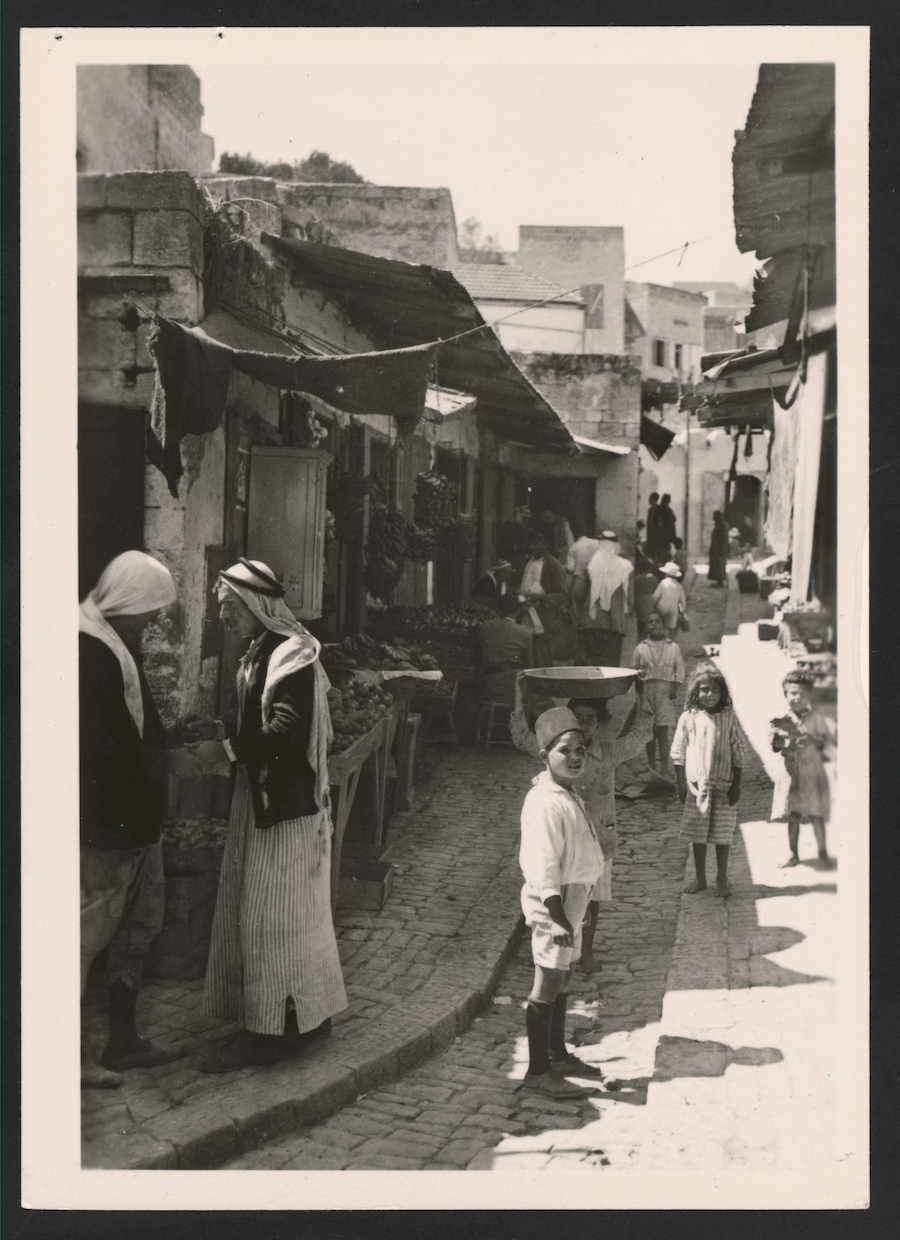
A photograph taken between 1934 and 1937 the Matson Photo Service showing a street in Old Nazareth and a vegetable market. No images could be found of the White Market in 'Akká. Source: Library of Congress.
On one of His visits to 'Akká, Bahá'u'lláh stayed for eight days and nine nights in the home of Mírzá Músá, situated near the entrance to the White Market. Every day of His stay, Bahá'u'lláh had allowed all the Bahá'ís to enter His presence, where they sat, spellbound by His utterances.
Bahá'u'lláh, during this momentous visit, had showered infinite bestowals on His faithful brother, Mírzá Músá, and offered a prayer that the believers' hearts would become illumined, their souls sanctified from attachment to all save Him and their steps made firm, so that they would remain steadfast as they arose to serve His Cause.
‘Adib Taherzadeh, The Revelation of Bahá'u'lláh Volume 4: Mazra’ih and Bahjí 1877-1892, pages 242-243.
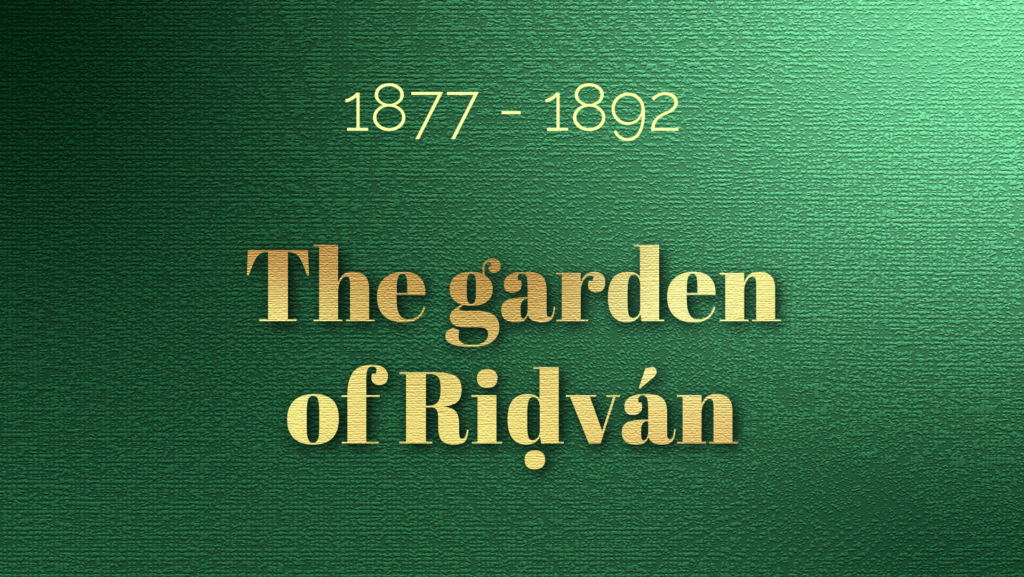
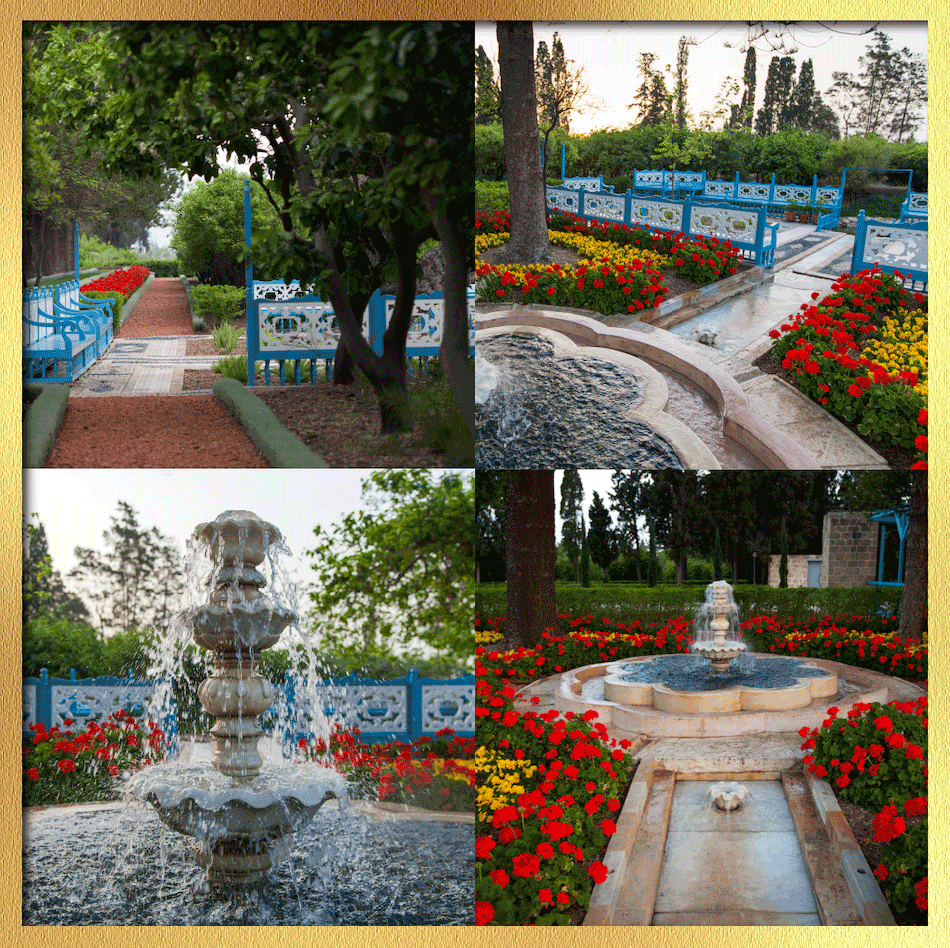
Four photographs of the Riḍván garden in all its colorful splendor. Source: Bahá'í Media Bank © Bahá'í International Community.
The garden of Riḍván was a small green island, in the middle of the little Na’mayn river, one kilometer (0.6 miles) east of ‘Akká. On either side of the garden, the river was 4 meters (14-15 feet) wide and one meter (three feet) deep, bordered with weeping willows, with countless fish speeding around.
In the time of Bahá'u'lláh the garden was laid out in flower-beds filled with countless flowers of every color and sweet-smelling herbs, and decorated with many flowering bushes and fruit trees. There was a splashing fountain distributing water to the entire garden, rippling as it flowed over a stone platform under two large mulberry trees, benches nestled around their trunks.
The Riḍván garden blazed with colors and scents, filled with a delightful, heavenly atmosphere: elegant pomegranate trees and their large scarlet flowers, blossoming shrubs, the intermingled scent of roses, bergamot, mint, thyme and lemon-scented verbena perfuming the air and mixing with the earthy scent of white, red, and pink geraniums.
It became one of Bahá'u'lláh’s most favorite retreats during His years in Mazra’ih and Bahjí, and He called the garden of Riḍván the “New Jerusalem” and “Our Verdant Isle,” and frequently said to His gardener, Abu'l-Qásim, “This is the most beautiful garden in the world.”
The garden of Riḍván was a symbol of devotion and sacrifice, as most of the flowers and shrubs had been carried on foot from Persia by pilgrims. Bahá'u'lláh’s old gardeners from His home in Ṭihrán remembered His favorite flower had been a rare white rose with a golden center, brownish stalks and shiny leaves, and the most delightful fragrance, and over time, many bushes of Bahá'u'lláh’s favorite rose flowered in the garden of Riḍván, the cream and gold of the flowers and their burnished leaves creating a peaceful note of harmony in the garden.
Shoghi Effendi, God Passes By.
David S. Ruhe, Door of Hope: The Bahá’í Faith in the Holy Land, pages 91-92.
Lady Blomfield, The Chosen Highway, pages 97-98.
Adib Taherzadeh, The Revelation of Bahá'u'lláh Volume 4: Mazra’ih and Bahjí 1877-1892, pages 11-12 and 29.
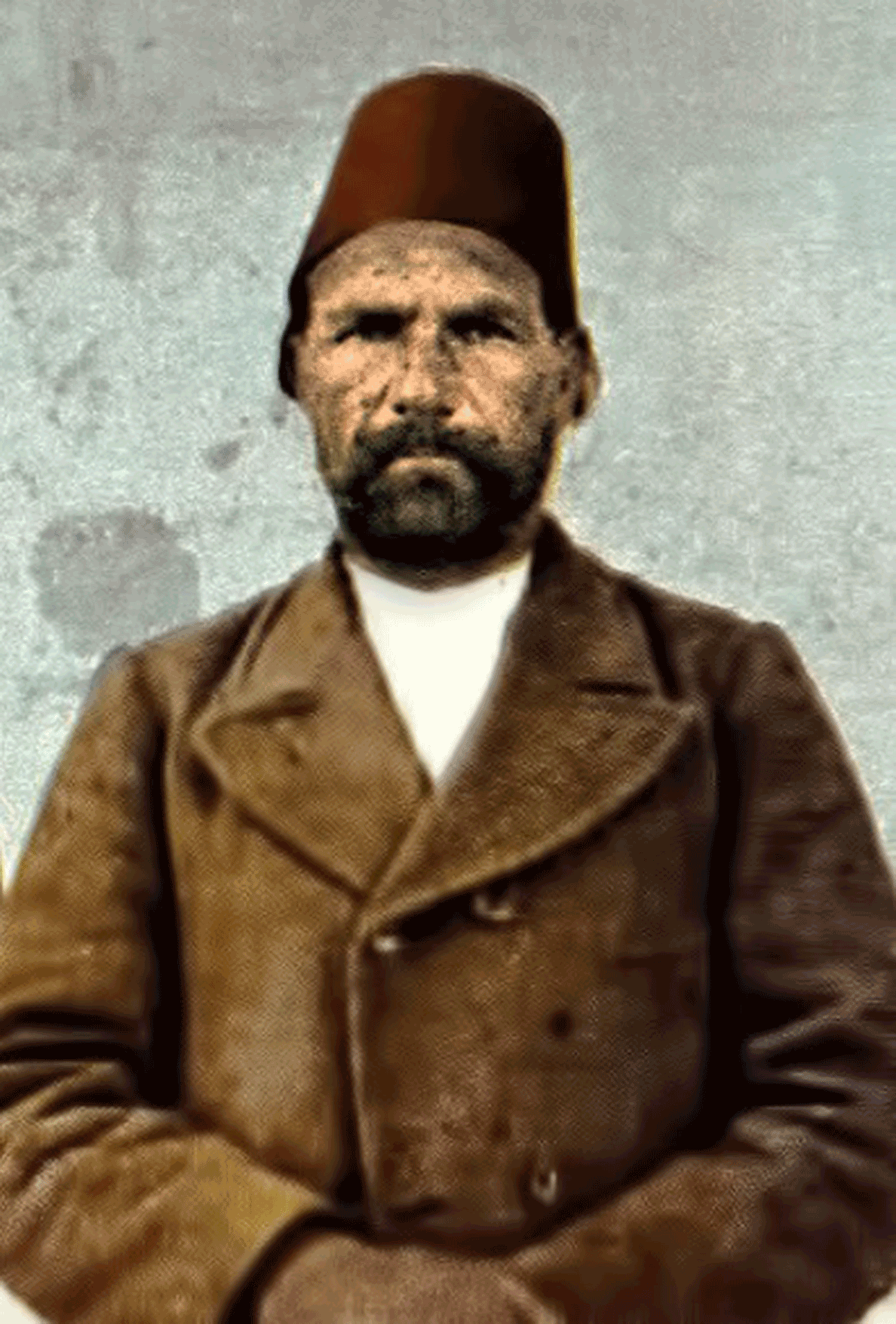
‘Abu’l-Qásim Manshádí, from the village of Manshád, in the district of Yazd, who worked in Riḍván for many years from the time of Bahá’u’lláh - see attached photograph taken around 1900, from the book Views of Acca, Haifa, Mt. Carmel and other places, The Behais Supply and Publishing Board of Chicago, Chicago, 1912. No images were found for ‘Abdu’ṣ-Ṣáliḥ or Áqá Muḥammad-Ibráhím, Abu'l-Qásim’s brother. Many thanks to Andrew Blake for providing the image and its caption.
The Bahá'í gardeners, closely guided and supervised by 'Abdu'l-Bahá, transformed the garden into a paradise of beauty, fragrance, color, and harmony through dedication and hard work, bringing in large quantities of soil from the surrounding areas for the flower-beds. In some of His Tablets, Bahá'u'lláh speaks about the flowers and plants of the Riḍván garden and expresses warm appreciation for the gardeners’ devotion.
‘Abdu’ṣ-Ṣáliḥ was a loyal, steadfast, and humble man who often attained the presence of Bahá'u'lláh and earned the bounty of His good-pleasure. After he passed away, Bahá'u'lláh revealed a Tablet of Visitation in his honor and delivered a eulogy for him that was later published.
Abu'l-Qásim, a massive, strong, broad-shouldered man was the first gardener to dedicate his life to serving Bahá'u'lláh in the Riḍván garden, and it was chiefly through his tireless efforts that the garden was built. He welcomed Bahá'í pilgrims and residents to the garden, lovingly entertaining them and ensuring they enjoyed their visit. He also protected his beloved garden from the masses of 'Akká residence who wanted to come in and would have trampled his flower beds. Áqá Muḥammad-Ibráhím was Abu'l-Qásim's brother and he served as a gardener at Bahjí and other places. Both brothers served in the gardens of Mazra’ih, Bahjí, Riḍván, and Junayn and others, for more than three decades.
Adib Taherzadeh, The Revelation of Bahá'u'lláh Volume 4: Mazra’ih and Bahjí 1877-1892, pages 11-12 and 28-32.
'Abdu'l-Bahá, Memorials of the Faithful: ‘Abdu’ṣ-Ṣáliḥ, the gardener.
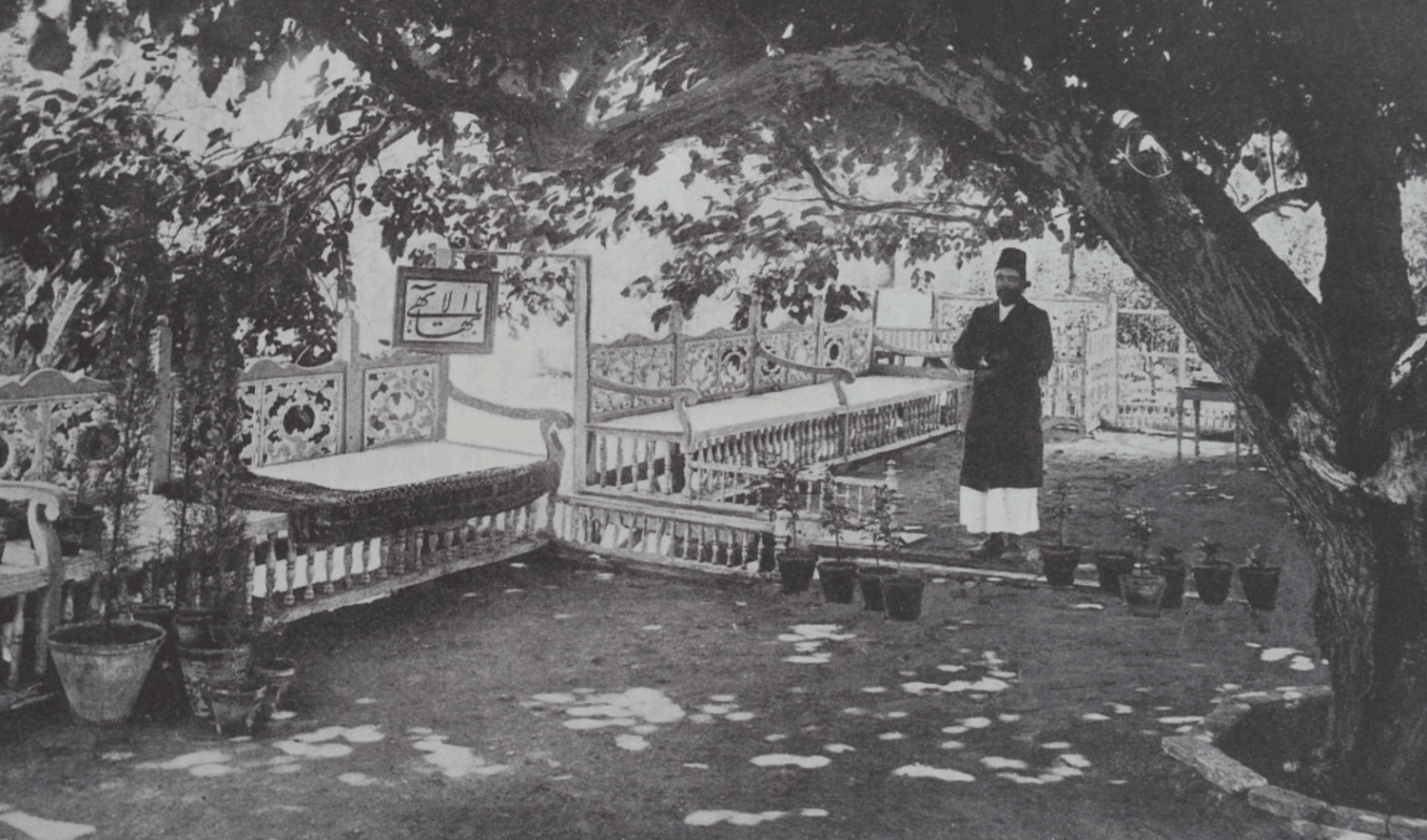
Abu'l-Qásim, Bahá'u'lláh’s gardener, standing in the garden of Riḍván and looking at the mulberry trees, something he does in the story below about locusts eating Bahá'u'lláh’s beloved mulberry trees. Source: Reflections on the Bahá'í Writings.
One day during a hot summer, a plague of locusts descended on the countryside outside of 'Akká, and began devouring the leaves of Bahá'u'lláh’s shady mulberry trees. ‘Abu’l-Qásim ran to the little house at the end of the garden and informed Bahá'u'lláh: “My Lord, the locusts have come, and are eating away the shade from above Thy blessed head. I beg of Thee to cause them to depart,” but Bahá'u'lláh merely smiled and said: “The locusts must be fed, let them be.”
Distressed, ‘Abu'l-Qásim returned to watch the locusts eat his garden in silence. No longer able to bear the destruction, he returned to Bahá'u'lláh and begged Him to send the locusts away. Bahá'u'lláh went into the garden, and standing beneath the locust-covered mulberry trees, addressed the ravenous insects, saying: “Abu'l-Qásim does not want you; God protect you,” then shook the hem of His robe, and instantly, the locusts flew away as one. They were gone.
When Abu’l-Qásim recounted this story to May Bolles, he was so overcome with emotion that he touched his eyes, saying “Oh, blessed are these eyes to have seen such things; oh, blessed are these ears to have heard such things.”
Adib Taherzadeh, The Revelation of Bahá'u'lláh Volume 4: Mazra’ih and Bahjí 1877-1892, pages 28-32
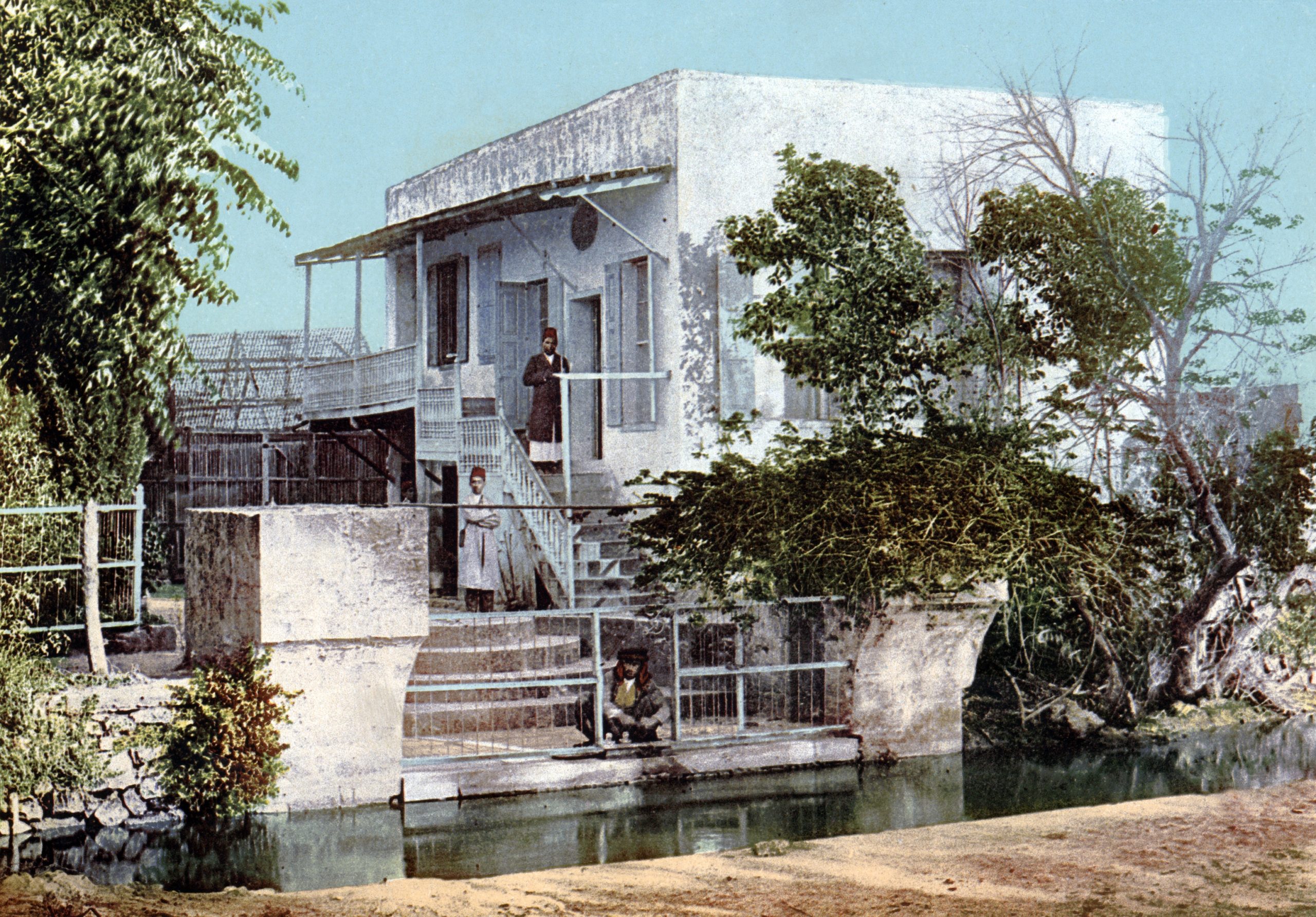
The little one-room house in the garden of Riḍván, where Bahá'u'lláh could rest and where He revealed Tablets. Source: Bahá'í Media Bank © Bahá'í International Community.
Bahá'u'lláh revealed a touching Tablet, which now hangs in the small house in the Riḍván garden, where He expresses His enjoyment of the serenity, peace, and the spiritual feeling pervading the garden: “On the morning of the blessed Friday we proceeded from the Mansion and entered the Garden. Every tree uttered a word, and every leaf sang a melody. The trees proclaimed: 'Behold the evidences of God's Mercy' and the twin streams recited in the eloquent tongue the sacred verse 'From us all things were made alive.’”
In 1879, Bahá'u'lláh revealed a significant and celebrated passage on trustworthiness in which He describes His vision of the Maid of Heaven appearing in the garden of Riḍván, standing on a pillar of light and calling out loudly to all the inhabitants of heaven and earth, extolling trustworthiness in the most exalted terms. So important is this passage that Bahá'u'lláh included it word for word in three other Tablets: Ishráqát, Ṭarázát, and a Tablet revealed in honour of Ḥájí Mírzá Buzurg-i-Afnán, the custodian of the Báb’s House in Shíráz.
This passage is also memorable for Bahá'u'lláh’s vivid description of the Riḍván garden, His “Green Island,” with its flowing streams and sunlight-dappled lush green trees:
“We will now mention unto thee Trustworthiness and the station thereof in the estimation of God, thy Lord, the Lord of the Mighty Throne. One day of days We repaired unto Our Green Island. Upon Our arrival, We beheld its streams flowing, and its trees luxuriant, and the sunlight playing in their midst. Turning Our face to the right, We beheld what the pen is powerless to describe; nor can it set forth that which the eye of the Lord of Mankind witnessed in that most sanctified, that most sublime, that blest, and most exalted Spot. Turning, then, to the left We gazed on one of the Beauties of the Most Sublime Paradise, standing on a pillar of light, and calling aloud saying: ‘O inmates of earth and heaven! Behold ye My beauty, and My radiance, and My revelation, and My effulgence. By God, the True One! I am Trustworthiness and the revelation thereof, and the beauty thereof. I will recompense whosoever will cleave unto Me, and recognize My rank and station, and hold fast unto My hem. I am the most great ornament of the people of Bahá, and the vesture of glory unto all who are in the kingdom of creation. I am the supreme instrument for the prosperity of the world, and the horizon of assurance unto all beings.’”
Partial Inventory ID: BH03509
Adib Taherzadeh, The Revelation of Bahá'u'lláh Volume 4: Mazra’ih and Bahjí 1877-1892, pages 15-22.
Bahá'u'lláh, Ishráqát (Splendours).
Bahá'u'lláh, Ṭarázát (Ornaments).
DATE
In a Tablet to Hájí Amín, Bahá'u'lláh indicates that a Tablet of Trustworthiness had been revealed in AH 1296 (around An 1879), note in Adib Taherzadeh, The Revelation of Bahá'u'lláh Volume 4: Mazra’ih and Bahjí 1877-1892, pages 16.
“Greetings and salutations rest upon this Mansion which increaseth in splendour through the passage of time.”
Bahá’u’lláh, The Hidden Words, From the Persian
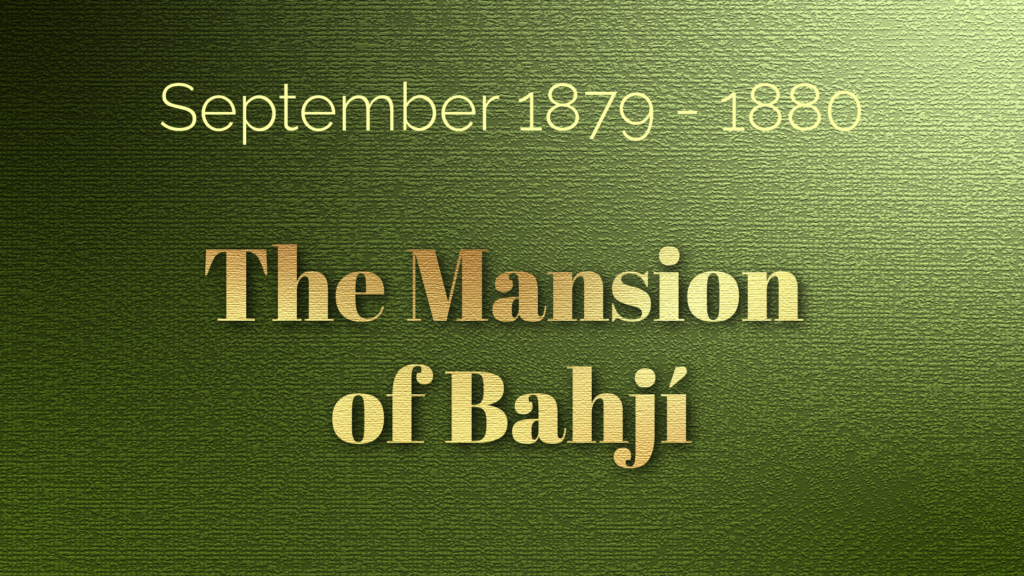
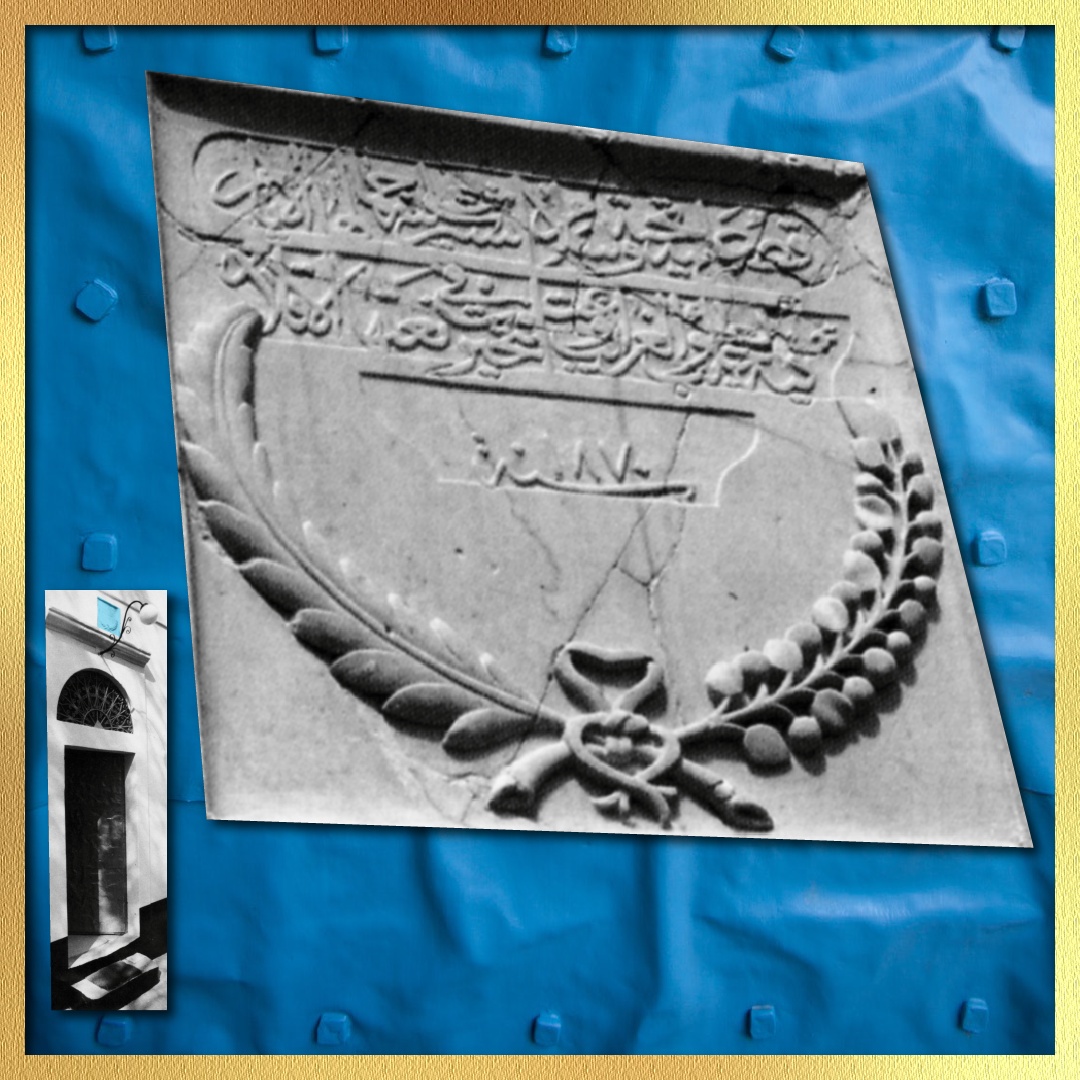
Large photograph: Close up of the stone-engraved inscription placed by 'Udi Khammár above the entrance door to Bahjí. Small photograph: Entrance door to the Mansion of Bahjí. The blue-colored box above the door indicates the placement of the stone inscription. George Ronald: photographs provided courtesy of George Ronald Publishers and used with permission. Background: Closeup of the door to the Mansion of Bahjí. Source: Bahá'í Media Bank © Bahá'í International Community.
The humid and swampy region of ‘Akká often fell prey to epidemics of typhoid, dysentery, and malaria, and an epidemic of plague broke out in the countryside in the summer of 1879. All the inhabitants who could hastily fled the center of the epidemic, including ‘Údí Khammár and his family, who abandoned his beautiful, palatial Mansion. Soon after, 'Abdu'l-Bahá was able to rent the Mansion for a very low price, and later purchased it.
‘Údí Khammár died later in 1879, and was buried in a room of the eastern housing complex in Bahjí, at the southeast corner of the Mansion wall. Bahá'u'lláh stated that 'Údí Khammár had not known, while he built and lived in the Mansion of Bahjí for Whom it had been intended, and affirmed the Mansion had been erected to serve as the scene of His transcendent glory, to be the Seat of God in His Day.
‘Údí Khammár had been inspired, while he was building the Mansion, to engrave an Arabic phrase above the door which read: “Greetings and salutations rest upon this Mansion which increaseth in splendour through the passage of time. Manifold wonders and marvels are found therein, and pens are baffled in attempting to describe them.” Once Bahá'u'lláh moved into the Mansion of Bahjí, these prophetic words would be fulfilled time and again.
David S. Ruhe, Door of Hope: The Bahá’í Faith in the Holy Land, pages 87 and 101-108, and 205.
Adib Taherzadeh, The Revelation of Bahá'u'lláh Volume 4: Mazra’ih and Bahjí 1877-1892, pages 103-104.
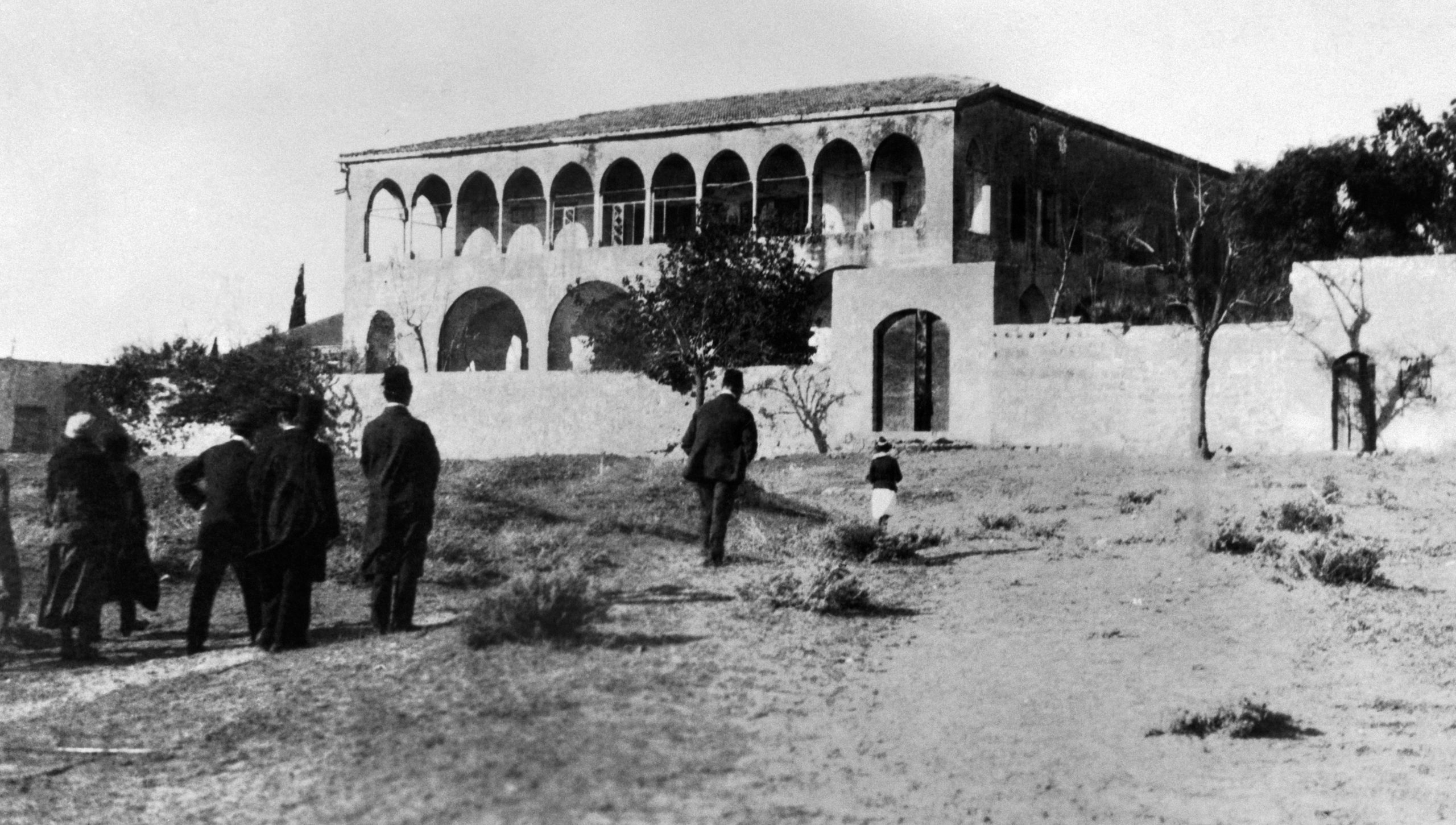
In a visual reference to the crowd of the Concourse on High that welcomed Bahá'u'lláh to the Mansion of Bahjí in the story below, the reverence of early pilgrims and local Bahá'ís, approaching the Mansion prayerfully in 1919, 40 years after Bahá'u'lláh’s arrival. Source: Bahá'í Media Bank © Bahá'í International Community.
After renting the Mansion, 'Abdu'l-Bahá prepared it for Bahá'u'lláh, and members of His extended family began moving in. When preparations were completed, Bahá'u'lláh left the house of ‘Abbúd, where He had been staying, about two hours after sunset on a September evening of 1879, and, accompanied by Mírzá Áqá Ján, rode His white donkey to Bahjí, His new home, for the first time.
Nabíl and Ḥájí Muḥammad-Ṭáhir-i-Málmírí saw Bahá'u'lláh pass in the street below the windows of their rooms in the White Market, and decided to follow Him to Bahjí and offer prayers on this auspicious day, then circumambulate around the Mansion, and return to 'Akká. They ran down the steps and followed Bahá'u'lláh, fifty steps behind. When they arrived, Bahá'u'lláh entered the Mansion, lit by a single, large, three-wicked oil lamp.
In order to circumambulate, Ḥájí Muḥammad and Nabíl approached the Mansion but found themselves faced with a packed crowd, assembled around the footpath on the four sides of the building. They could hear breathing and murmuring, but they soon realized the crowd was not made of physical beings but rather a vision they had received of the souls of all the Prophets, Messengers of God, and the Concourse on high assembled outside the Mansion, circumambulating the throne of their Lord and welcoming Bahá'u'lláh home.
They walked thirty steps away from the Mansion and circumambulated in a muddy field, still feeling the presence of the holy crowd, then prostrated themselves on the ground in front of the Mansion’s gate, and returned to 'Akká. On their way back, they were caught in a torrential rain and arrived four hours after sunset, right before the Ottoman guards locked the city gate for the night.
After this mystical experience, Nabíl suggested they hold a vigil, and Ḥájí Muḥammad made tea while Nabíl composed poems. By sunrise, he had covered both sides of a large sheet of paper in poems, which the two friends sent to Bahá'u'lláh as a gift, along with two sugar cones. When Bahá'u'lláh received their gift, He revealed a Tablet in their honor accepting their pilgrimage to the Mansion, and gave Nabíl the title of Bulbul (Nightingale) and Ḥájí Muḥammad-Ṭáhir-i-Málmírí the title of Bahháj (the Blissful).
Adib Taherzadeh, The Revelation of Bahá'u'lláh Volume 4: Mazra’ih and Bahjí 1877-1892, pages 105-114.
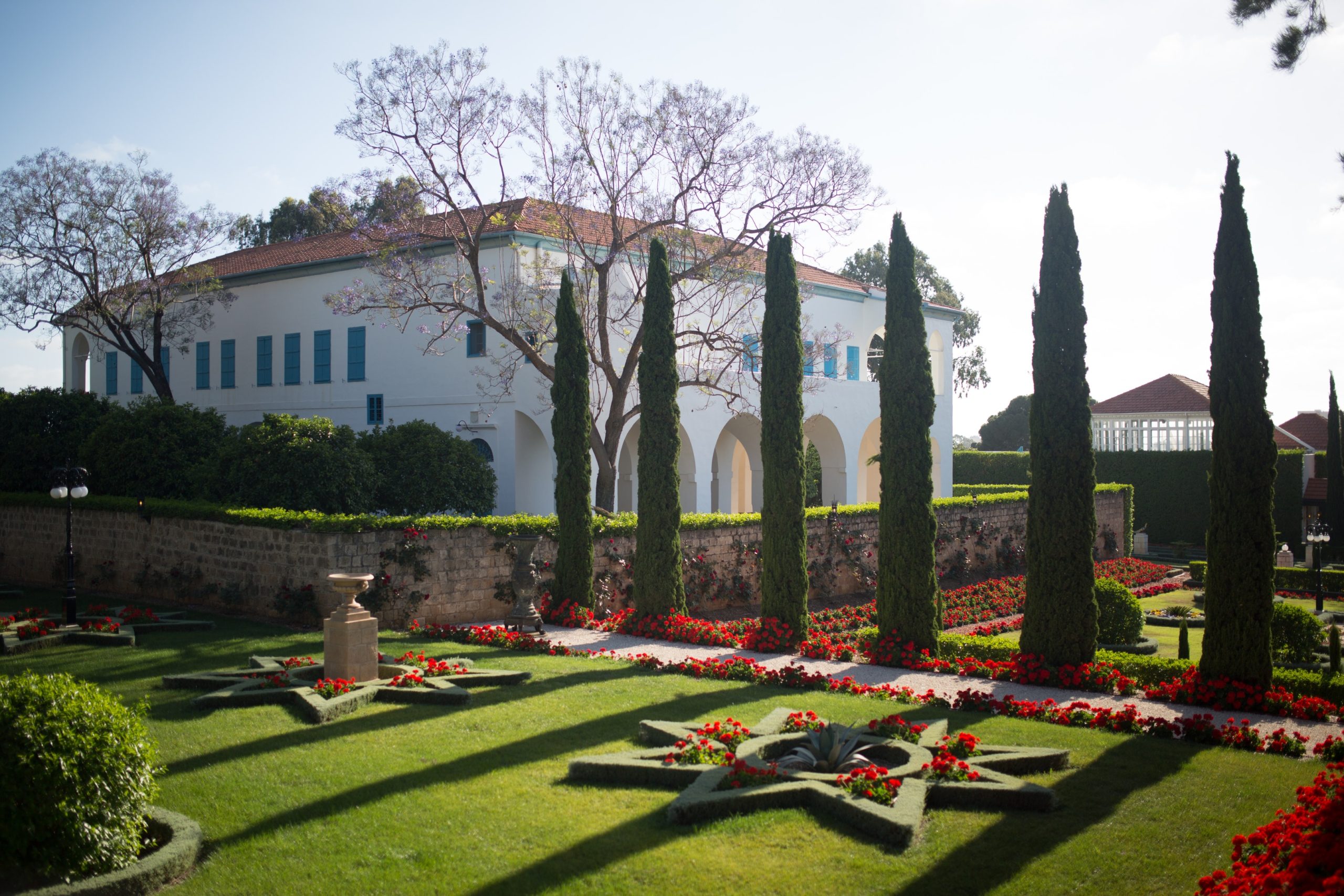
The Mansion of Bahjí and its surrounding gardens. Source: Bahá'í Media Bank © Bahá'í International Community.
‘Údí Khammár had built a true palace. The Mansion of Bahjí was spacious, richly designed, well-equipped, surrounded by a delightful grove of fragrant lemon and orange trees, and a large, beautiful pond. Beyond the Mansion, the large garden was surrounded by a high wall, and it was closer to 'Akká than Mazra’ih, only 3,5 kilometers (2 miles) to the northeast.
In one of His Tablets, Bahá'u'lláh describes the Mansion of Bahjí as the scene of His transcendent glory, asserting it was built in order to be the Seat of God in His Day,
The Mansion itself was particularly charming, with its wraparound covered stone balcony and painted frescoes, surrounded by open fields and shady pine trees. From Bahjí, one could see the high minarets of the mosques of ‘Akká, the bright blue waters of the Mediterranean, and, across the bay, the dim outline of Mount Carmel in Haifa, 17 kilometers (10.5 miles) away, but it was far enough away from 'Akká to be protected from its hectic energy and gloomy atmosphere. Bahá'u'lláh would spend the next 13 years in Bahjí, except when spending His winters in 'Akká with Ásíyih Khánum and the rest of the Holy Family.
After a quarter of a century spent in poverty and hardship, Bahá'u'lláh, now 62, would spend the last decade of His ministry setting the example for how to befittingly glorify God in the management of His newfound affluence, frugal for Himself, and wise in His investments for the expansion and propagation of the Faith. Bahá'u'lláh’s life in Bahjí could be adequately described as regal, but never luxurious, befitting of a Manifestation of God, but never extravagant. Bahá'u'lláh and the Holy Family always lived simply, and modestly, never wasting money on selfish luxuries.
Shoghi Effendi, God Passes By.
H.M. Balyuzi, Bahá'u'lláh: The King of Glory, pages 362-363.
Adib Taherzadeh, The Revelation of Bahá'u'lláh Volume 4: Mazra’ih and Bahjí 1877-1892, pages 104-105.
David S. Ruhe, Door of Hope: The Bahá’í Faith in the Holy Land, pages 101-102.
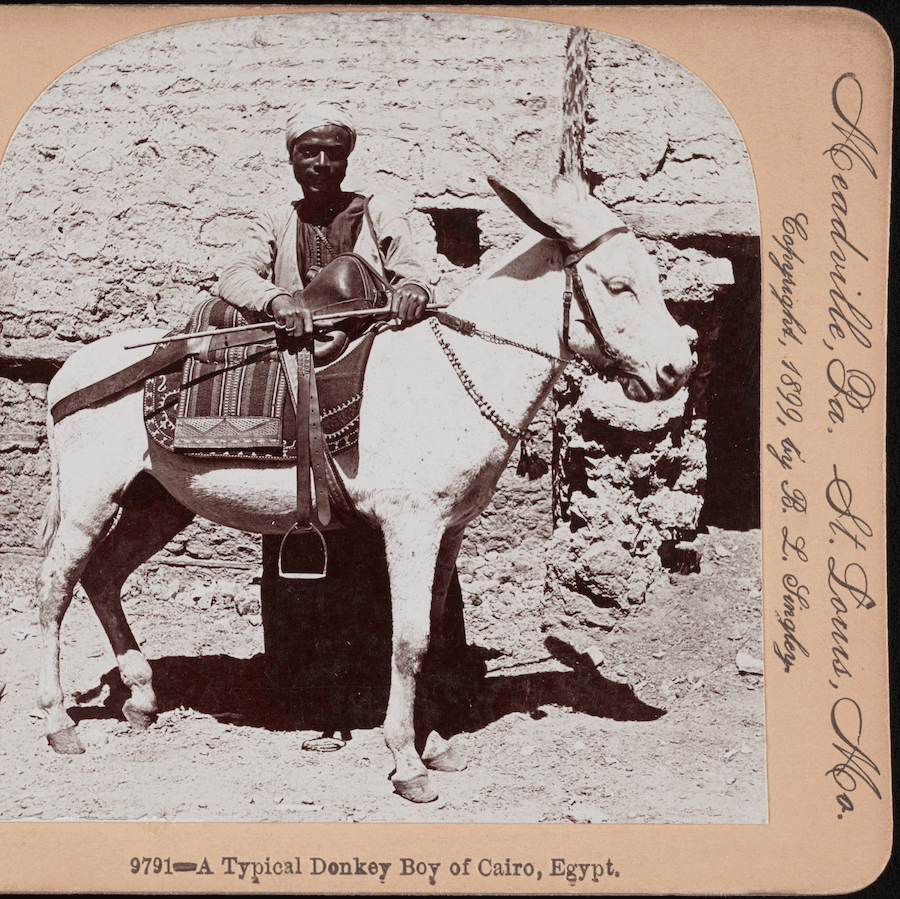
In homage to Lightning and Thunder, Bahá'u'lláh’s white donkeys, a beautiful white donkey in Cairo, Egypt in 1899. Photograph by Keystone View Company. Library of Congress.
Bahá'u'lláh used to ride a white donkey named Barq (Lightning), to move about the countryside of 'Akká freely. His donkey earned its charming name because he was fast as lightning. When Bahá'u'lláh rode His white donkey in the surrounding area, He was always accompanied by a servant. When Barq died, the Persian Bahá'ís sent Bahá'u'lláh another donkey, whom Bahá'u'lláh named Ra’d (Thunder).
In this way, Bahá'u'lláh was able to freely explore the countryside around Bahjí, visiting nearby gardens, Riḍván, Bustan-i-Kabir, Junaynih, Firdaws, and Ashraf but also further afield, visiting nearby Druze villages such as Yirkíh, and Abú-Sinán, and sites closer to ‘Akká, such as the Tall-i-Fakhkhar (Napoleon’s Hill, also known as the Tell of ‘Akká), a hill named Sarmaríyyih (also known as Buq’atu’l-Hamra), covered in red poppies and anemones.
Bahá'u'lláh frequently visited ‘Akká, where people now reverently bowed whenever He appeared in public. During His stays in 'Akká, Bahá'u'lláh allowed all the believers to enter His presence, where they sat, spellbound by His utterances and exhilarated by the outpouring of His favors. On His visits to the prison-city, Bahá'u'lláh generally stayed in His beautiful sea-facing room at the house of ‘Abbúd, but He also stayed in the home of Mírzá Músá, who lived near the White Market, and visited His brother Mírzá Muḥammad-Qulí, close to Khán-i-Shávirdí.
Adib Taherzadeh, The Revelation of Bahá'u'lláh Volume 4: Mazra’ih and Bahjí 1877-1892, pages 104-105 and 242-243.
H.M. Balyuzi, Bahá'u'lláh: The King of Glory, pages 363-364.
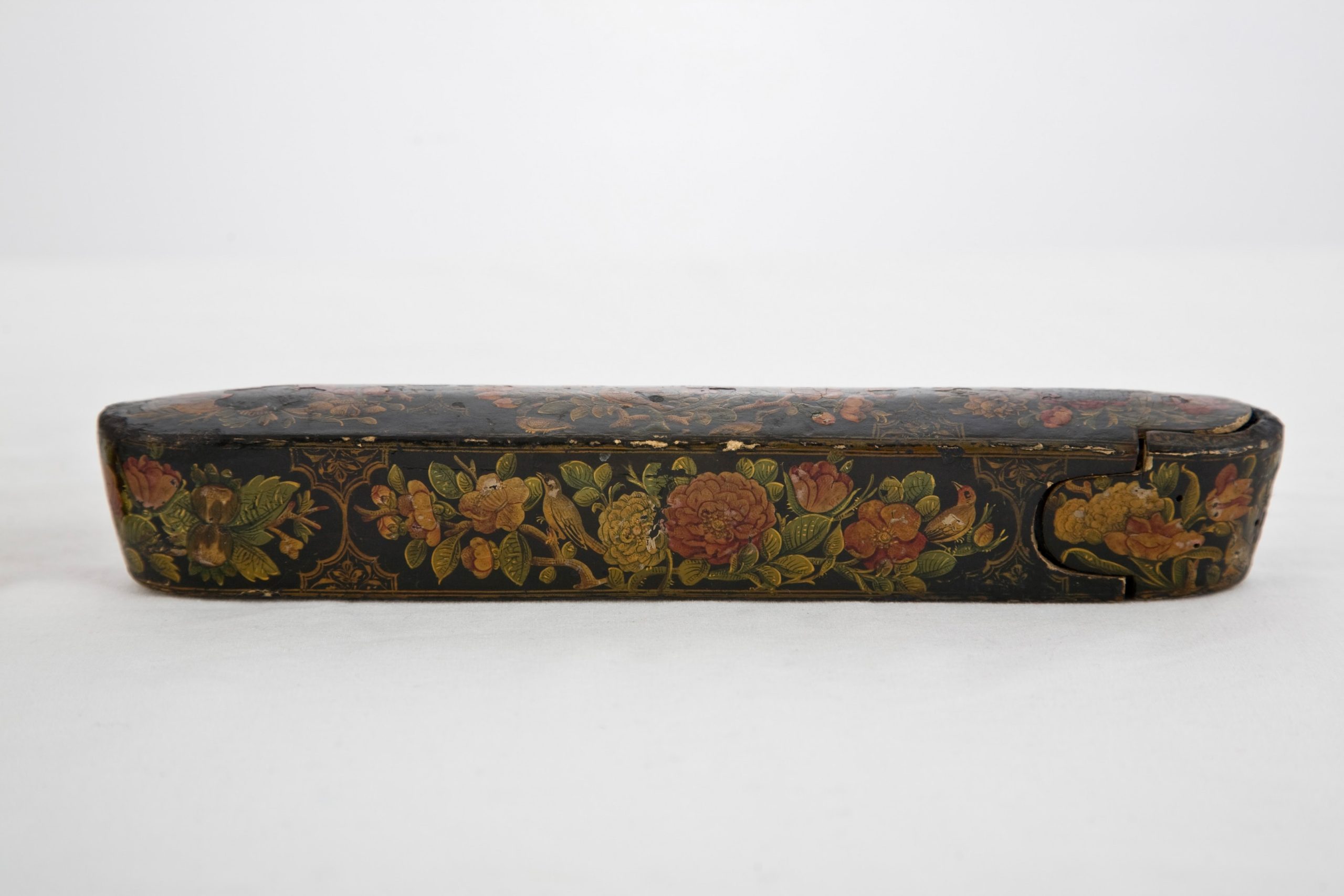
A photograph of one of Bahá'u'lláh’s pencases from the International Bahá'í Archives, as an illustration for one of the stories below in which Bahá'u'lláh gives Ḥájí Mírzá Buzurg a pen case made in Iṣfahán. Source: Bahá'í Media Bank © Bahá'í International Community.
Bahá'u'lláh was deeply attentionate to all those around Him, showering them with His caring generosity. One day, a Bahá'í named Mírzá Muḥammad-Qulí, offered Bahá'u'lláh an overcoat, and Bahá'u'lláh was so thoughtful as to write him a Tablet telling him He had worn the coat one day as a bounty on His part.
Ḥájí Muḥammad ‘Alíy-i-Afnán, a cousin of the Báb, sent Bahá'u'lláh a length of white flannel, and Bahá'u'lláh thanked Him in a Tablet, explaining that, although He had been used to wearing black flannel coats since He left Baghdád, He had ordered a white one to be made, as a token of His grace and favors towards the Afnán.
Bahá'u'lláh often ordered little gifts to be sent to people, a set of dishes to Ḥájí Muḥammad ‘Alíy-i-Afnán, or spectacles and cases as a gift to some Ottoman officials.
One day Bahá'u'lláh instructed Ḥájí Mírzá Buzurg to copy the Qaṣídiy-i-Varqá’íyyih (The Ode of the Dove), which Bahá'u'lláh had revealed in Sulaymáníyyih and offered him a pen case made in Iṣfahán, which was later placed in the archives of the house of the Báb in Shíráz.
Another time, Bahá'u'lláh summoned Ḥájí Mírzá Ḥabíbu'lláh Afnán and spoke to him about his studies, then gave him a precious bottle of rosewater from Qamṣar, in Kashán, which had taken 40 days to reach the Holy Land, and told the young man “God has created this rosewater for such a day as this, which is the Lord of days.”
Bahá'u'lláh Himself had few personal needs, which He tended to modestly. When He needed a new pair of shoes, for example, He gave Ḥájí ‘Alíy-i-Yazdí, who was going to Constantinople, an old pair of slippers for size.
Adib Taherzadeh, The Revelation of Bahá'u'lláh Volume 4: Mazra’ih and Bahjí 1877-1892, pages 247-248.
H.M. Balyuzi, Bahá'u'lláh: The King of Glory, page 411.
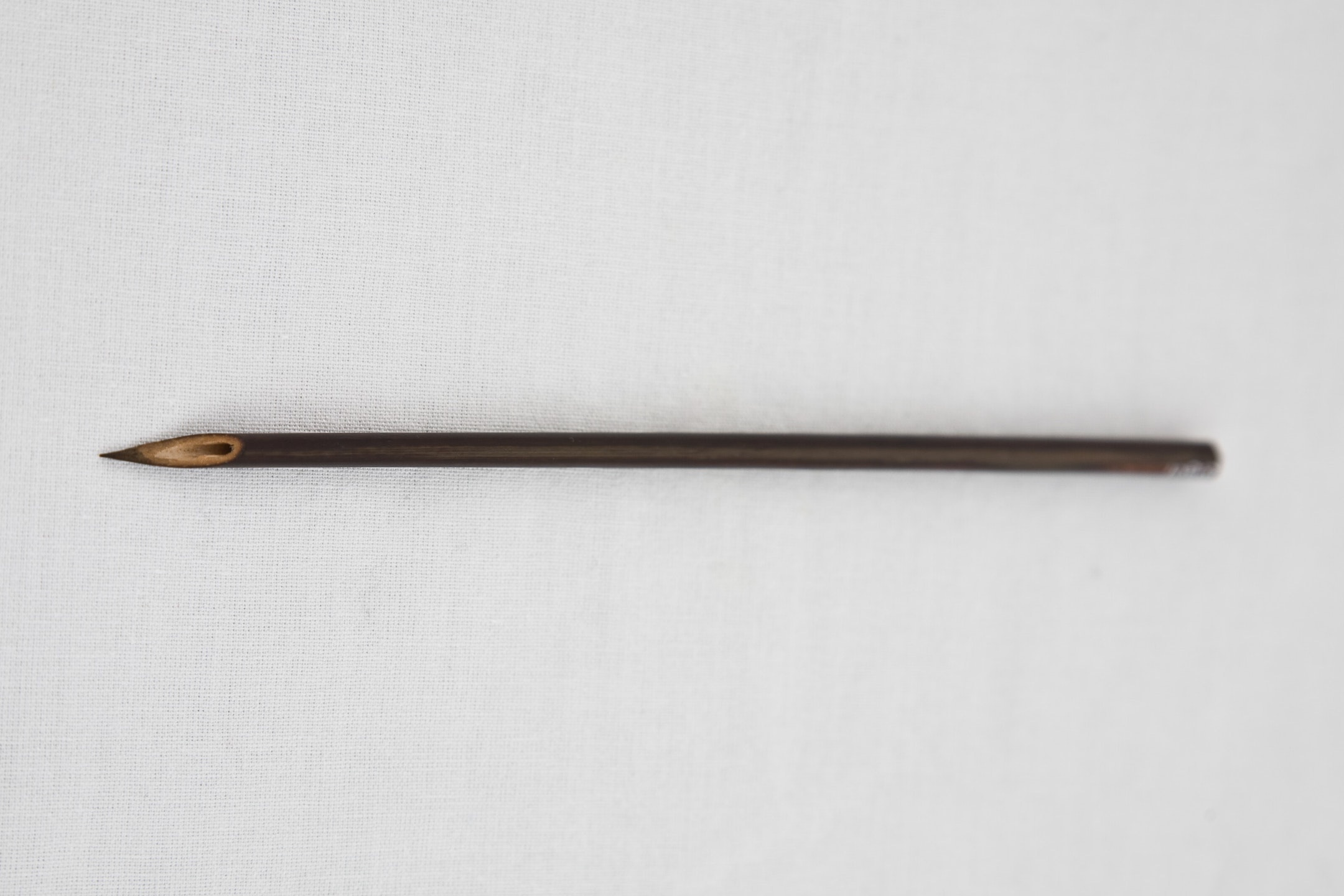
A cut reed pen which belonged to Bahá'u'lláh, from the International Bahá'í Archives as an illustration of the story below about Mírzá Áqá Ján’s reed pens and his transcription of the torrential downpour of Bahá'u'lláh’s sublime Revelation. Source: Bahá'í Media Bank © Bahá'í International Community.
The incoming letters addressed to Bahá'u'lláh were received by Mírzá Áqá Ján, who would read them to Bahá'u'lláh, after having obtained His permission. Once he had read the letter, Bahá'u'lláh would dictate the reply, entering the state of Revelation without marking a pause, and needing no time to compose the reply, think, or contemplate.
After 26 years as His amanuensis, Mírzá Áqá Ján was always well-prepared. Before him, on his writing desk was a large ink-pot the size of a small bowl, ten to twelve reed pens, and thick stacks of paper in large sheets. Reed pens, still in use today, were inexpensive and highly efficient pens for writing Arabic and Persian. Reed pens, or qalams, were simple but effective, carved from a single piece of wood, and they allowed Mírzá Áqá Ján to take dictation at lightning speed.
Bahá'u'lláh often paced the room while Revealing, Holy Verses flowing from His lips at incredible speed while Mírzá Áqá Ján transcribed His utterances in a shorthand of his own invention. Because qalams were wooden and hollow, they made a distinctive shrill sound while Mírzá Áqá Ján was writing that could be heard twenty paces away. In some of His Tablets, Bahá'u'lláh makes reference to “the shrill of the Pen of Glory.”
Bahá'u'lláh Revealed with such speed, transcribed by Mírzá Áqá Ján with matching swiftness, that the ink of the first word was often still wet when Mírzá Áqá Ján had covered the page and started on the next one. Mírzá Áqá Ján sometimes wrote so quickly that the qalam would fly out of his hands, and he would immediately reach for another one. There were times when he could not keep up, and would simply tell Bahá'u'lláh, "I am incapable of writing." In those moments, Bahá'u'lláh would turn to him and ask him what the last thing he wrote had been, then re- Revealed from that point forward.
Mírzá Áqá Ján’s “Revelation Writing,” his personal shorthand to transcribe Bahá'u'lláh’s Revelation was illegible to anyone else. No word was written clearly or in full, and the pages looked less like Arabic handwriting than fine hairs, dropped gently on the page. Once Revelation had stopped, Mírzá Áqá Ján recopied his transcription in his best handwriting and sent it off to its destination, but he sometimes could not read his own handwriting, and had to ask Bahá'u'lláh’s help in deciphering it.
Divine Revelation was an irrepressible torrent flowing through Bahá'u'lláh, and, in His own words, He testified: “This thing is not from Me, but from One Who is Almighty and All-Knowing.”
Adib Taherzadeh, The Revelation of Bahá'u'lláh Volume 1: Baghdád 1853 - 1863, pages 35-36 and 412-413.
Bahá'u'lláh, quoted in Shoghi Effendi, The Promised Day is Come for “the shrill of the Pen of Glory.”
Bahá'u'lláh, Epistle to the Son of the Wolf.
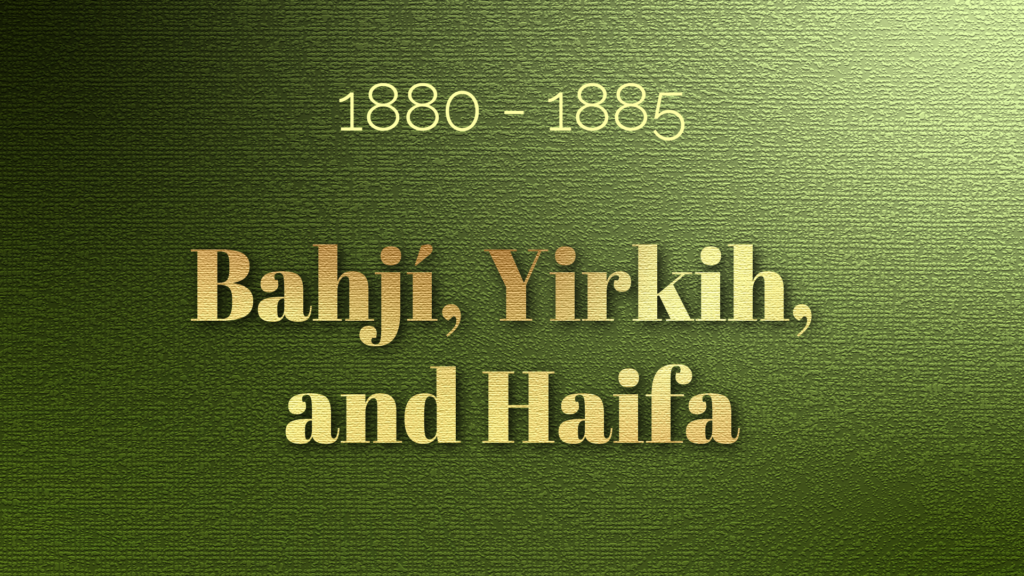
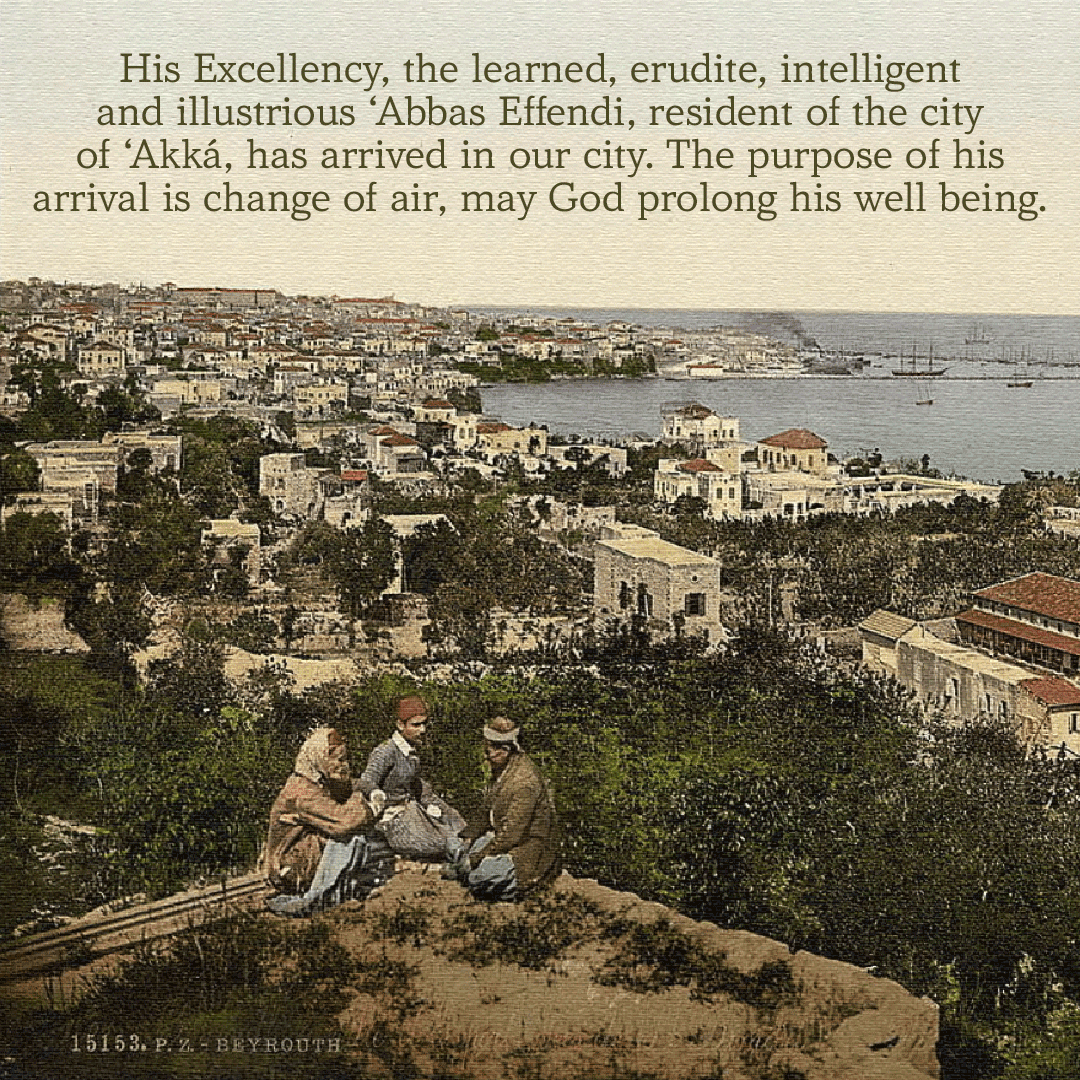
Vintage postcard of Beirut, Lebanon in the 1890s, with text from the Thamarát al-Funún newspaper article of Tuesday 8 June 1880, announcing 'Abdu'l-Bahá’s arrival. Source: Old Beirut Blog (website closed). Accessed 2021/01/09.
Midḥat Páshá, was the Governor-General of Damascus, one of the most brilliant Ottoman statesmen of his time, and the leader of the constitutional reform movement of 1876. In May 1880, he was on an inspection tour of Palestine, and did everything in his power to meet 'Abdu'l-Bahá, sending Him a message through a courier which read: “I yearn to meet His Excellency.” Midḥat Páshá was so enchanted with 'Abdu'l-Bahá that he asked Him to return to Beirut with him. Back in Lebanon, he wrote 'Abdu'l-Bahá a short poem, about his desire to meet him, and Bahá'u'lláh encouraged His Son to accept the Governor’s invitation.
'Abdu'l-Baha visited Beirut between 1 and 17 June 1880, and His arrival made the front page of the weekly Thamarát al-Funún newspaper on Tuesday 8 June 1880: “His Excellency, the learned, erudite, intelligent and illustrious ‘Abbas Effendi, resident of the city of ‘Akka, has arrived in our city. The purpose of his arrival is change of air, may God prolong his well being.”
'Abdu'l-Bahá spent most of His time in Beirut with Midḥat Páshá and met important figures in the Arab world, including Shaykh Muḥammad-'Abduh, the future Grand Muftí of Egypt. 'Abdu'l-Bahá’s visit to Beirut, while still a prisoner of the Ottoman Empire, and at the express invitation of one of the most illustrious Ottoman Governors, was an undeniable sign of Bahá'u'lláh’s splendor, and elevated the prestige of the Bahá'í Faith to an entirely new level.
Shoghi Effendi, God Passes By.
H.M. Balyuzi, Bahá'u'lláh: The King of Glory, pages 378-379.
Necati Alkan, The Historical Background of the Tablet of the Land of Bá, published in Bahá'í Studies Review Volume 13 (2005), pages 1–13.
Wikipedia: Midhat Pasha.
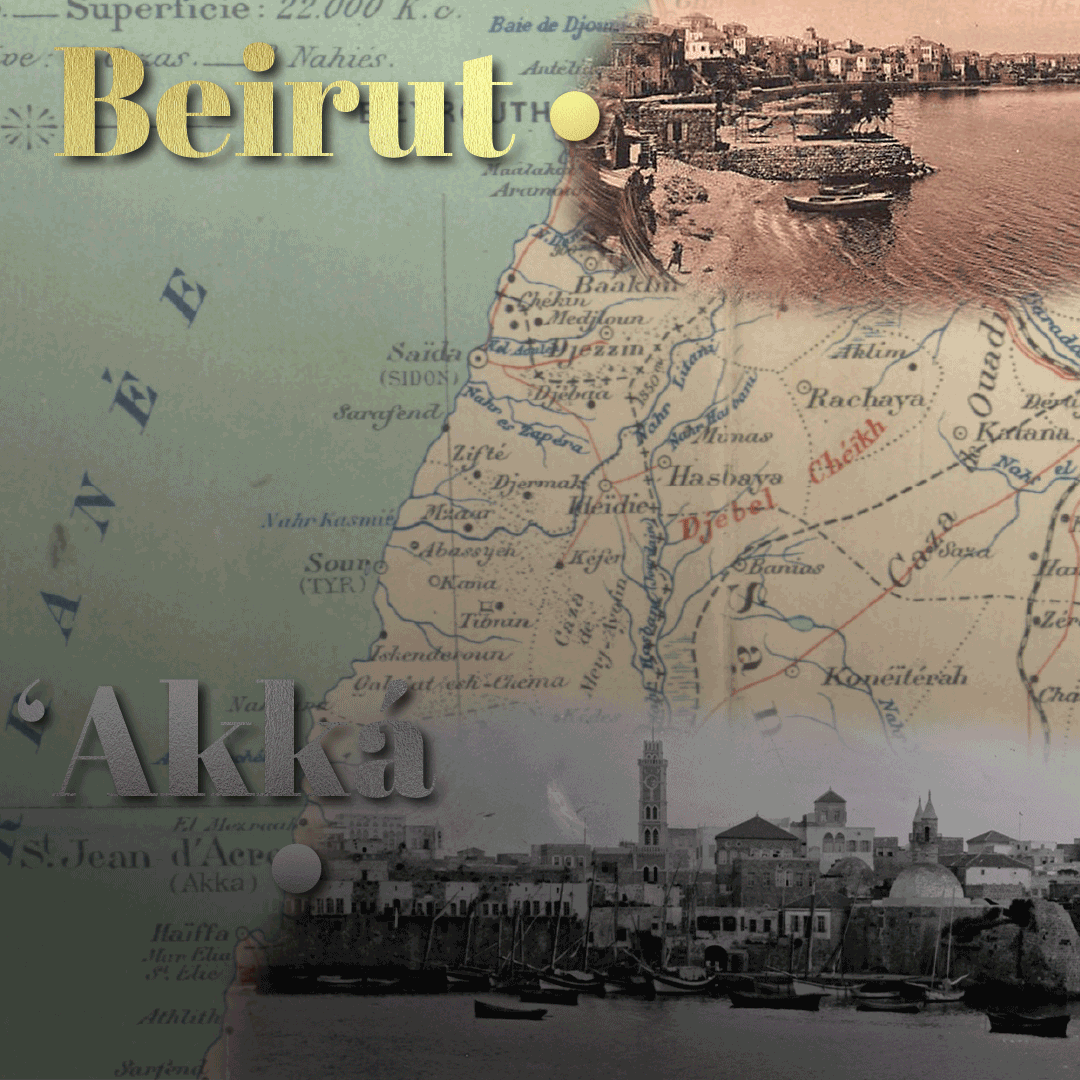
Illustration of the verse in the Lawḥ-i-Arḍ-i-Bá: “Praise be to Him Who hath honored the Land of Bá [Beirut] through the presence of Him round Whom all names revolve…Sorrow, thereby, hath enveloped this Prison-city ['Akká], whilst another land rejoiceth,” with Beirut wreathed in sunshine as 'Akká is enveloped in darkness. Photo of the bay of 'Akká: Wikimedia Commons; Photo of the bay of Beirut in 1880, the year 'Abdu'l-Bahá visited the city: Old Beirut Blog (website closed). Accessed 2021/01/09. Source Map: Wikimedia Commons. © Violetta Zein.
Abdu'l-Bahá’s visit to Beirut occasioned the Revelation of one of the most touching Tablets Bahá'u'lláh ever revealed in honor of 'Abdu'l-Bahá, the Lawḥ-i-Arḍ-i-Bá (Tablet of the Land of Bá). In this Tablet, Bahá'u'lláh exalts the loftiness of 'Abdu'l-Bahá's station and His exalted rank in the Faith. In the Lawḥ-i-Arḍ-i-Bá, Bahá'u'lláh gives voice to the land of 'Akká, lamenting the absence of 'Abdu'l-Bahá, and to the land of Beirut, rejoicing in His footsteps. Bahá'u'lláh affirms that all the atoms of the earth announced the Master's movement from one city to the other to all created things, and concludes the Tablet by expressing yearning to meet with 'Abdu'l-Bahá again.
In this meaningful Tablet, Bahá'u'lláh testifies to 'Abdu'l-Bahá’s station with a moving paragraph that recounts the bounties derived from proximity to 'Abdu'l-Bahá, for all created things, living and inert: “Blessed, doubly blessed, is the ground which His footsteps have trodden, the eye that hath been cheered by the beauty of His countenance, the ear that hath been honored by hearkening to His call, the heart that hath tasted the sweetness of His love, the breast that hath dilated through His remembrance, the pen that hath voiced His praise, the scroll that hath borne the testimony of His writings.”
To listen to the Utterance Project’s publication of the Lawḥ-i-Arḍ-i-Bá, recited in the original Arabic with English translation and transliteration subtitles, please click on the graphic below:
Partial Inventory ID: BH02209
Bahá'u'lláh, Lawḥ-i-Arḍ-i-Bá, (Tablet of the Land of Bá).
DATE
Necati Alkan, The Historical Background of the Tablet of the Land of Bá, published in Bahá'í Studies Review Volume 13 (2005), pages 7.
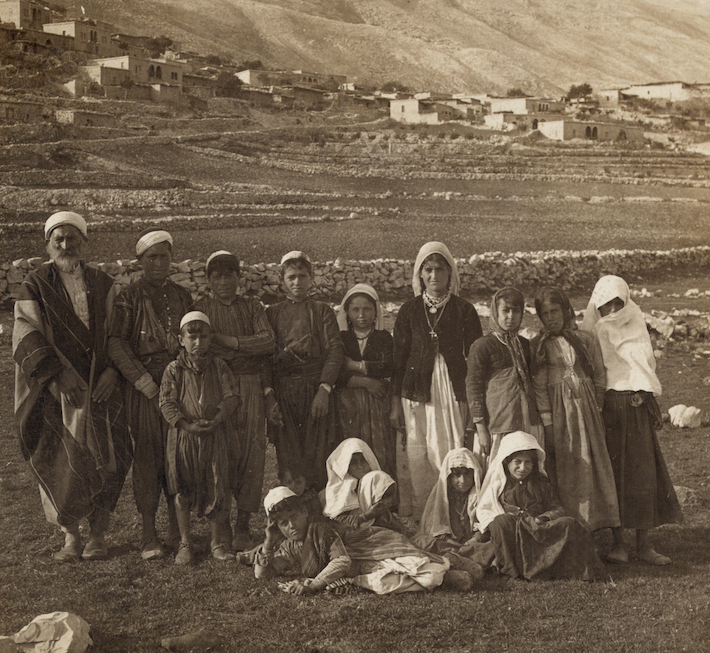
As no images of Yirkih were found, here is an example of what Druze villagers would appear like, some 20 years after Bahá'u'lláh and 'Abdu'l-Bahá stayed in Yirkih. These are Druzes of Mount Hermon, circa June 1901. Photographer H.C. White Co. Library of Congress.
Shortly after 'Abdu'l-Bahá’s return from Beirut, Bahá'u'lláh journeyed from Bahjí to the Druze village of Yirkih, 8 kilometers (5 miles) northeast of 'Akká, where He remained for seven nights. 'Abdu'l-Bahá joined Bahá'u'lláh for the last four nights of His stay. When Bahá'u'lláh stayed in Yirkih, He occupied a room that was long kept intact as a place of veneration.
David S. Ruhe, Door of Hope: The Bahá’í Faith in the Holy Land, page 119.
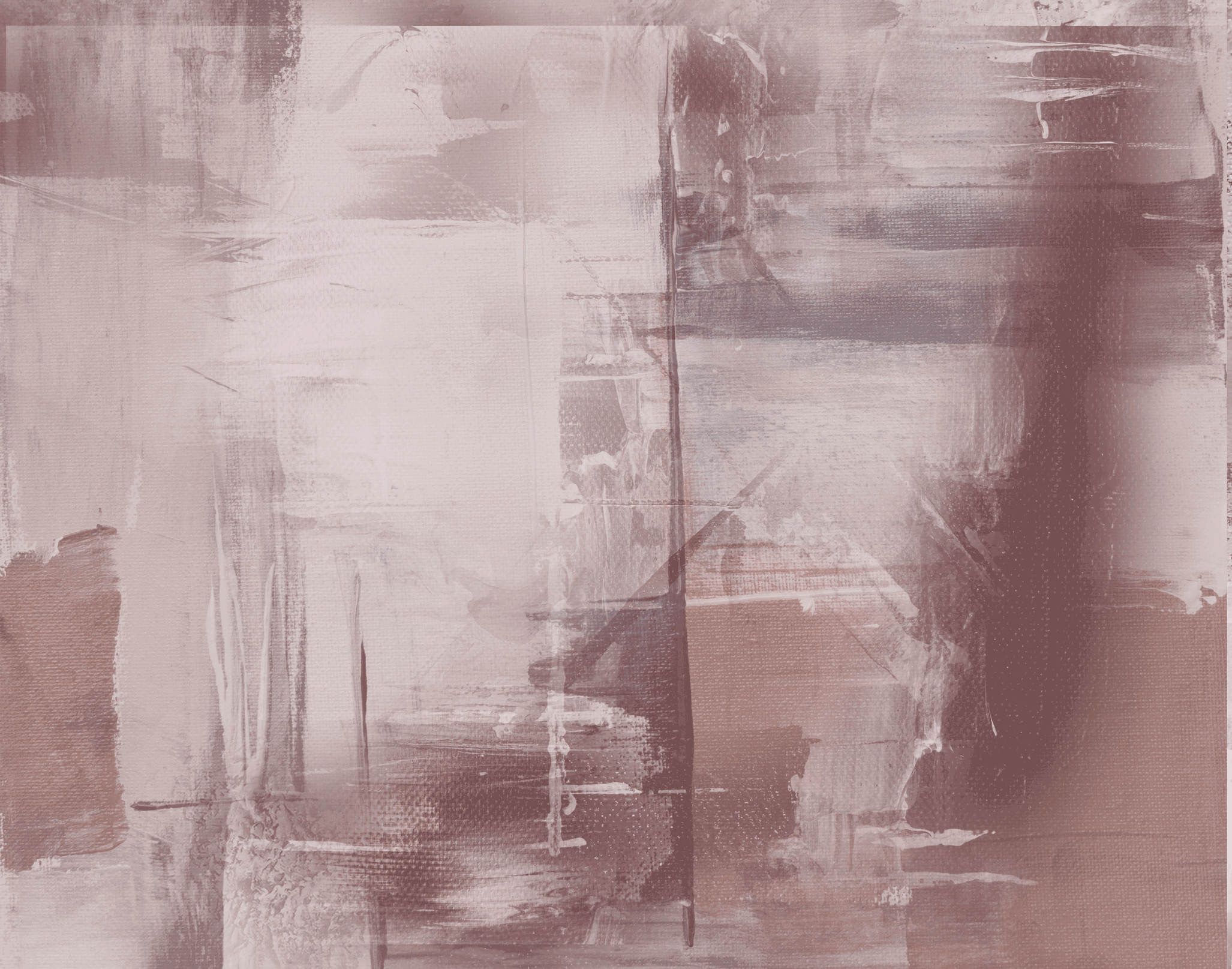
An attempt to convey the emotion of grief. © Violetta Zein
Sárih Khánum had married Ásíyih Khánum’s brother in 1832 and encouraged her father Mírzá Buzurg to arrange the young lady’s marriage to her younger Brother. Bahá'u'lláh was deeply attached to Sárih Khánum, a devoted and steadfast Bahá'í to the end of her life.
Bahá'u'lláh and Sárih Khánum had a very close relationship, He exclusively called her Ukht (Sister) in His frequent and intimate Tablets, in which He disclosed to her His sufferings and banishments, His solitude in Sulaymáníyyih, closing one letter by asking tenderly His sister: “Do thou always write about thy affairs.”
Sárih Khánum passed away in 1880, at the age of 65 and was buried near the Shrine of Bíbí Zubaydih, not far from Ṭihrán. In a Tablet, Bahá'u'lláh states that whosoever has visited Sárih Khánum’s grave, has visited Him. Bahá'u'lláh’s grief is heartbreaking in the Tablets He revealed after her death and in which He speaks of her steadfastness, and recounts her sufferings, after calling her passing a calamitous event: “She was indeed oppressed and quietly endured that which none but God is able to recount. Blessed is she. My glory be upon her for having endured patiently for the sake of God and for having sustained hardships in His straight path.”
Adib Taherzadeh, The Revelation of Bahá'u'lláh Volume 1: Baghdád 1853 - 1863, pages 49-50.
Baharieh Rouhani Ma'ani, Leaves of the Twin Divine Trees, pages 265-272.
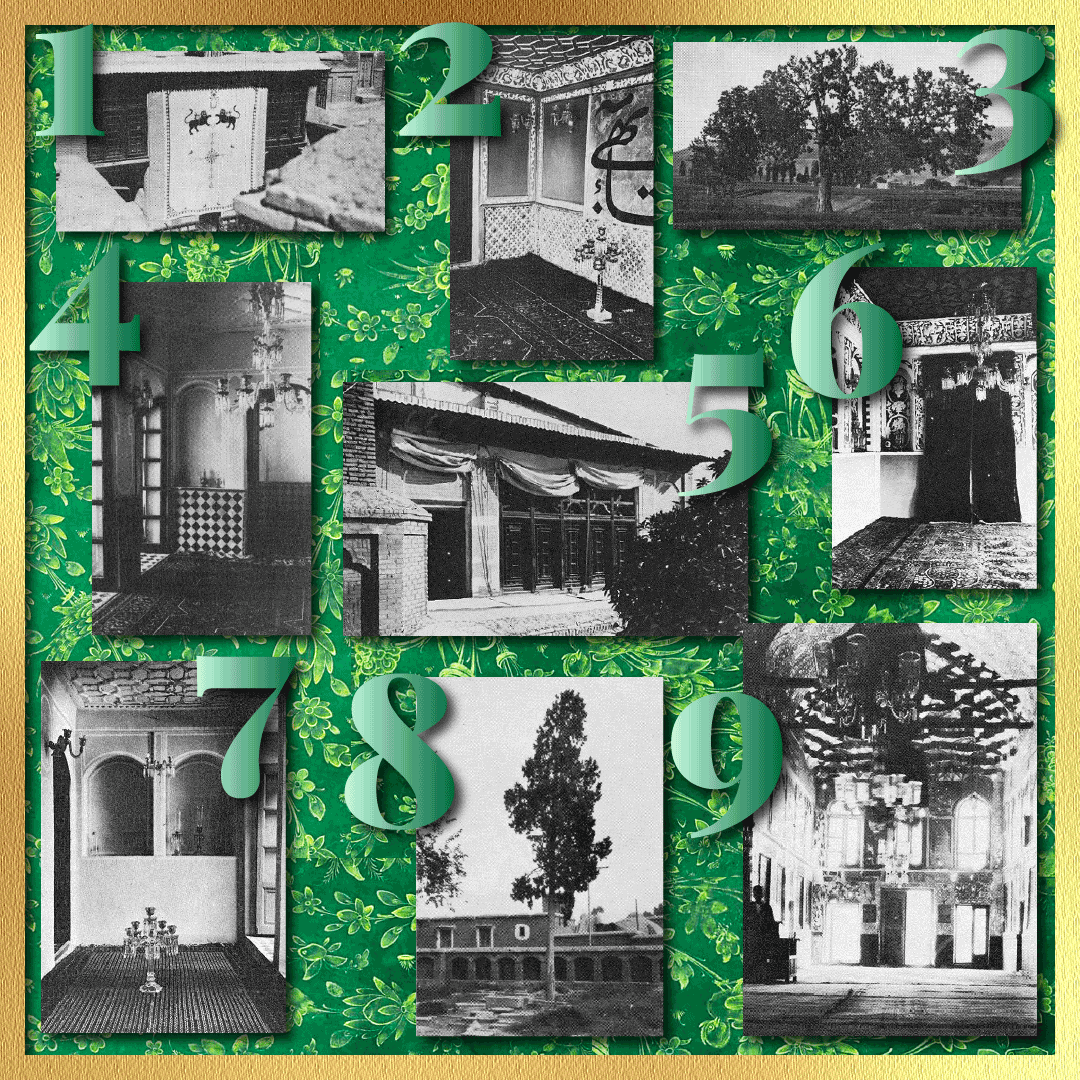
The lives of Khadíjih Bagúm and the Báb in an album of nine pictures centered around the Holy House of the Báb, which Khadíjih Bagúm had begged Bahá'u'lláh to be repaired. Photo 1: The room on the left is where the Báb was born in Shíráz. Photo 2: The room of the Báb’s mother. Photo 3: Outskirts of Shíráz where the Báb often went to walk. Photo 4: the Báb’s sitting room. Photo 5: Outside view of the upper floor room where the Báb declared His mission to Mullá Ḥusayn. Photo 6: Inside view of the Declaration chamber. Photo 7: The Báb’s sitting room. Photo 8: Tree marking resting place of the Báb's infant son in Bábí-Dukhtarán, Shíráz. Photo 9: Grave of the Báb's wife in Sháh-Chiragh, Shíráz. Source for photos: Nabíl, The Dawn-Breakers, pages 58, 60, 61, and 75. Background: Page of Calligraphy from an Anthology of Poetry by Shíráz poets Sa`di and Hafiz; Ink, opaque watercolor, silver, and gold on paper. Source: The Met.
Khadíjih Bagúm, was a descendent of Khadíjih, the wife of the Prophet Muḥammad, who was the first person to recognize her Husband as a Manifestation of God. Thirteen centuries later, like her illustrious ancestor, Khadíjih Bagúm claimed the everlasting honor of being the first to recognize the Báb’s station, a fact confirmed by Bahá'u'lláh, Who affirmed that she “found the fragrance of the garment of the Merciful” “before the creation of the world of being.”
Khadíjih Bagúm had begged Bahá'u'lláh for His family to be united with the family of the Báb through marriage. 'Abdu'l-Bahá had granted Khadíjih Bagúm’s dearest wish, but when her brother and nephew left for the Holy Land to arrange the marriage, they left Khadíjih Bagúm behind, and the betrayal broke her heart. Khadíjih Bagúm never recovered. She fell ill, her health declined, and she died two months later, on 15 September 1882. Three hours later, her devoted servant, Fiḍḍih also died.
Ásíyih Khánum had hoped for decades to meet Khadíjih Bagúm. They were close in age, and both married to Manifestations of God, and Khadíjih Bagúm’s tragic and untimely death caused Ásíyih Khánum lasting disappointment and sadness. Bahá'u'lláh also experienced profound grief at Khadíjih Bagúm’s passing, describing it as a “sorrow, like unto the life-vein, coursed throughout the body and in every artery produced its effect,” and revealed the epitaph for her tombstone which read “He is the Eternal! Verily, the exalted leaf hath heard the call of the divine Late-Tree and hath taken her flight unto it. 1299 .”
In a Tablet revealed a year after her passing, Bahá'u'lláh elevated Khadíjih Bagúm to the rank of martyr, “The heart of Thamariy-i 'Ulyá (the Most Exalted Fruit) was verily consumed in the fire of separation. For that reason, before God she is regarded as a martyr.” Khadíjih Bagúm is the only female martyr in the family of the Báb.
Baharieh Rouhani Ma'ani, Leaves of the Twin Divine Trees, pages 26-60 and 114.
Adib Taherzadeh, The Revelation of Bahá'u'lláh Volume 2: Adrianople 1863-1868, pages 381-387.
DATE
Baharieh Rouhani Ma'ani, in Leaves of the Twin Divine Trees, page 56 states this Tablet of Bahá'u'lláh conferring the station of martyr upon Khadíjih Bagúm was signed and dated 14 Ṣafar 1300 A.H., which was converted to 25 December 1882 using Habibur AH to AD converter.
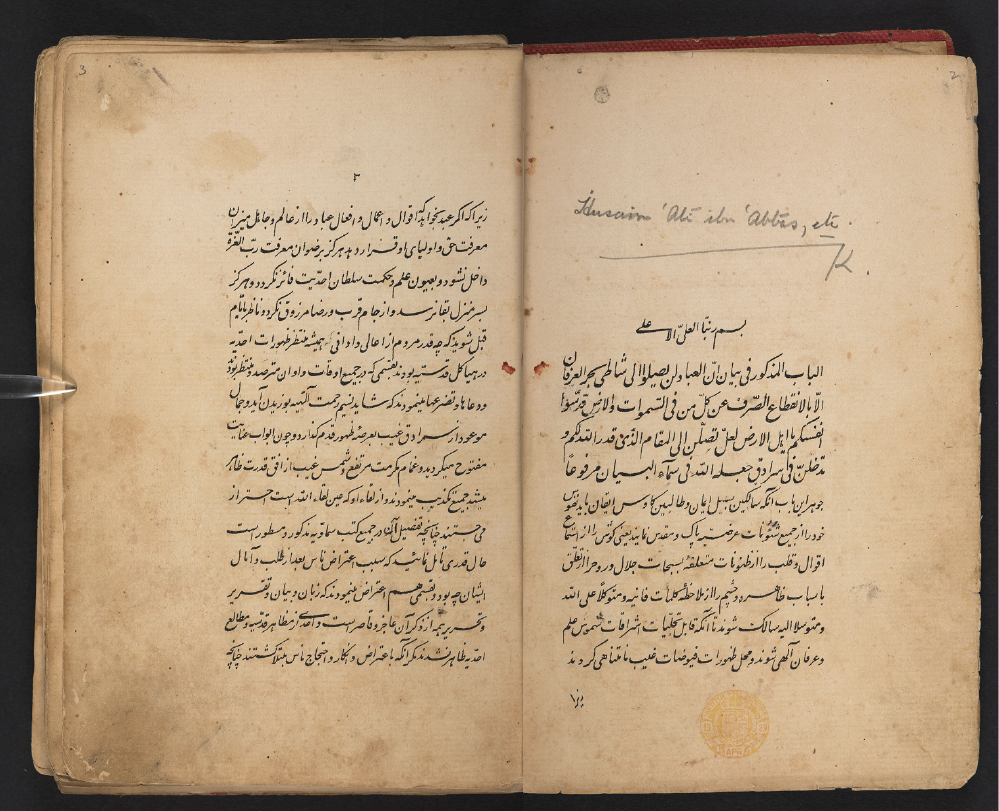
Baha’i books were printed in India from about 1882 onwards at Baha’u’llah’s direction. Shown here is the opening of what is believed to be the earliest publication of a Baha’i book, a lithograph of Kitáb-i-Íqán (The Book of Certitude), which was published in India around 1882. Source: British Library.
The first Bahá'í publication is believed to have been that of the Kitáb-i-Íqán (The Book of Certitude), in India in 1882. Around 1890, Bahá'u'lláh directed the publication of the first multi-volume compilation of His writings, the Kitáb-i-Mubín (The Lucid Book) under the imprint of the Náṣirí printing press in Bombay. The Kitáb-i-Mubín is a collection of around 200 Tablets of Bahá'u'lláh compiled by Zaynu’l-Muqarrabín, none of which have been translated into English, with the exception of its first selection, the Súriy-i-Haykal. Muḥammad ‘Alí had been sent to India to calligraphy this momentous publication with his exquisite handwriting, and he had altered the text of the Kitáb-i-Aqdas to remove all mentions of 'Abdu'l-Bahá. Fortunately, his devious act was soon caught.
Marzieh Gail, Summon up Remembrance, online PDF page 247.
Baharieh Rouhani Ma'ani, Leaves of the Twin Divine Trees, page 59.
Many thanks to Adib Masumian for providing the information about the publication of the Kitáb-i-Mubín, the result of his personal research.
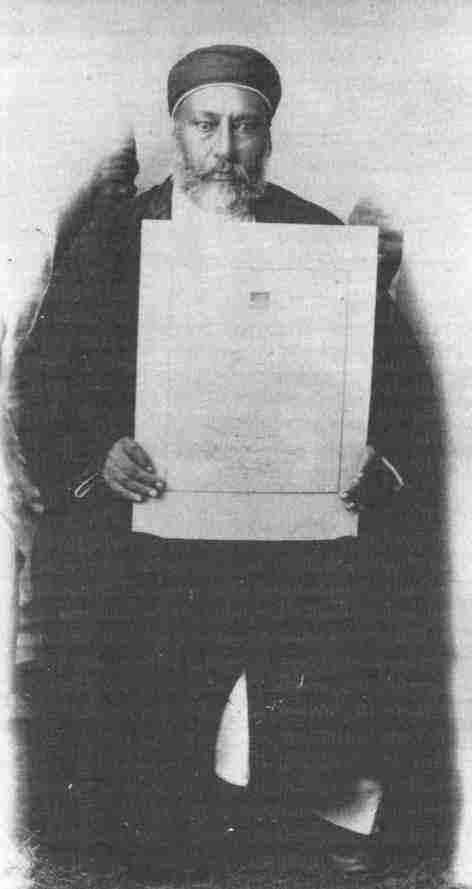
Áqá Mírzá Áqá titled Núru'd-Dín, was the nephew of Khadíjih Bagúm, the wife of the Báb. He is seen holding the Tablet bearing the seal of Bahá'u'lláh in which his family are nominated custodians of the House of the Báb in Shíráz. Source: Adib Taherzadeh, The Revelation of Bahá'u'lláh Volume 4: Mazra’ih and Bahjí 1877-1892, page 331.
During her lifetime, Khadíjih Bagúm, the widow of the Báb, had beseeched Bahá'u'lláh for two things: for the Holy House of the Báb to be repaired and for the families of the Báb and Bahá'u'lláh to be united in marriage. Bahá'u'lláh acceded to both her requests, and bestowed the custodianship of the House of the Báb on Khadíjih Bagúm and her descendants in a Tablet, the start of a two-century tradition of Holy Place custodianship in the the Bahá'í Faith: “…We have bestowed the custodianship of the Blessed House upon the exalted leaf, the wife of the Primal Point, and her sister, upon them rest the glory of God and His mercy and His favor. God hath granted the custodianship for this House. Verily, He is adorned with the robe of generosity and hath fixed His seal on this command, for He is the Almighty, the Beloved. From her Lord, the Merciful, this honor and benevolence hath been bestowed upon the sister and her descendants. He is the Munificent and the Compassionate, and He is the Generous and the Bounteous.”
Ahang Rabbani, The Afnán Family: Some Biographical Notes, on Bahá'í Library Online.
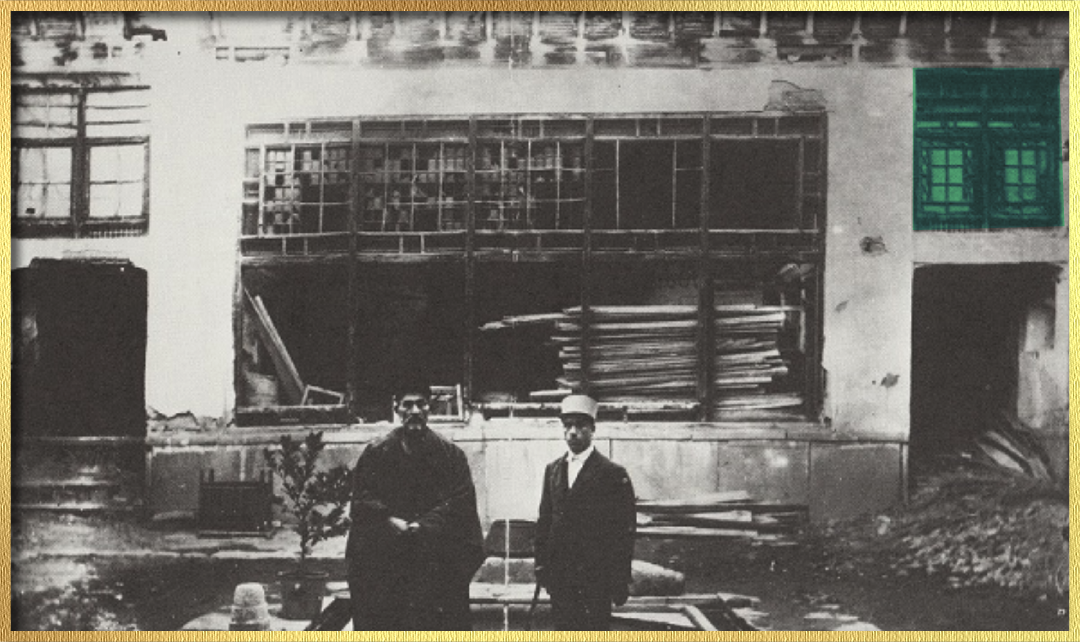
The Governor’s Court in Úrumíyyih, the window of the bálá khánih, the upper room, where the Báb stayed, and where His portrait was painted is indicated with a green overlay. Source: Nabíl, The Dawnbrakers, page 310.
In July 1848, when the Báb was transferred from Tabríz to Chihriq, He passed through the small town of Úrumíyyih, where He stayed a few days, during which Áqá Bálá Bag, the chief painter of Malek-Qasim Mírzá, the Governor of Úrumíyyih, was allowed to have three sessions with the Báb, during which the artist painted a full-scale black and white portrait of the Báb, at the age of 29.
In the early 1880s, Varqá moved to Tabríz, became friends with Áqá Bálá Bag and discovered the portrait. He wrote to Bahá'u'lláh, and they exchanged several communications in which they spoke about the paintings of the Báb. In 1882, Bahá'u'lláh directed Varqá to have Áqá Bálá Bag paint two copies of the original portrait in watercolor, one which stayed with Varqá, and one which was sent to the Holy Land via Hand of the Cause Ḥájí Akhúnd, and is currently preserved in the International Baha’i Archives in Haifa.
Sometime between 1882 and February 1888, Varqá sought Baha’u’llah’s permission to make seven additional copies of the Báb’s portrait for future Houses of Worship, but the painter died before completing them.
H.M. Balyuzi, Eminent Bahá’ís in the Time of Bahá’u’lláh.
Bijan Masumian and Adib Masumian, The Báb in the World of Images (PDF download link).
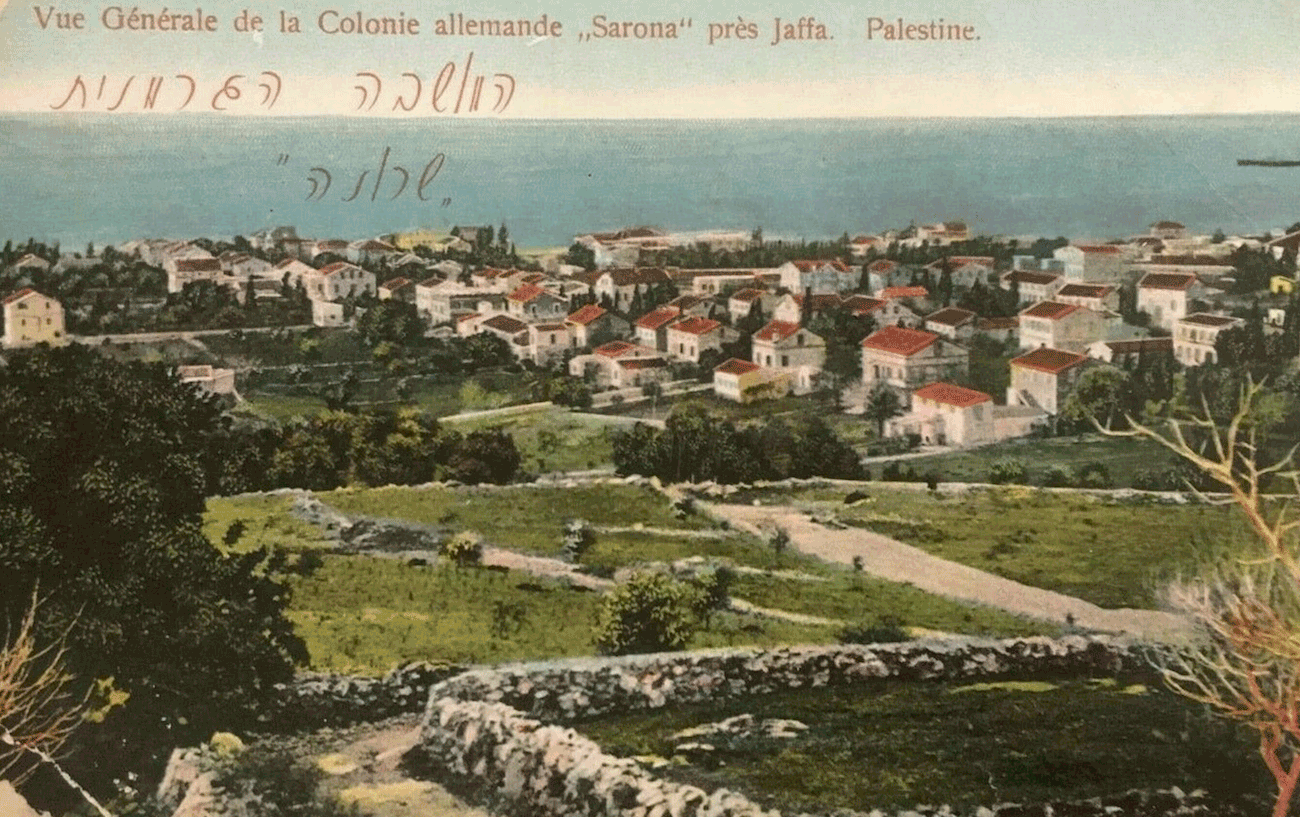
The German Templer colony in Haifa, where Bahá'u'lláh stayed during His 1883 visit. Source: Ebay.
Bahá'u'lláh first set foot in Haifa - for only a few hours - on 31 August 1868, when He disembarked from the Lloyd-Triestino steamer before boarding a sailboat to 'Akká. Fifteen years later, on 6 August 1883, Bahá'u'lláh visited Haifa for the second time, staying for a few weeks in a hotel in the German Templer Colony. Speaking of this visit in a Tablet, Bahá'u'lláh states “the Desire of Carmel aimed to visit the Mountain of God.”
In a provisionally-translated excerpt from a Tablet revealed in September 1883 in honor of Ḥájí ‘Abdu’l-Ḥamíd of Zarqan, Bahá'u'lláh states “…for a few days the Mountain of God became the seat of the Temple and this is the Station which had been mentioned in the past Books. The voice of the Spirit (Jesus Christ) had been raised in this place and all the other Prophets have told of this Station. This is the Mountain of God. Since its creation until now, it has been waiting to see Him; thanks be to God that it has attained its desire and the Voice was raised…. Whatever was written in the Books of God have become manifest. Happy those who understand and woe betide the negligent”.
H.M. Balyuzi, Bahá'u'lláh: The King of Glory, pages 373-374.
David S. Ruhe, Door of Hope: The Bahá’í Faith in the Holy Land, pages 104.
Fuad Izadinia, The Major Opus: A study of the German Templer movement and its relationship with the Bahá'í Faith, many grateful thanks to Mr. Izadinia for providing this exciting manuscript and allowing it to be quoted.
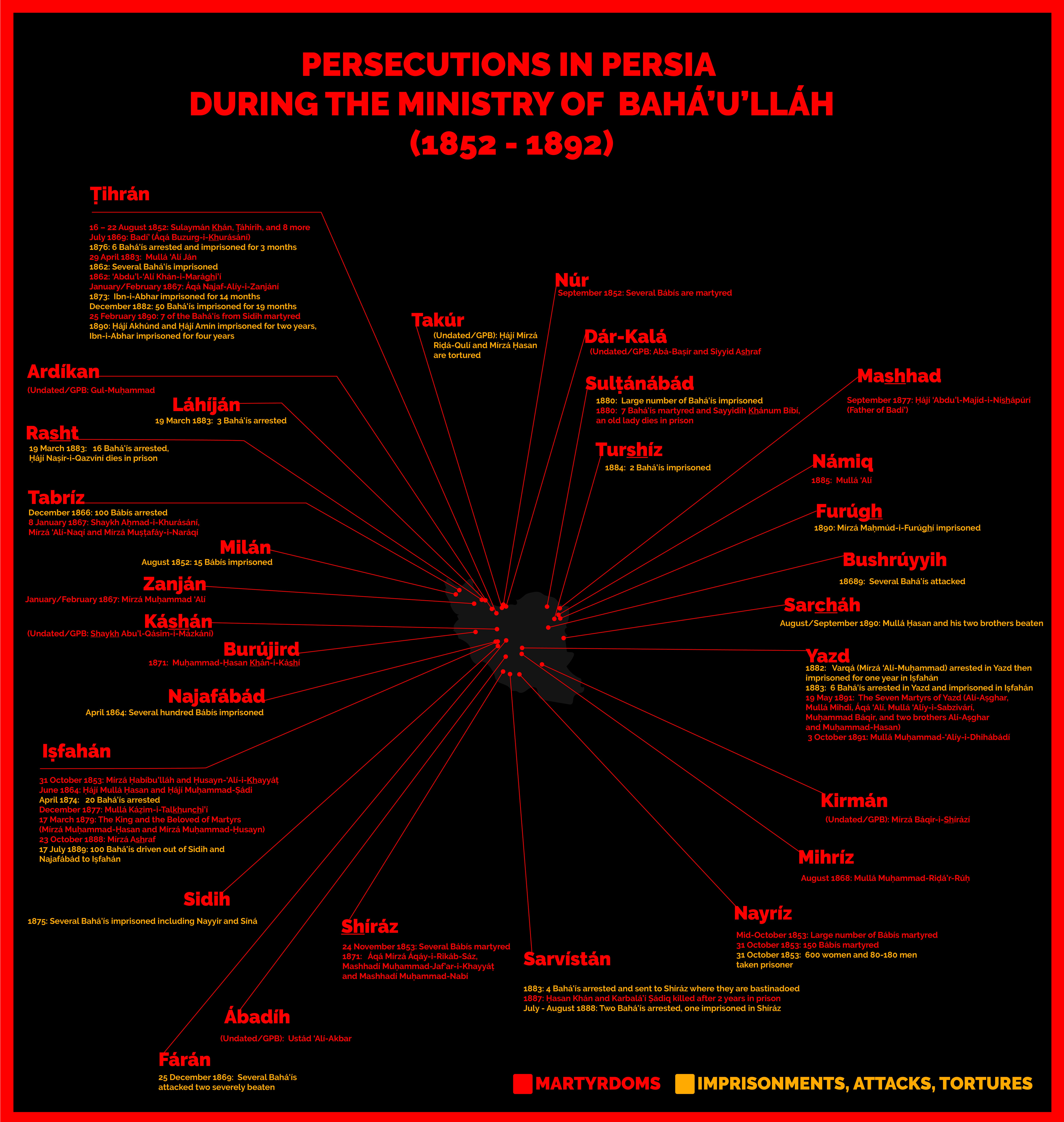
The above map, of persecutions above which occurred during the ministry of Bahá'u'lláh, was compiled from persecutions listed by Shoghi Effendi in Chapter XII: Bahá’u’lláh’s Incarceration in ‘Akká (Continued) in God Passes By, complemented by the list made by Moojan Momen in The Bahá'í World Volume XVIII (1979-1983), pages 380-392, entitled A Chronology of some of the persecutions of the Bábís and Bahá'ís in Írán 1844 - 1978.
The three groups of people responsible for the bulk of persecutions against Bahá'ís in Persia during Bahá'u'lláh’s ministry were Náṣiri’d-Dín Sháh, the “Prince of Oppressors,” his three sons Muẓaffari’d-Dín Mírzá, Mas‘úd Mírzá, and Kámrán Mírzá, as well as Shí’ah clerics.
In December 1882, 50 Bahá'ís, including Mírzá Abu’l-Faḍl and Hand of the Cause Ḥájí Akhúnd, were arrested and imprisoned in Ṭihrán for 19 months. One day in June 1884, Bahá'u'lláh hosted all the Bahá'ís in the garden of Riḍván with refreshments to celebrate the release of Mírzá Abu’l-Faḍl and Hand of the Cause Ḥájí Mullá ‘Alí-Akbar in Ṭihrán. The Bahá'ís received a telegram informing them of their release the next day.
Shoghi Effendi, God Passes By.
Adib Taherzadeh, The Revelation of Bahá'u'lláh Volume 4: Mazra’ih and Bahjí 1877-1892, page 14.
DATE OF JUNE 1884
December 1882 plus 19 months.
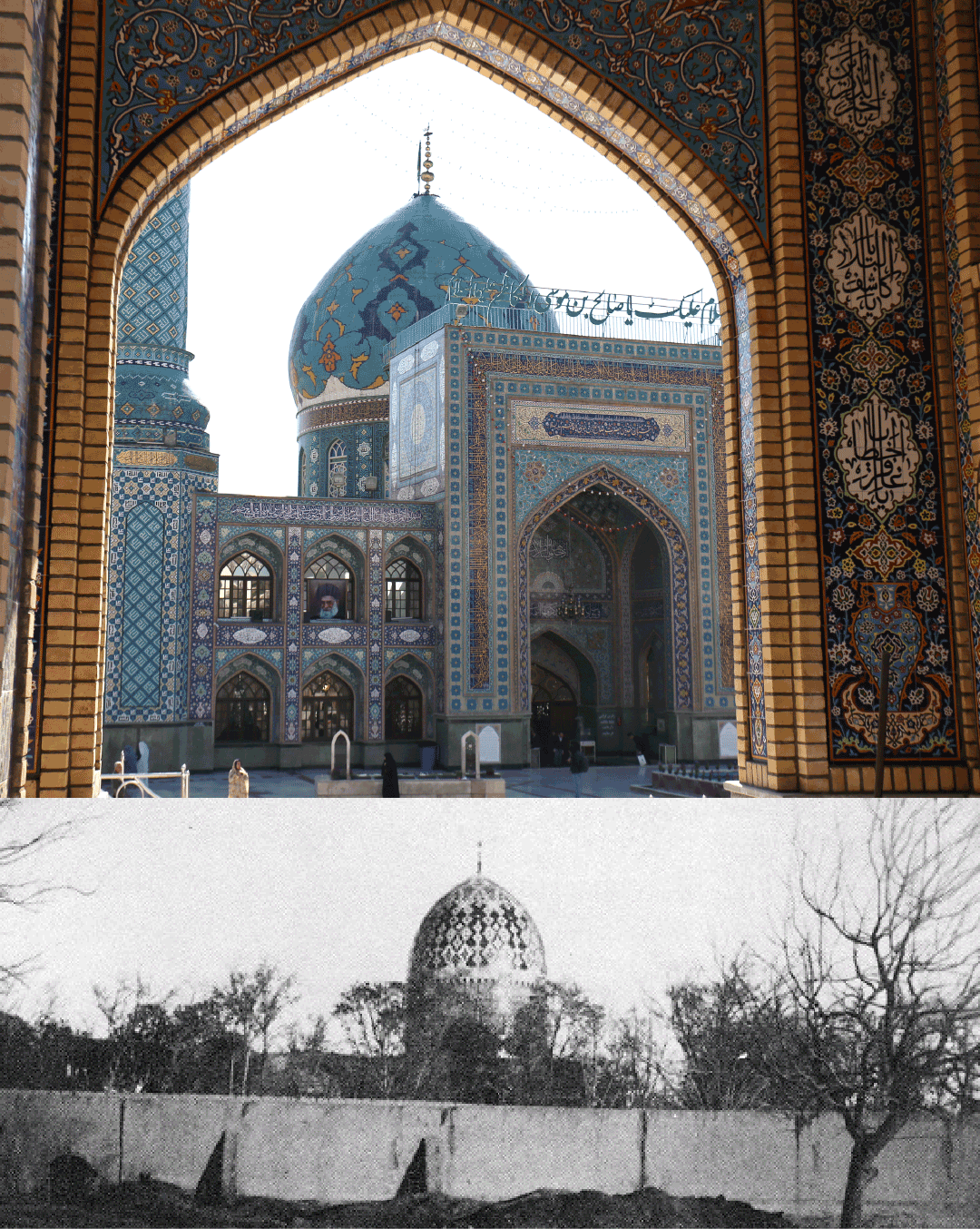
The shrine of Imám Zadih, present and past, where the remains of the Báb were concealed for years. Modern photograph by Behrad Moudi - Own work, CC BY-SA 4.0, from Wikimedia Commons. Historical photograph: Nabíl, The Dawn-Breakers, page 520.
Around 1884 – 1885, Bahá'u'lláh instructed Mírzá Asadu'lláh-i-Iṣfahání to move the remains of the Báb from the Shrine of Imám Zádih to another hiding place, and included a chart indicating their exact location. This was an incredibly difficult and dangerous task, but Mírzá Asadu'lláh succeeded, and first kept the sacred casket in his house, later transferring it to the houses of Ḥusayn-'Alíy-i-Isfahání and Muḥammad Karím-i-Aṭṭár, where they remained hidden until 1894.
To continue reading the story about how the remains of the Báb arrived in the Holy Land, click on the graphic below, where the story picks up in the illustrated chronology The Extraordinary Life of 'Abdu'l-Bahá Part IV: Center of the Covenant (1892 – 1912).
Adib Taherzadeh, The Revelation of Bahá'u'lláh Volume 3: ‘Akká, the Early Years 1868-1877, APPENDIX I: The Transfer of the Remains of the Báb, pages 427-430.
Michael Day, Journey to a Mountain: The Story of the Shrine of the Báb, Kindle Edition, locations 508-544.
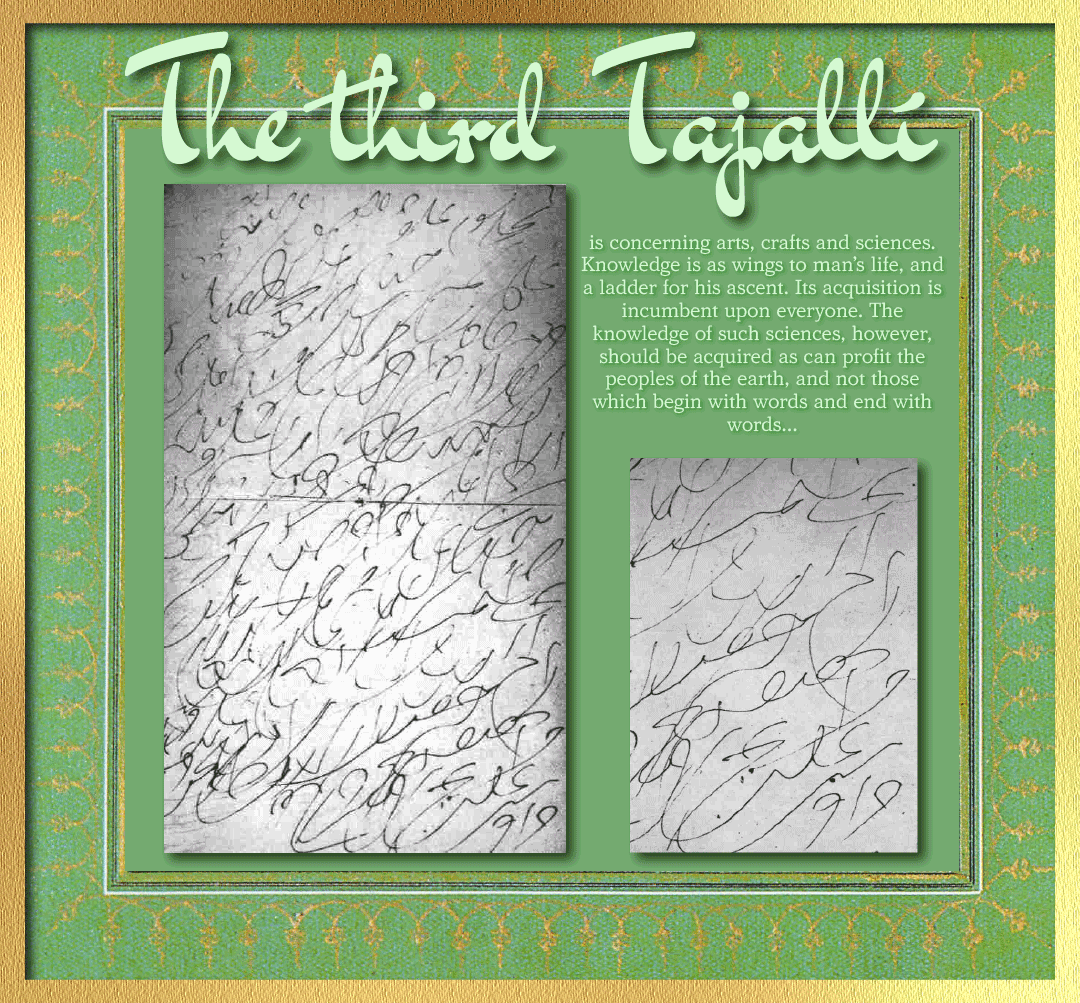
One sheet of 'Revelation Writing' by Mírzá Áqá Ján reduced from the original size of 35 x 22 centimeters (14 x 9 inches), in which only the first few words are sufficiently legible to identify the passage as the third Tajallí of the Tablet of Tajallíyát. The other photograph is a actual size photograph of the same verse. Source: Adib Taherzadeh, The Revelation of Bahá'u'lláh Volume 1: Baghdád 1853 - 1863, between pages 110 and 111. First three lines of Tajllíyát. Background created from the border to an illuminated Tablet of Bahá'u'lláh pictured in Bahá'í Sacred Relics, but sourced from the original Bahá'í World Volume 14 frontispiece.
Between 1885 and 1886, Bahá'u'lláh revealed the three weighty Tablets of Ishráqát, Bishárát, and Tajallíyát, which, in the words of Shoghi Effendi, count as “some of the choicest fruits which His mind has yielded,” marking “the consummation of His forty-year-long ministry.” In these three Tablets, Bahá'u'lláh masterfully expounds on the core social teachings of the Baha'i Faith, offering them in a series of short passages resembling spiritual gems, nine Ishráqs, fifteen Glad Tidings, four Tajallís and six Ṭarázís.
In the Tablet of Ishráqát (Splendours) revealed sometime between 21 August and 29 October 1885, Bahá'u'lláh differentiates between the “Most Great Infallibility,” with which He is endowed, and “conferred” infallibility, bestowed on the Center of the Covenant. Bahá'u'lláh’s teachings in Ishráqát were “revealed specially for the rulers and ministers of the world,” and meant to ensure “safety and protection, tranquility and peace.” Bahá'u'lláh calls religion “a radiant light and an impregnable stronghold for the protection and welfare of the peoples of the world,” warning that “should the lamp of religion be obscured, chaos and confusion will ensue, and the lights of fairness and justice, of tranquility and peace cease to shine.” Bahá'u'lláh also states the importance of a praiseworthy character and good deeds, the need of a universal language, and speaks about the education of children and the trustees of the House of Justice.
Bishárát (Glad-Tidings), is a proclamatory Tablet in which Bahá'u'lláh addresses the people of the world. The fifteen social teachings Bahá'u'lláh promulgates in this Tablet include the abolition of holy war, consorting in fellowship with the followers of all religions, a universal language, obedience to one’s government, prohibition of asceticism, confession, and begging, work elevated to the status of worship, and praising the system of government that combines both monarchy and republicanism. Bahá'u'lláh encouraged Bahá'ís share the Lawḥ-i-Bishárát with statesmen, and, in a Tablet revealed in October/November 1891 in honor of Ḥájí Siyyid ‘Alí Afnán in ‘Ishqábád, He mentions having instructed that the Lawḥ-i-Bishárát be given to the State authorities, while emphasizing the Tablet should not be distributed to statesmen without His permission.
Bahá'u'lláh revealed Tajallíyát (Effulgences) between 1885 and 1886, in which He proclaims four Tajallís, or effulgences: the knowledge of God and recognition of His Manifestation, the importance of steadfastness in the Cause, the importance of steadfastness in the Cause of God, and the acquisition of arts, crafts, and sciences which “can profit the peoples of the earth, and not those which begin with words and end with words.”
Bahá'u'lláh revealed the Tablet of Ṭarázát (Ornaments), between 9 August and 7 September 1888. In this Tablet, Bahá'u'lláh enunciates several key principles of the Faith, in the form of Ṭarázís (Ornaments): the importance of knowing oneself, acquiring a useful profession, possessing a good character, truthfulness and trustworthiness, arts and crafts, acquiring knowledge, and integrity in reporting the news. In several passages, Bahá'u'lláh rebukes Azalís, in particular Hádíy-i-Dawlat Ábádí, whom He reprimands for his “selfish motives,” for using “religion as a snare.” and disregarding “the truth for the sake of gold.”
SOURCES
Shoghi Effendi, God Passes By.
Steven Phelps, The Writings of Bahá'u'lláh in Routledge World: The World of the Bahá'í Faith, First Edition, Edited By Robert H. Stockman, pages 67-68.
ISHRÁQÁT SOURCES
Partial Inventory ID: BH00053
Bahá'u'lláh, Ishráqát (Splendours).
Adib Taherzadeh, The Revelation of Bahá'u'lláh Volume 4: Mazra’ih and Bahjí 1877-1892, pages 145-160.
H.M. Balyuzi, Eminent Bahá’ís in the Time of Bahá’u’lláh, page 62.
DATE: 2 April 1996 Memorandum from the Research Department of the Universal House of Justice.
BISHÁRÁT SOURCES
Partial Inventory ID: BH00568
Bahá'u'lláh, Bishárát (Glad-Tidings).
Adib Taherzadeh, The Revelation of Bahá'u'lláh Volume 4: Mazra’ih and Bahjí 1877-1892, pages 161-167.
Christopher Buck and Youli Ioannesyan, Baha'u'llah's Bisharat (Glad-Tidings): A Proclamation to Scholars and Statesmen, March 2010, Bahá'í Studies Review Volume 16, Number 1, pages 4, 6-7.
Bahá'u'lláh, Lawḥ-i-Ra’ís.
DATE: Christopher Buck and Youli Ioannesyan, Baha'u'llah's Bisharat (Glad-Tidings): A Proclamation to Scholars and Statesmen, page 10.
DATE OF BAHÁ’U’LLÁH’S TABLET ABOUT THE DISTRIBUTION OF BISHÁRÁT
In Christopher Buck and Youli Ioannesyan, Baha'u'llah's Bisharat (Glad-Tidings): A Proclamation to Scholars and Statesmen, March 2010, Bahá'í Studies Review Volume 16, Number 1, page 7: Tablet dated 1 Rabi’l 1309, a partial date which could either be 5 October 1891 or 3 November 1891, respectively 1 Rabi’ al-Awwal or 1 Rabi’ al-Thani. Source: Habibur Islamic date conversion for 1309.
TAJALLÍYÁT SOURCES
Partial Inventory ID: BH00668
Bahá'u'lláh, Tajallíyát.
Adib Taherzadeh, The Revelation of Bahá'u'lláh Volume 4: Mazra’ih and Bahjí 1877-1892, page 118-144.
ṬARÁZÁT SOURCES
Partial Inventory ID: BH00308
Bahá'u'lláh, Ṭarázát (Ornaments).
Adib Taherzadeh, The Revelation of Bahá'u'lláh Volume 4: Mazra’ih and Bahjí 1877-1892, pages 168-176.
DATE: Leiden List.
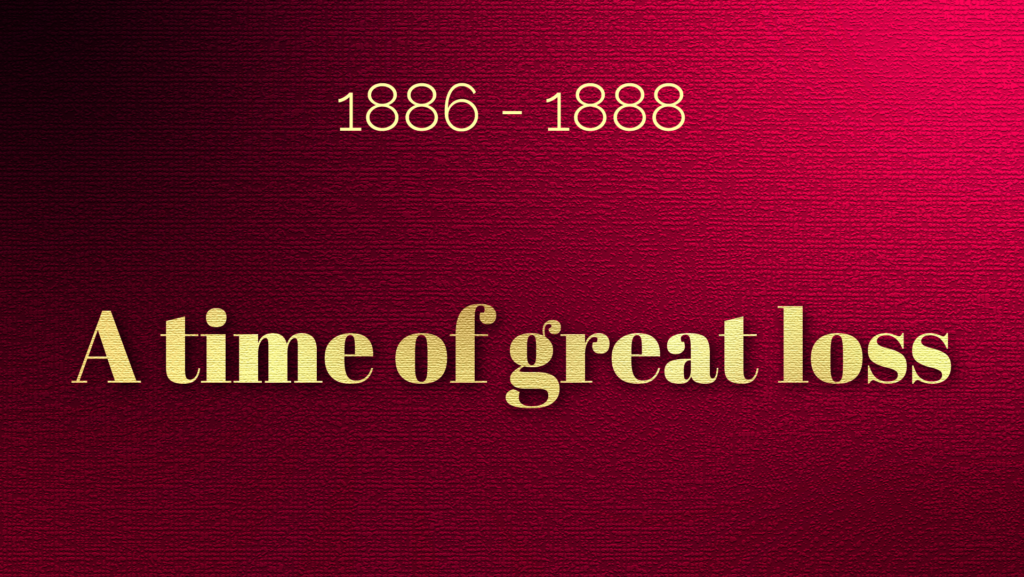
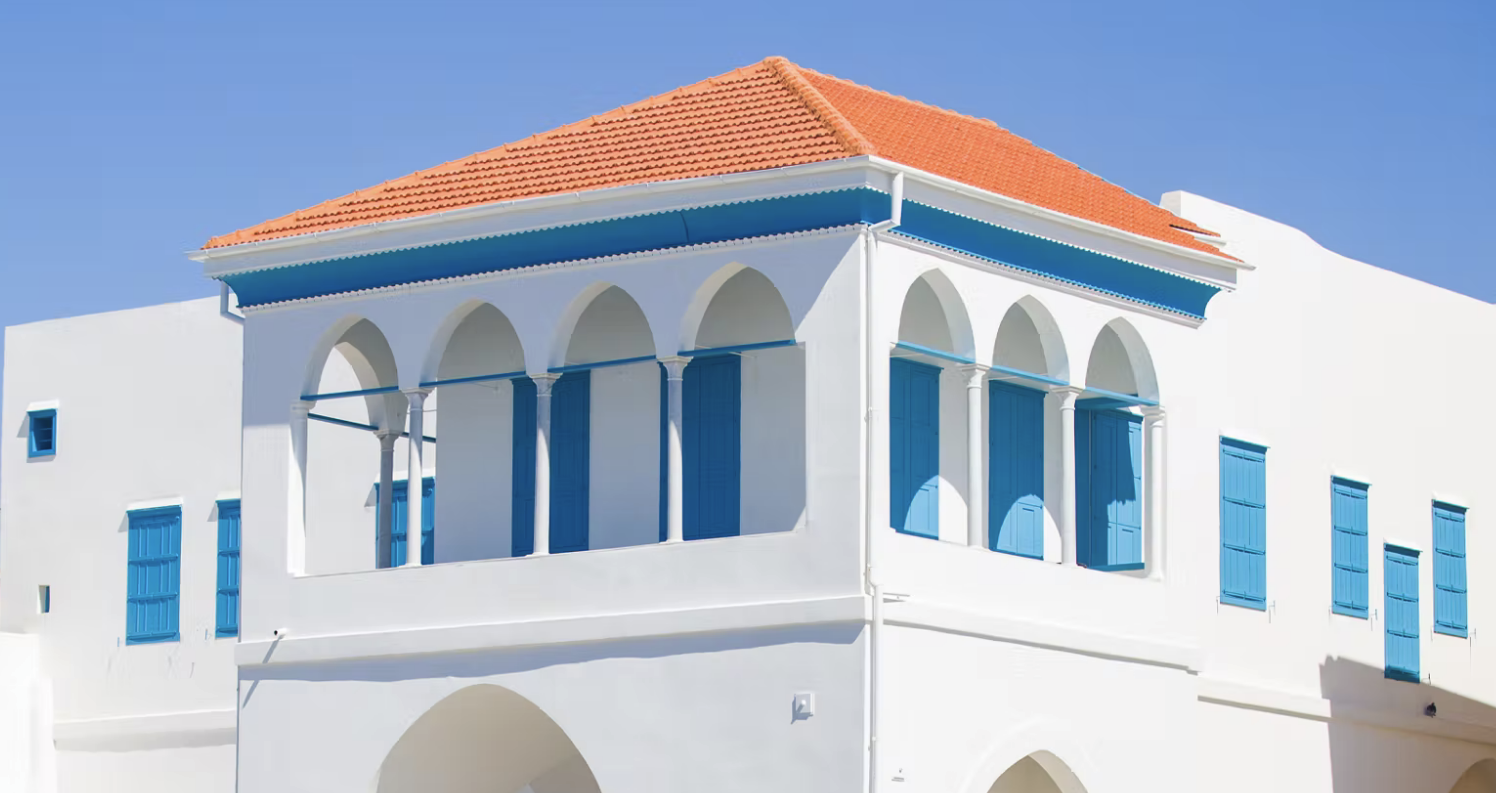
A closeup view of the house of ‘Abbúd, the object of Muḥammad-Yúsuf Páshá’s burning envy, after its restoration in 2021. Source: Bahá'í World News Service © Bahá'í International Community.
Ásíyih Khánum’s health had begun to decline when a new, particularly malevolent Governor returned to ‘Akká for a second term. Muḥammad-Yúsuf Páshá had been the Governor when Bahá'u'lláh had first arrived in the Most Great Prison, and left his post around 1872. He was a Kurd, fanatical, greedy and deeply jealous.
When Muḥammad-Yúsuf Páshá arrived in 'Akká in 1885 for his second Governorship he found that the Ottoman Government had sold the spacious Governor’s residence, and he was reduced to renting a small house near the much larger, stately house of ‘Abbúd. The new Governor soon fell in with enemies of the Faith, and decided to take possession of the house of ‘Abbúd, making constant demands on 'Abdu'l-Bahá to vacate the house at a time when He was increasingly concerned about Ásíyih Khánum’s worsening condition. 'Abdu'l-Bahá agreed to give him the house as soon as He could find new lodgings, but Muḥammad-Yúsuf Páshá never relented.
H.M. Balyuzi, Bahá'u'lláh: The King of Glory, pages 367-371.
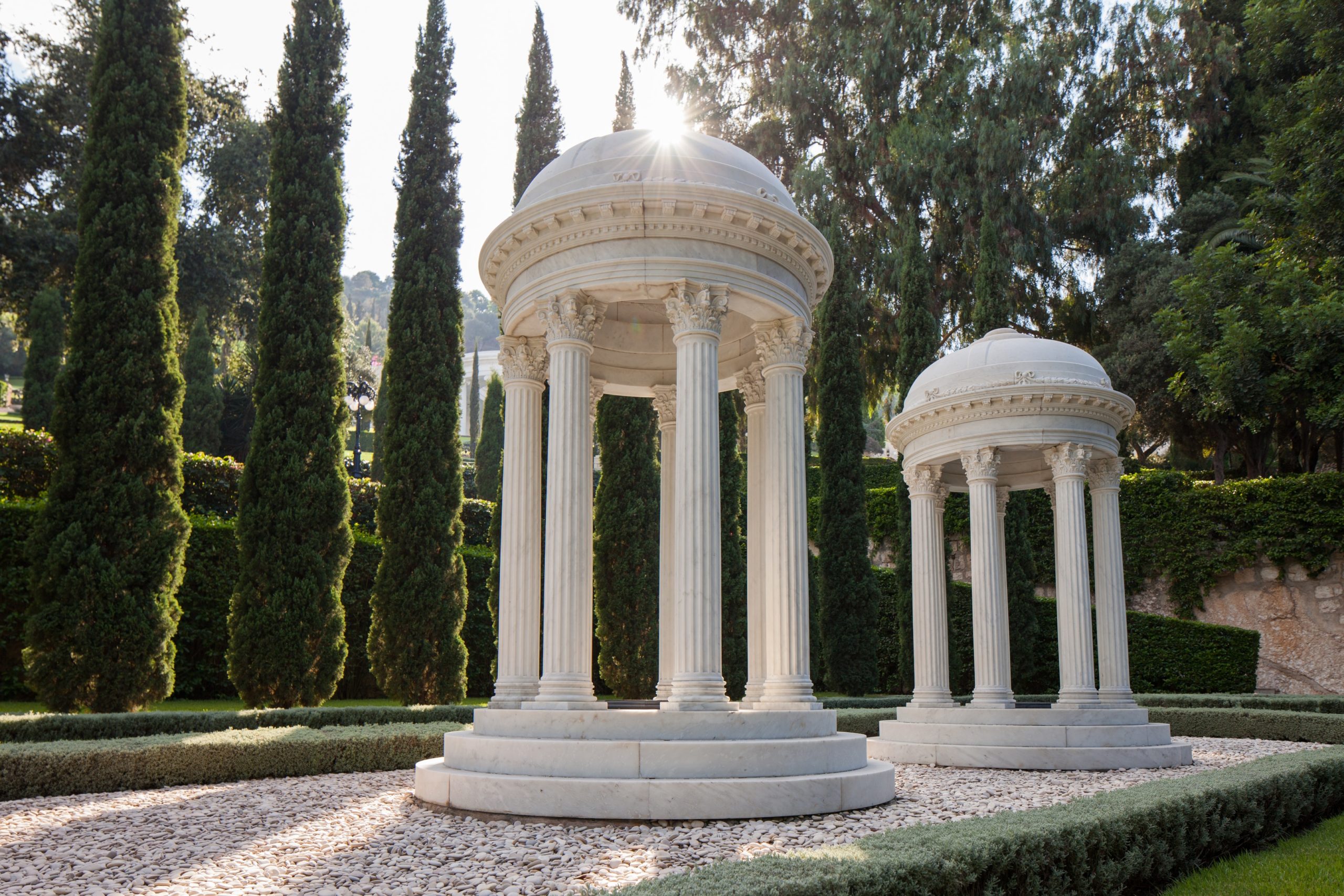
The final resting place of Ásíyih Khánum, known as Navváb, Bahá'u'lláh’s perpetual consort, next to her beloved son Mírzá Mihdí, in the Monument Gardens on Mount Carmel, at the heart of the Administrative Order of the Bahá'í Faith. Source: Bahá'í Media Bank © Bahá'í International Community.
Ásíyih Khánum had lived a modest life. Her room in the house of ‘Abbúd was small, simple and bare, her narrow white bed was her divan during the day, and she had a small table on which she placed her prayer books and Holy Books, pen case, writing papers, prayers and sometimes cut flowers. Ásíyih Khánum had a musical voice and chanted prayers with a wrapt expression on her smiling face. Although a life filled with prolonged sufferings had weakened her, it is believed Ásíyih Khánum died a few days after a fall from a great height, in 1886.
Ásíyih Khánum died surrounded by Bahá'u'lláh, and her adored children, 'Abdu'l-Bahá and Bahíyyih Khánum. Her funeral was held with all the dignity required by her exalted position. Muezzins and reciters of the Qur’án led the funeral cortège which included notables of ‘Akká, Christian and Muslim religious leaders, and schoolchildren, chanting verses and poems expressing their grief. The Holy Family’s sorrow was overwhelming.
Shoghi Effendi refers to Ásíyih Khánum as “the most distinguished of all the people,” “the Shining Star of the Celestial Heaven,” “the Spiritual Mother of the people of Bahá,” “the Wronged Leaf” which hath sprung forth from “the Tree of Faithfulness,” the “Precious and Exalted Treasure and the keepsake of the Abhá Beauty,” and that “Brilliant Star of the Firmament of Faithfulness.”
Bahá'u'lláh called Navváb “His companion in every one of His worlds,” testified that God had singled her out for His own Self, and that she had gazed upon His Countenance, circled round His throne, given ear to His Call, resided in His House, clung to the Cord of His Covenant, endured the same as Him, offered up her soul in His path before His Countenance, and that God had elevated her to a station round which circled every glory and high station, attesting that the grief He felt at her passing had caused profound sorrow in all the worlds of being.
Baharieh Rouhani Ma'ani, Leaves of the Twin Divine Trees, pages 114-120.
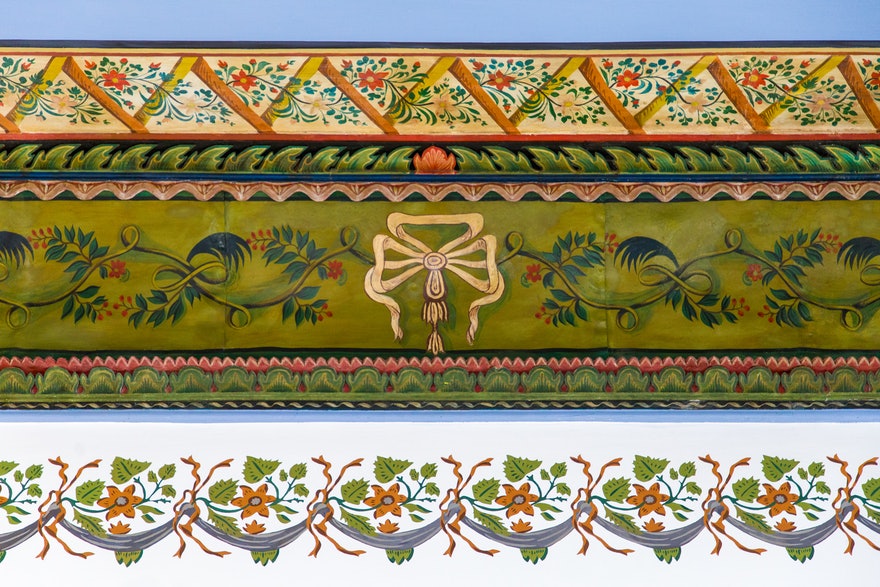
Detail from the restored frieze in the House of ‘Abbúd, in honor of the Holy Family’s continued occupancy of the house, following the downfall of Muḥammad-Yúsuf Páshá. Source: Bahá'í World News Service © Bahá'í International Community.
Muḥammad-Yúsuf Páshá’s demands of 'Abdu'l-Bahá remained aggressive after the passing of Ásíyih Khánum, and showed no compassion for the Holy Family’s grief. One day, a Christian merchant, hoping to gain something in the transaction, suggested 'Abdu'l-Bahá pay the Governor off. 'Abdu'l-Bahá told the merchant that the matter of a gift could be arranged, and retired to pray, while the merchant sat hoping for heavy coin purses.
When 'Abdu'l-Bahá returned, He instructed the merchant to go to the Governorate, where the insincere man was astounded to find out a cable had just arrived dismissing Muḥammad-Yúsuf Páshá and his associates for embezzlement. After Muḥammad-Yúsuf Páshá, the last two kind Governors of 'Akká during Bahá'u'lláh’s lifetime were Aḥmad Páshá and ‘Árif Effendi.
H.M. Balyuzi, Bahá'u'lláh: The King of Glory, pages 370-371.
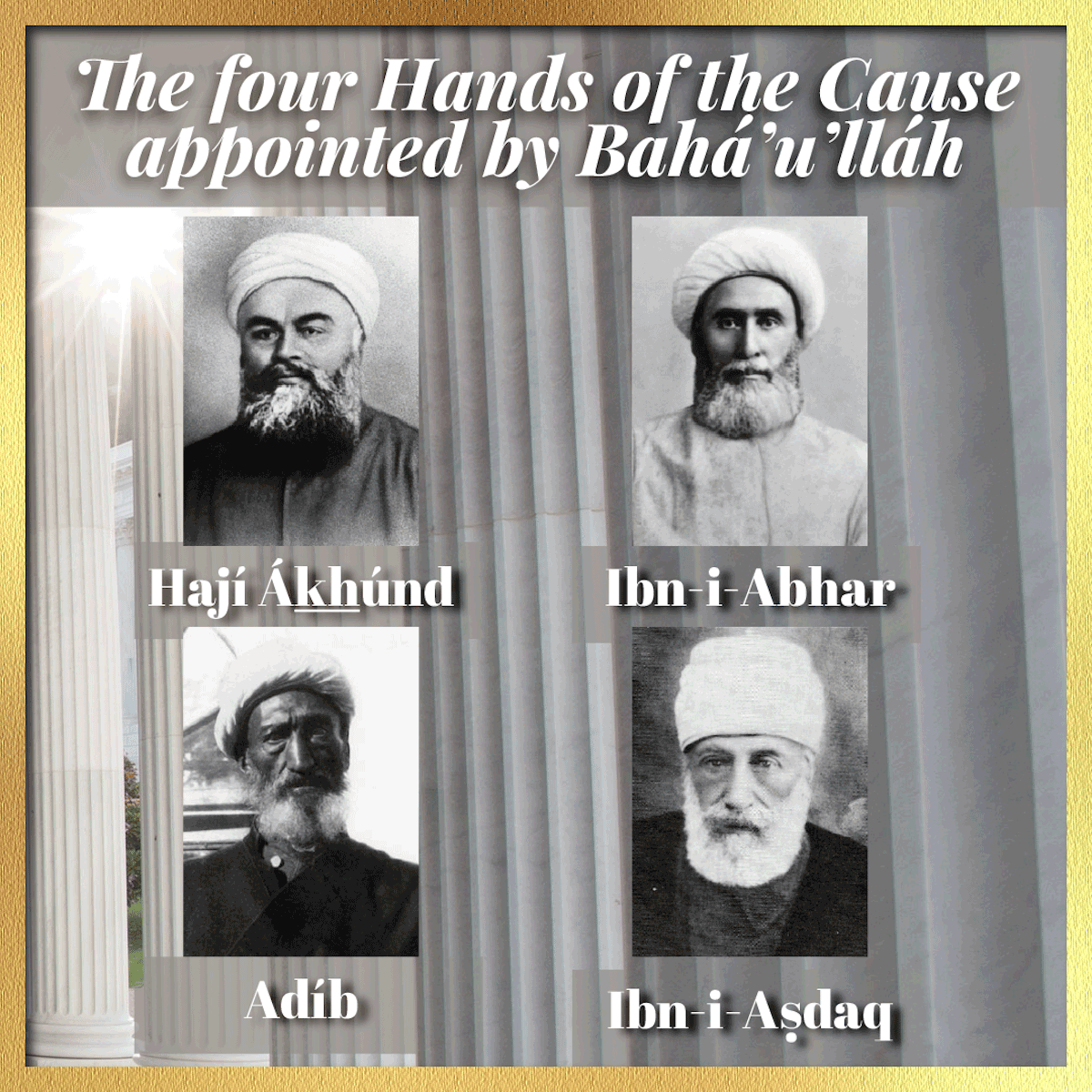
The four Hands of the Cause appointed by Bahá'u'lláh, top to bottom, left to right: Ḥají Mullá ʻAlí-Akbar Sháhmírzádí (Hají Ákhúnd), Ḥájí Mírzá Muḥammad-Taqí (Ibn-i-Abhar), Hájí Mírzá Ḥasan-i-Adíbu'l-ʻUlamá (Adíb) and Mírzá ʻAlí-Muḥammad-i-Khurásání (Ibn-i-Aṣdaq). All photos from Wikimedia Commons. Background: The colonnade at the entrance of the International Teaching Centre whose members, also appointed, fulfill the same mandates of protection and propagation of the Bahá'í Faith. Source: Source: Bahá'í Media Bank © Bahá'í International Community.
Towards the end of His life, Bahá'u'lláh ushered in the appointed branch of the Bahá'í Administrative Order, the Hands of the Cause, using the term for the first time in a Tablet revealed on 13 April 1887. Bahá'u'lláh appointed four Hands of the Cause in the last five years of His life: Hájí Ákhúnd, Ibn-i-Abhar, Ibn-i-Asdaq, and Ḥájí Mírzá Ḥasan, known as Adíb. Bahá'u'lláh showered His blessings on these four Hands of the Cause, revealing many Tablets in their honor in which He guided their steps, praised their work, and exalted their station in glowing terms, referring to them as “the Chosen Ones,” “the loved ones,” “the detached souls,” and “the pure in spirit.”
The role Bahá'u'lláh bestowed on the Hands of the Cause was to protect and promote His Cause, and Hands of the Cause would become instrumental in accompanying the growth and encouraging the health of the Bahá'í Faith, guiding and enthusing the believers, and deepening the Bahá'ís in their awareness and practice of the laws and principles of the Faith. Bahá'u'lláh describes the Hands of the Cause in another Tablet as guardians and custodians of the stronghold of His Faith, its protectors from the attacks of the ignorant and unfaithful, and lamps of guidance standing guard at the entrance of His mighty edifice against the onslaught of the ungodly.
During His last years, Bahá'u'lláh encouraged the Hands of the Cause to consult with each other and with Bahá'ís on issues vital for the growth and development of the faith, and the well-being and prosperity of believers, and, at a certain point in His ministry, deliberately declined to give advice on certain subjects, instead directing the petitioners to seek guidance on the subject. In 1891, the year before His Ascension, Bahá'u'lláh revealed a prayer for the Hands of the Cause in the second paragraph of the Lawḥ-i-Dunyá: “Light and glory, greeting and praise be upon the Hands of His Cause, through whom the light of fortitude hath shone forth and the truth hath been established that the authority to choose rests with God, the Powerful, the Mighty, the Unconstrained…”
Adib Taherzadeh, The Revelation of Bahá'u'lláh Volume 4: Mazra’ih and Bahjí 1877-1892, pages 275-293.
Prayer for the Hands of the Cause in the Lawḥ-i-Dunyá.
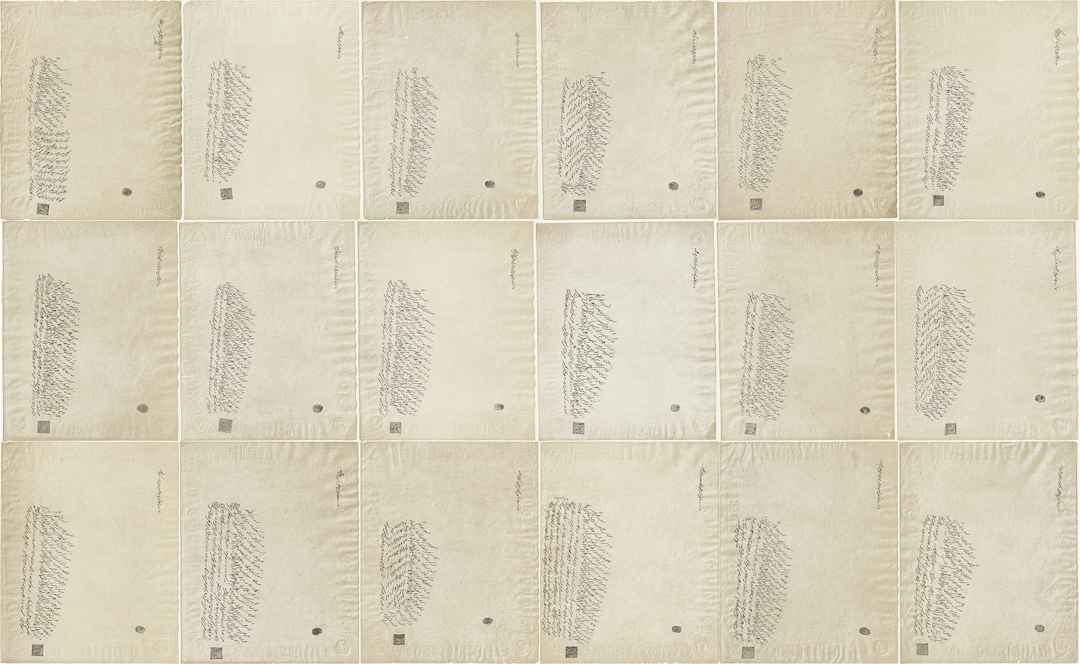
As a symbol of the content of the Dawn-Breakers, chronicling the Báb’s Dispensation, the facsimiles of the Báb’s Tablets to the Letters of the Living, the heroes and heroines who gave their lives for His Cause, from the First (Mullá Ḥusayn) to the Eighteenth (Quddús). Ṭihrán was the Seventeenth Letter of the Living.The full list is available here. Source: Nabíl, The Dawn-Breakers.
For decades, Nabíl had kept meticulous notes of the history of the Bábí and Bahá'í Faith, never missing an opportunity to interview early believers in great detail. His close friends began encouraging him to use these notes to write a chronicle of the history of the Faith, but Nabíl refused to begin without Bahá'u'lláh’s blessing. After Bahá'u'lláh expressed His pleasure at the project, Nabíl wrote for 18 months with very little editing before submitting the manuscript, initially called Táríkh-i-Nabíl (Nabíl’s history), for Bahá'u'lláh’s approval.
Mírzá Músá was one of Nabíl’s key sources, as one of the earliest Bábís to declare His Faith, and an eyewitness for 43 years of the most heroic episodes of the Faith. Mírzá Músá’s help and eyewitness accounts were so instrumental in the writing of his narrative that Nabíl thanked him in his acknowledgments.
Bahá'u'lláh encouraged Nabil in his important work, revealing two Tablets in his honor which gave Nabíl clear instructions about the narrative, advising him to neither exaggerate nor understate, and neither expand descriptions needlessly nor minimize the importance of certain events. Nabíl receiving Bahá'u'lláh’s corrections and approval on the manuscripts ten months later.
Nabíl’s own preface to the Dawn-Breakers is a tribute to the pure spirit of devotion in which he wrote his narrative, in complete submission to Bahá'u'lláh’s good pleasure: “I render thanks to God for having assisted me in the writing of these preliminary pages, and for having blessed and honoured them with the approval of Bahá'u'lláh, who has graciously deigned to consider them and who signified, through His amanuensis Mírzá Áqá Ján, who read them to Him, His pleasure and acceptance.”
Adib Taherzadeh, The Revelation of Bahá'u'lláh Volume 1: Baghdád 1853 - 1863, pages 204-205.
‘Alí Nakhjávání: Shoghi Effendi: The Range and Power of His Pen, Acuto, Italy 2006, pages 93-94.
We Are Bahá'ís: Nabil-i-A'zam: An Apostle of Baha'u'llah and the author of Dawn-Breakers.
Original 1888 Acknowledgements to Táríkh-i-Nabíl (Nabíl’s history), signed by Muḥammad-I-Zarandí (Nabíl-i-‘Aẓam), and dated 1305 A.H. (1887-1888)
DATE
From Nabil’s acknowledgements.
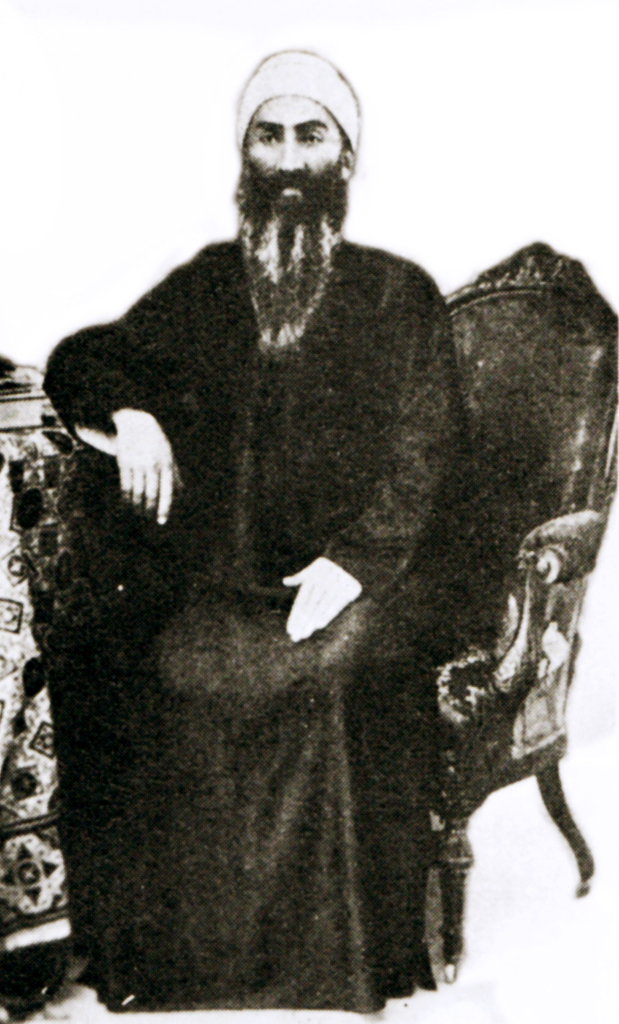
Mírzá Músá, Bahá'u'lláh's lifelong faithful and devoted brother, and Apostle of Bahá'u'lláh. Source: Bahá'u'lláh: The Glory of God.
Mírzá Músá-i-Núrí, titled Áqáy-i-Kalím (Master of Discourse), was Bahá'u'lláh’s younger brother by one or two years, born in either 1818 or 1819. In His eulogy of Mírzá Músá, 'Abdu'l-Bahá calls him Bahá'u'lláh’s “true brother,” who formed an extraordinary attachment to Bahá'u'lláh from the time he was a baby. Mírzá Músá was utterly detached from material things, caring only to live according to the teachings of the Faith, and that, by his pure character, he shone “like a bright lamp” in the Holy Family, with, as his one supreme desire, to serve Bahá'u'lláh. Mírzá Músá was also deeply knowledgeable about all aspects of herbal medicine, which he practiced.
Shoghi Effendi called Ásíyih Khánum and Mírzá Músá the “twin pillars who, all throughout the various stages of Bahá’u’lláh’s exile from the Land of His Birth to the final place of His confinement, had demonstrated, unlike most of the members of His Family, the tenacity of their loyalty,” describing Mírzá Músá as Bahá'u'lláh’s “staunch and valued supporter, the ablest and most distinguished among His brothers and sisters, and one of the “only two persons who,” according to Bahá’u’lláh’s testimony, “were adequately informed of the origins” of His Faith.”
In the space of one year, Bahá'u'lláh lost these “twin pillars” of loyalty and steadfastness, at His side for five and seven decades. After Mírzá Músá’s passing, Bahá'u'lláh revealed a touching Tablet of Visitation for him in which He emphasizes Áqáy-i-Kalím’s lifelong steadfastness, faith, and companionship. This Tablet of Visitation is now available provisionally translated into English for the first time thanks to Adib Masumian.
In this moving Tablet, Bahá'u'lláh refers to Mírzá Músá’s death as the “direst of calamities, the most grievous of afflictions,” showering His brother with praises for his loyalty and steadfastness in times of Covenant-breaking, calling him “faithful to the Covenant at a time when the people of sedition had broken it,” attesting that Mírzá Músá quaffed “the choice sealed Wine when its seal was opened in His Name, the Self-Subsisting,” a reference to Mírzá Músá being one of Bahá'u'lláh’s first followers, and outlines every one of His exiles, each shared by Mírzá Músá, who always remained “in the company of thy Lord,” departing with Him, arriving with Him, entering the Most Great Prison with Him, and “present before this Wronged One every morn and eve.”
Shoghi Effendi elevated Mírzá Músá to the rank of Apostle of Bahá'u'lláh, placing His name first in his graphic announcement in the Bahá'í World Volume III (1928 – 1930) on page 92, under the heading under the heading The Apostles of Bahá'u'lláh: Pillars of the Faith.
Gail, Marzieh, Dawn Over Mount Hira, pages 94-95.
H.M. Balyuzi, Bahá’u’lláh: The King of Glory, pages 137.
Shoghi Effendi, God Passes By, Excerpt 1 and Excerpt 2.
Adib Taherzadeh, The Revelation of Bahá'u'lláh Volume 3: ‘Akká, the Early Years 1868-1877, page 361.
‘Abdu’l-Bahá, Memorials of the Faithful: His Eminence Kalím (Mírzá Músá)
'Abdu'l-Hussayn Fikri, Ḥawáríyyú Ḥaḍrat-i-Bahá’u’lláh, p. 14.
Shoghi Effendi, Bahá'í Administration.
The Bahá'í World Volume III, (1928-1930), page 92
BAHÁ'U'LLÁH’S TABLET OF VISITATION FOR MÍRZÁ MÚSÁ
Partial Inventory ID: BH02247
Original Persian and Arabic text of this Tablet of Visitation in Iranian National Bahá’í Archives, Volume 65, pages 87–92.
Adib Masumian: Provisional translation Baha’u’llah’s Tablet of Visitation for His Brother, Mírzá Músá, (Áqáy-i-Kalím).
Many thanks to Mona Mehregani-Tekie for providing photographs of the Tablet in the original language and to Adib Masumian for locating this Tablet in the Partial Inventory, and graciously providing an elegant and beautiful provisional translation.
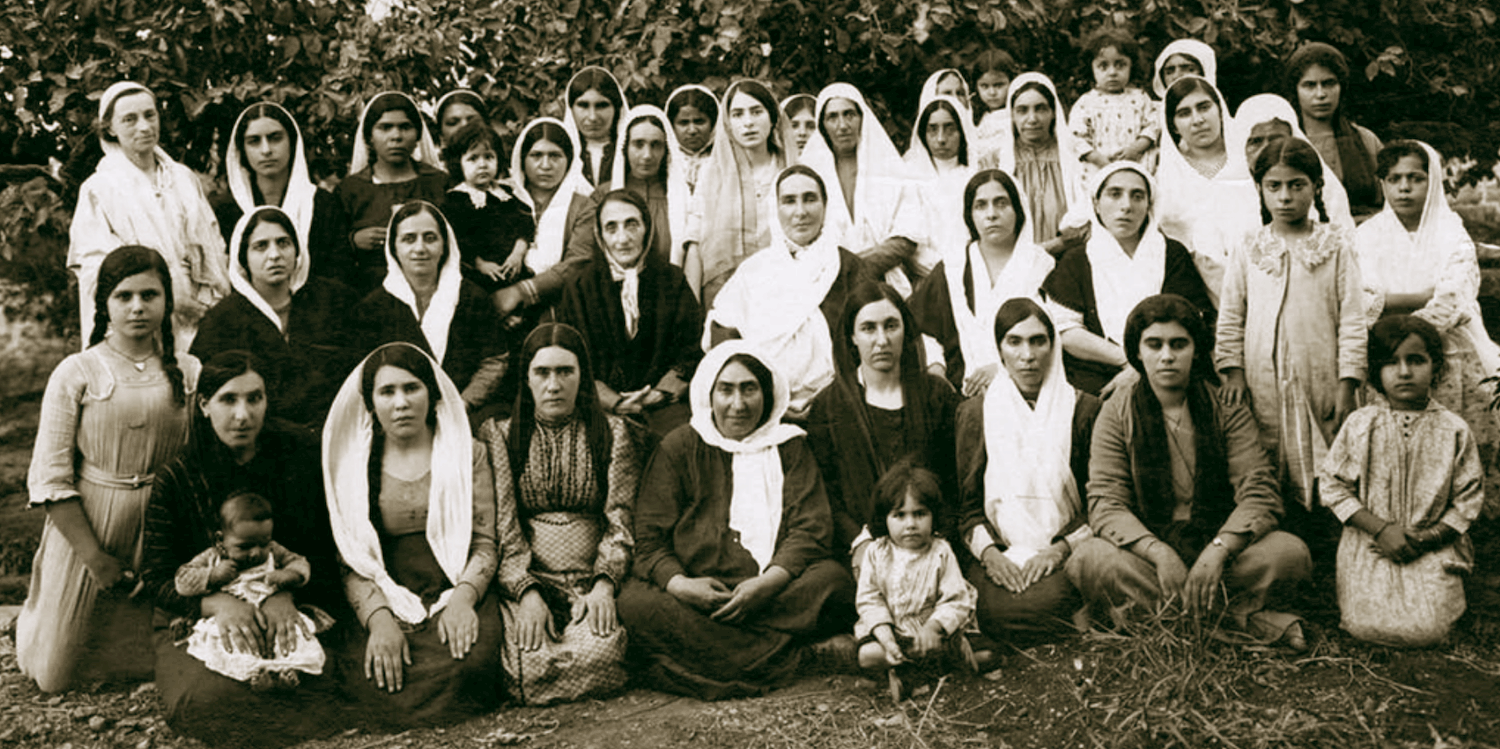
Bahá'u'lláh’s four granddaughters are seated, with white headscarves, on either side of Bahíyyih Khánum and Munírih Khánum in the center. From the left, His first two granddaughters are Munavvar Khánum and Ṭúbá Khánum, and from the extreme right, Ḍíyá‘íyyih Khánum (‘Abdu'l-Bahá and Munírih Khánum's eldest, Shoghi Effendi’s mother), with Rúḥá Khánum sitting to her right. Source: Daily Baha'i Photos Website.
'Abdu'l-Bahá's children were close to Bahá'u'lláh, their adored Grandfather. When Bahá'u'lláh was in ‘Akká, they had morning tea with Bahá'u'lláh, who chanted prayers and told spiritual stories to the children about Manifestations of God, the Prophet Muḥammad, Jesus Christ, Moses, and the Virgin Mary.
Bahá'u'lláh’s grandchildren confided in Him, telling Him all their little problems, and He took an interest in everything that concerned them, even sending a servant to Beirut, Lebanon, each year to purchase fabric for their new clothes. When the fabrics arrived, Bahá'u'lláh would call in the children to pick their favorites, and their mother and aunt would sew new clothes for them.
Bahá'u'lláh gave His grandchildren treats on Holy Days, and when He was offered boxes of sweetmeats, He always kept some aside for the children, saying in jest: "Put that box of sweets over there, or Áqá ['Abdu'l-Bahá] will give it away to the people." On the evenings when Bahá'u'lláh was staying in the house of ‘Abbúd, He would call in the little ones and speak loving words to them, dismissing 'Abdu'l-Bahá and Munírih Khánum’s concerns about the children disturbing Him, saying "Let the dear children come in, and have some dessert."
Bahá'u'lláh’s visits to ‘Akká and their excursion to the garden of Riḍván with their blessed Grandfather were cherished and exciting moments for the children who endured long, monotonous and school days in the Khán-i-Ávámid.
Lady Blomfield, The Chosen Highway, pages 97-98.
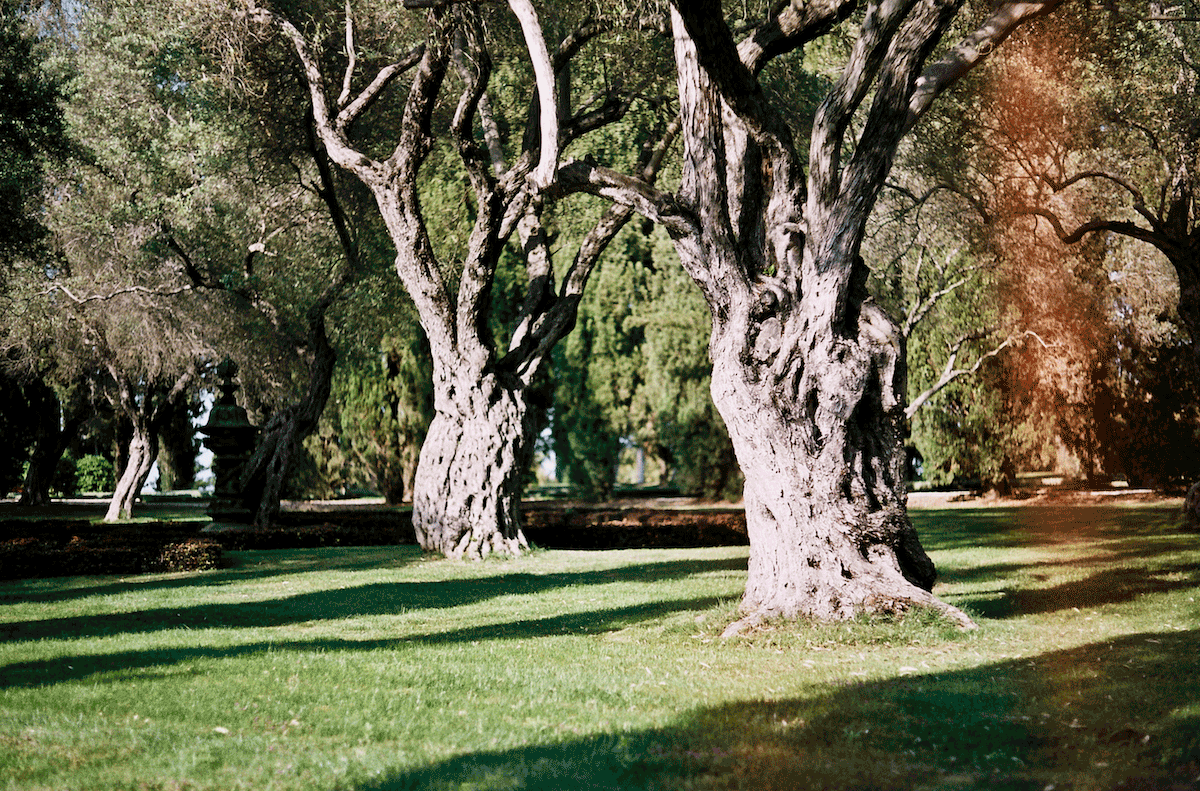
In honor of four-year-old Ḥusayn’s Effendi love of sightseeing, the tamáshá he endearingly pronounced tabashá, and his many adventures with his beloved grandfather Bahá'u'lláh in the Mansion of Bahjí, a wild grassy corner of the gardens near the Mansion with stately centuries-old olive trees. © Chad Mauger, all rights reserved, used with permission. Source: Flickr.
'Abdu'l-Bahá and Munírih Khánum’s son Ḥusayn Efendi was born in 1884, and was the delight of Bahá'u'lláh, spending long periods of time with His Grandfather in Bahjí. He was a very special little boy, eager and vivacious and loved by all. From Baharieh Ma’ani’s research, it seems that for a time. Bahá'u'lláh was very attached to Ḥusayn Effend and often mentioned him in very sweet Tablets: “O Ḥusayn Effendi! Upon thee be God's peace and His favour. Yesterday We were in Junaynih. Some pomegranate was found and sent. We instructed Muṣṭafá, should he find something else in the city, to procure it and send it with the pomegranate. A small sum of money was also sent.”
Ḥusayn Effendi endearingly mispronounced the Persian word for his favorite activity, tamáshá (Sightseeing), and Bahá'u'lláh lovingly used the little boy’s new word, tabashá, in many Tablets He revealed for Munírih Khánum.
When beloved Ḥusayn effendi passed away at the age of four in 1888, Munírih Khánum was beside herself with grief and Bahá'u'lláh revealed Tablets to comfort her, writing “The knowledge of the reason why your sweet baby was been called back is in the mind of God and will be manifested in His own good time. To the prophets of God the present and the future are as one.”
Ḥusayn Effendi was laid to rest in the Muslim cemetery of ‘Akká, where Bahá'u'lláh’s beloved Ásíyih Khánum and His brother Mírzá Músá had been laid to rest just three and two years prior, and Bahá'u'lláh revealed the epitaph for the little boy’s tombstone: “He is the Eternal! Ḥusayn son of ‘Ayn ['Abdu'l-Bahá] Wealth and children are the adornments of this present life; but good works, which are lasting, are better in the sight of thy Lord as to recompense and better as to hope. This son hath been an adornment of the Most Exalted Paradise and We see him now, through God’s Grace and bounty, engaged in sightseeing in the heavenly realms.”
In the original Tablet in Persian, it was Ḥusayn Effendi’s word for “sightseeing” which Bahá'u'lláh chose to use.
Baharieh Rouhani Ma'ani, Leaves of the Twin Divine Trees, pages 321-324.
David S. Ruhe, Door of Hope: The Bahá’í Faith in the Holy Land, page 51.
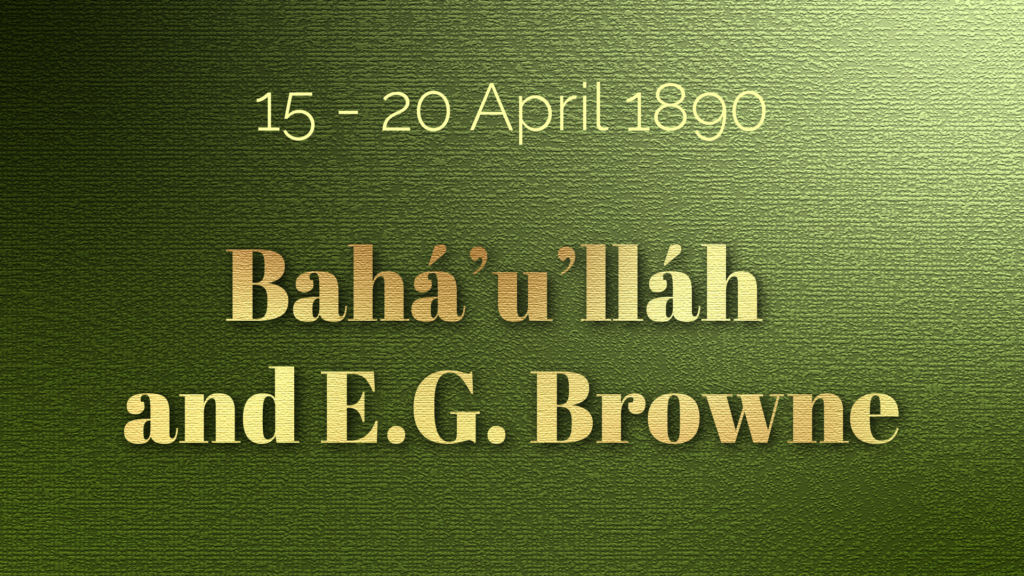
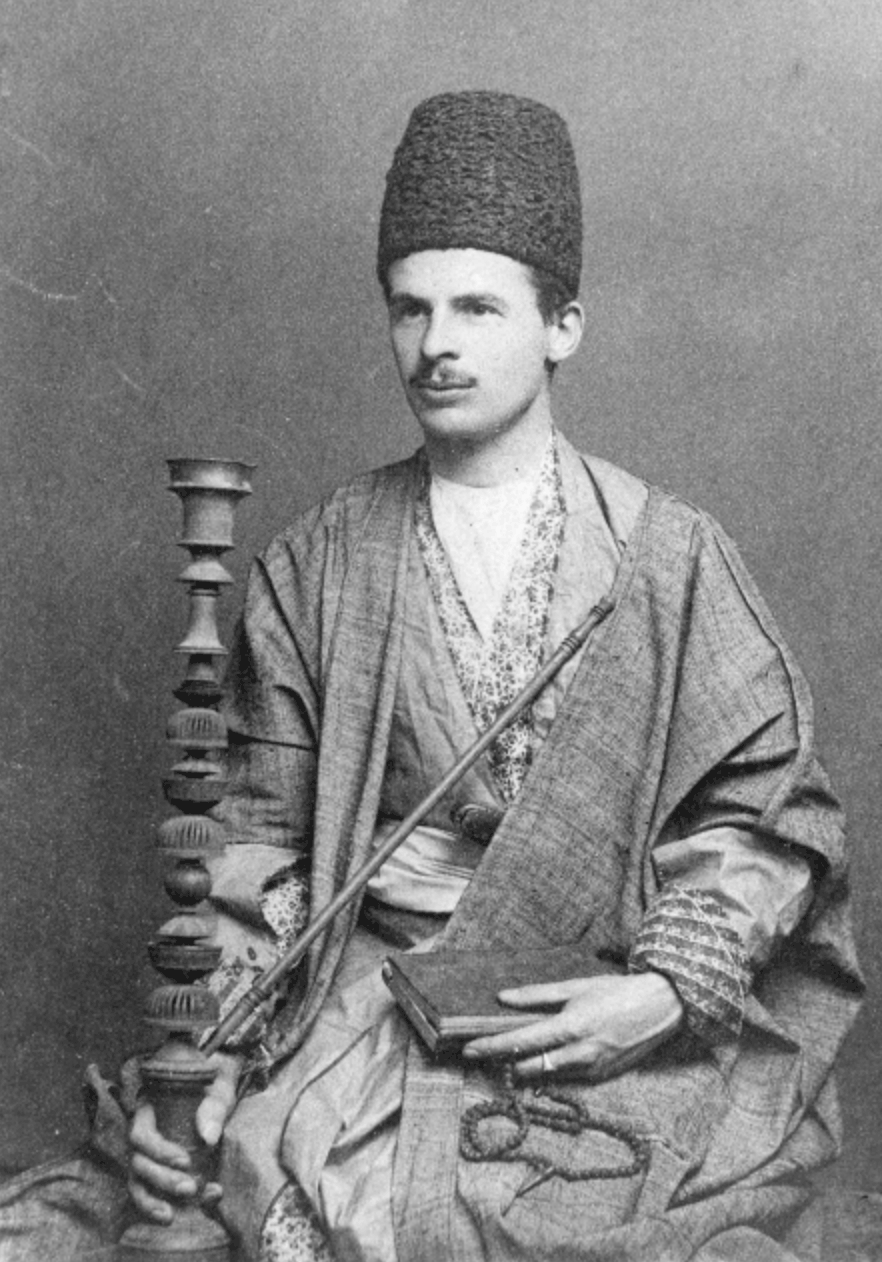
Edward Granville Brown (1862 – 1926). Source: Baha'i Blog.
Edward Granville Browne was an eminent orientalist, who spoke Persian exceedingly well. He became fascinated with the Bábí Faith after discovering it in 1884 in Count Gobineau’s Religions and Philosophies in Central Asia, and when he traveled throughout the entire length and breadth of Persia in 1887 – 1888, he visited most of the places associated with the Báb’s ministry, such as the Fort of Shaykh Ṭabarsí. He sought out Bábís, met Ḥájí Mírzá Ḥaydar-‘Alí, who made a profound impression on him, and conceived the idea of meeting Mírzá Yaḥyá and Bahá'u'lláh. Edward Granville Browne would never understand that Bahá'u'lláh’s Revelation had absorbed and sublimated the Bábí Faith. Browne believed both religions still existed, and referred to them as “Old Bábíism,” led by Mírzá Yaḥyá, and the “New Bábís,” followers of Bahá'u'lláh.
Back in Cambridge after his year in Persia, Browne dedicated himself to planning a trip to Cyprus and 'Akká to learn from Mírzá Yaḥyá and Bahá'u'lláh, in his eyes the most prominent “Bábís” to have been closely associated with the Báb. On 1 January 1889, Browne wrote a letter stating his ardent wish to meet Bahá'u'lláh in 'Akká, and “get as accurate an account of all the details connected with the Bábi movement as possible,” and located Mírzá Yaḥyá in Famagusta through sheer determination, proceeding to correspond with the Azalí leader for 9 months. Mírzá Yaḥyá won Browne over with an active correspondence in which he discussed Bábí doctrine and literature, offering Browne the gift of a rare manuscript of the Báb.
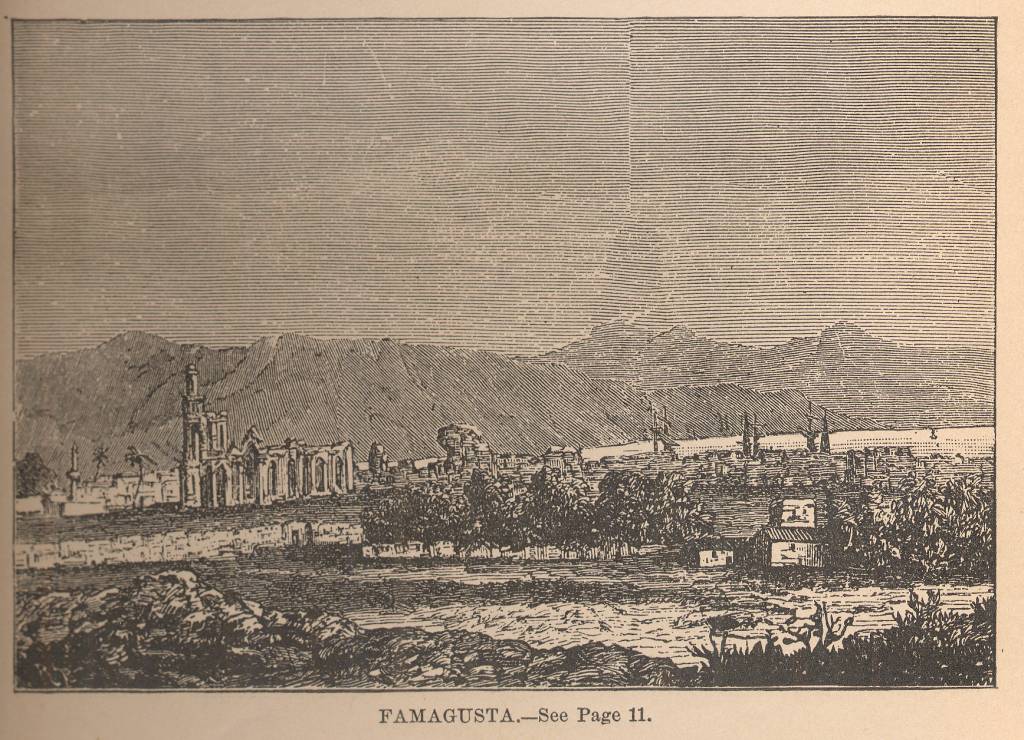
Famagusta, Cyprus in 1878. Source: Wikimedia Commons.
E.G. Browne obtained a sabbatical from Cambridge from 4 March to 3 May 1890, and his first stop was Cyprus, where he arrived on 19 March 1890. He spent two weeks in Famagusta, meeting with Mírzá Yaḥyá for several hours every day and taking copious notes. It seems Browne took it upon himself to bestow an invented title on Mírzá Yaḥyá, calling him “the Fourth Letter of the First Unity.”
Browne sailed to Beirut on 5 April 1890, where he obtained Bahá'u'lláh’s permission to travel to 'Akká, journeying by mule overland in the company of the British Vice-Consul. Edward Granville Browne arrived in 'Akká on 13 April 1890, only to find out that both Bahá'u'lláh and 'Abdu'l-Bahá were in Haifa.
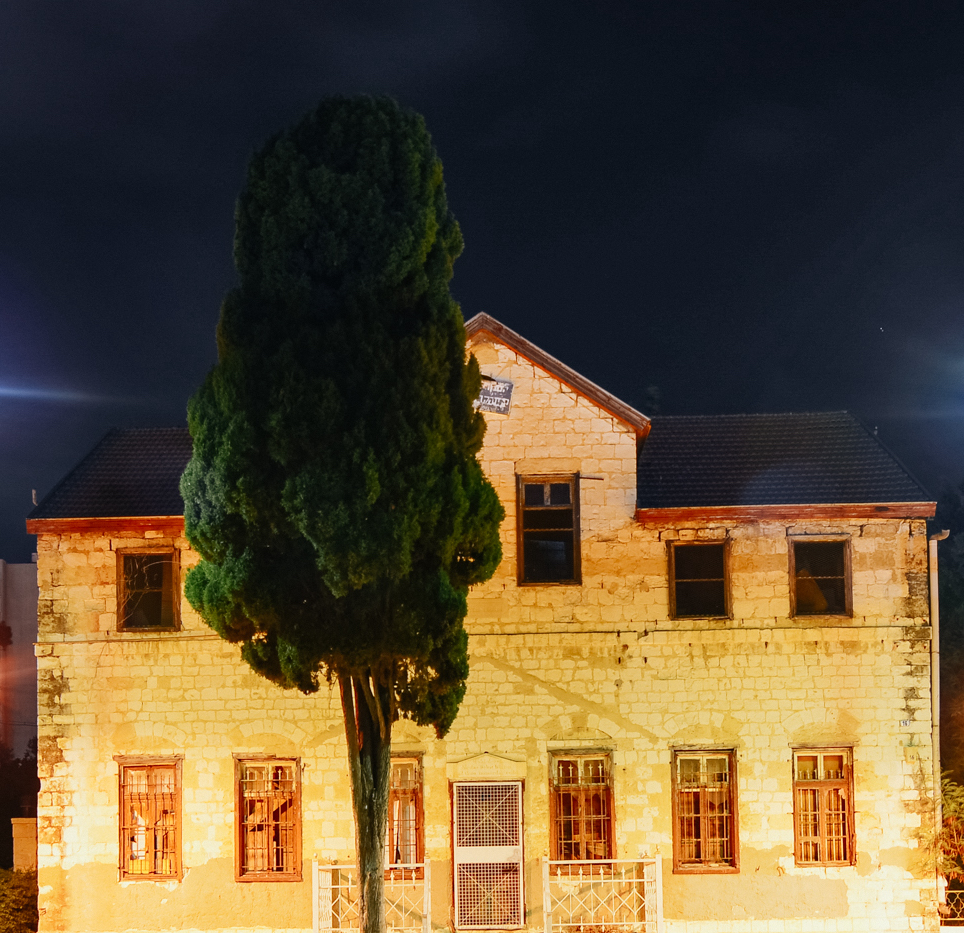
Oliphant House in the German Templer Colony in Haifa, where Bahá'u'lláh first pitched His tent across, then later stayed in, on His third visit to Haifa. Today Oliphant House is the home of the Memorial Center for Druze Soldiers. Source: Wikimedia Commons.
Bahá'u'lláh arrived in Haifa for His third visit on 1 April 1890, stating the date in a Tablet He revealed the next day: “Thanks to the Desire of the Worlds that in the middle of tribulations, the banner of speech was raised up…yesterday, 10 of Sha’aban 1307 (1 April 1890), the Lord of Creation (The Father) moved from the shore of Akka to Haifa and arrived during the night…”
When Bahá'u'lláh first arrived in Haifa, His tent was raised on a vacant plot of land across from Oliphant House and next to the German Templers’ Community Hall, the very first building David Hardegg built in the Colony, and which served as their spiritual gathering place and their children’s school. He later moved into a room in Oliphant House, and 'Abdu'l-Bahá joined Him in Haifa sometime before 15 April 1890, by which time Bahá'u'lláh was in Bahjí, and 'Abdu'l-Bahá had gone to 'Akká to welcome Edward Granville Browne.
Fuad Izadinia, The Major Opus: A study of the German Templer movement and its relationship with the Bahá'í Faith.
Shoghi Effendi, God Passes By.
H.M. Balyuzi, Bahá'u'lláh: The King of Glory, pages 373-374.
Bahá'u'lláh quoted in J.E. Esslemont’s Bahá'u'lláh and the New Era.
The Bible, King James Version, Amos 1:2, Psalms 50:3, Isaiah 2:2.
DATE
Fuad Izadinia, The Major Opus.
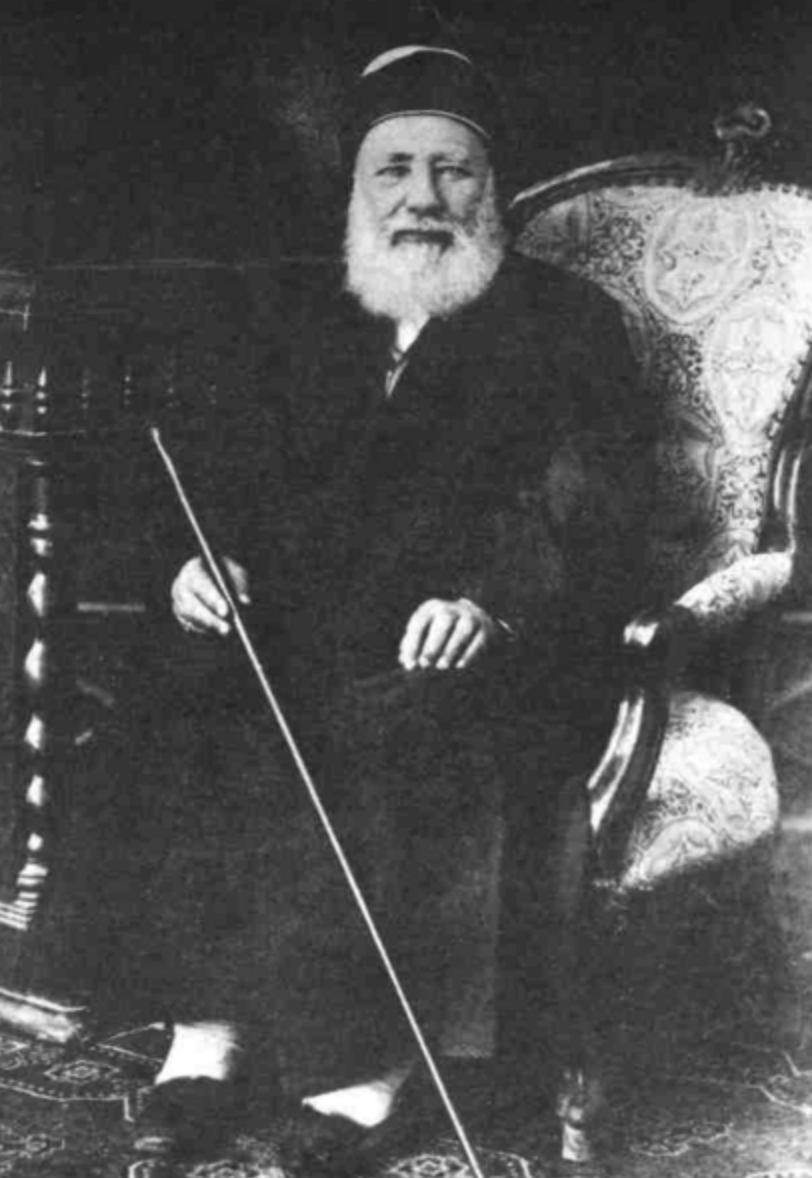
The venerable and eminent Afnán-i-Kabir, member of the Báb’s family, who made such a profound impression on Edward Granville Browne during his five days in Bahjí from 15 – 20 April 1890. Source: Bahaipedia.
'Abdu'l-Bahá returned from Haifa on Tuesday 15 April 1890 and offered E.G. Browne lunch. 'Abdu'l-Bahá made a great impression on the British Orientalist, who painted a vivid pen-portrait of the Master, attesting to His greatness and power, and describing Him as eloquent, majestic, and welcoming.
After lunch, 'Abdu'l-Bahá, had Browne’s belongings gathered and took him through the Land Gate, arriving in Bahjí, after a 15-minute donkey ride. Edward Granville Browne was deeply moved to meet Afnán-i-Kábir, a cousin of the Báb and the brother of Khadíjih Bagúm, and listened to him with wrapt interest.
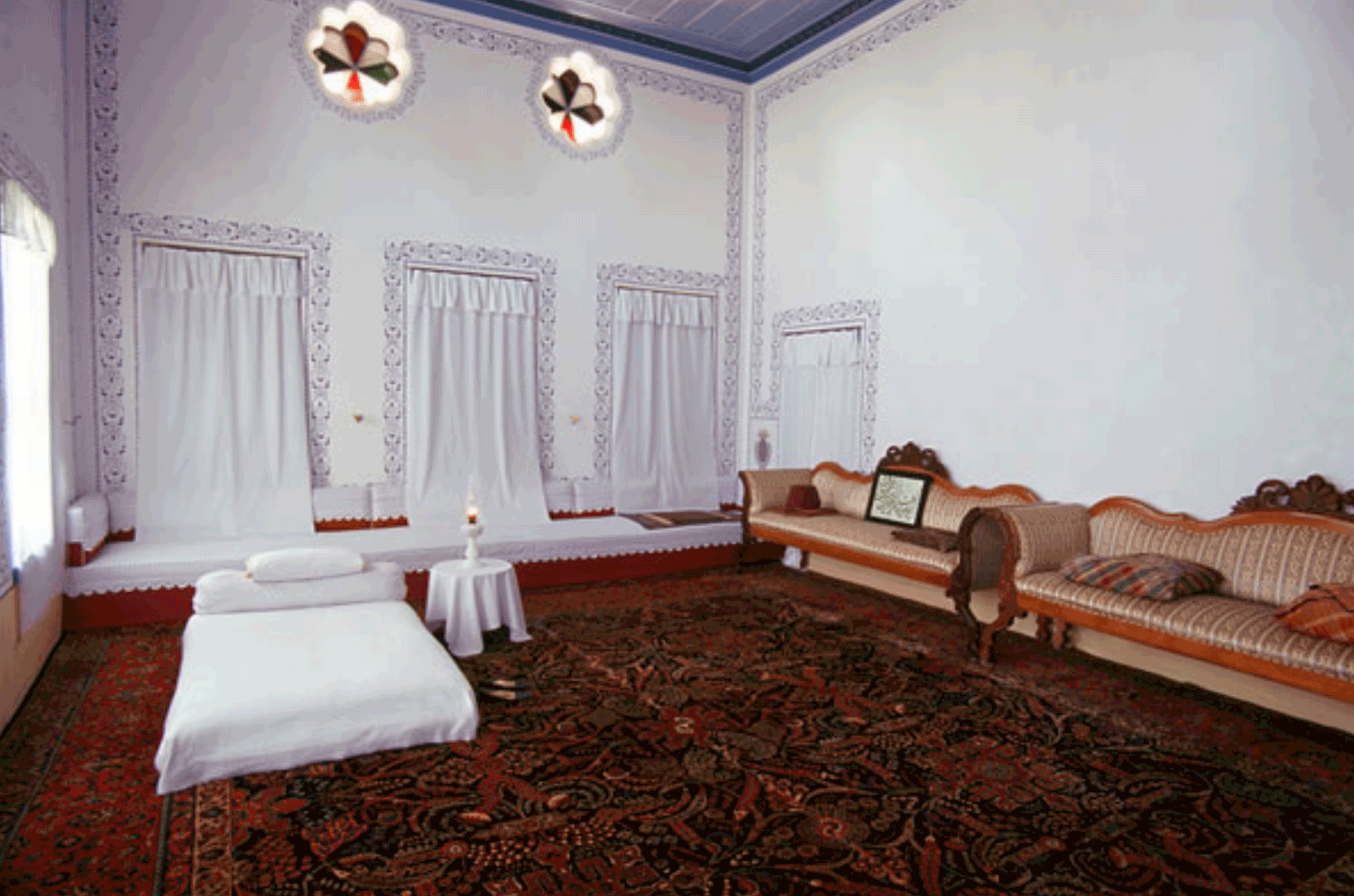
The room of Bahá’u’lláh at the Mansion of Bahjí where E.G. Browne first entered His presence on 16 April 1890. Source: The Life of Bahá'u'lláh: A Photographic Narrative. Photograph by Denny Allen (2000), © Bahá'í International Community.
The next day, one of Bahá'u'lláh’s younger sons led Browne through passages and rooms he barely noticed, and a spacious hall with a marble mosaic. He removed his shoes in the ante-chamber of Bahá'u'lláh’s room, while the young man drew back the curtain back in a quick movement, closing it behind Edward Granville Browne after he entered the room.
Edward Granville Browne had arrived in a large room lined on its upper end by a long, low divan, and two or three chairs placed along the wall opposite the door. He had not been explicitly told that he was about to meet Bahá'u'lláh, but Browne suspected that might be the case, and after a second or two, with a throb of wonder and awe, he realized he was not alone in the room.
Seated in the corner, where the divan met the wall, Browne described Bahá'u'lláh as “a wondrous and venerable figure,” as he bowed before the Blessed Beauty, the “object of a devotion and love which kings might envy and emperors sigh for in vain!” Bahá'u'lláh’s head was “crowned with a felt headdress of the kind called táj by dervishes (but of unusual height and make), round the base of which was wound a small white turban.”
Browne would never forget Bahá'u'lláh’s face, but neither was he able to describe it, though he remembered “piercing eyes” which “seemed to read one's very soul,” and an aura of power and authority emanating from Bahá'u'lláh, noticing that the deep lines of Bahá'u'lláh’s face implied an age contradicted by “the jet-black hair and beard flowing down in indistinguishable luxuriance almost to the waist.”
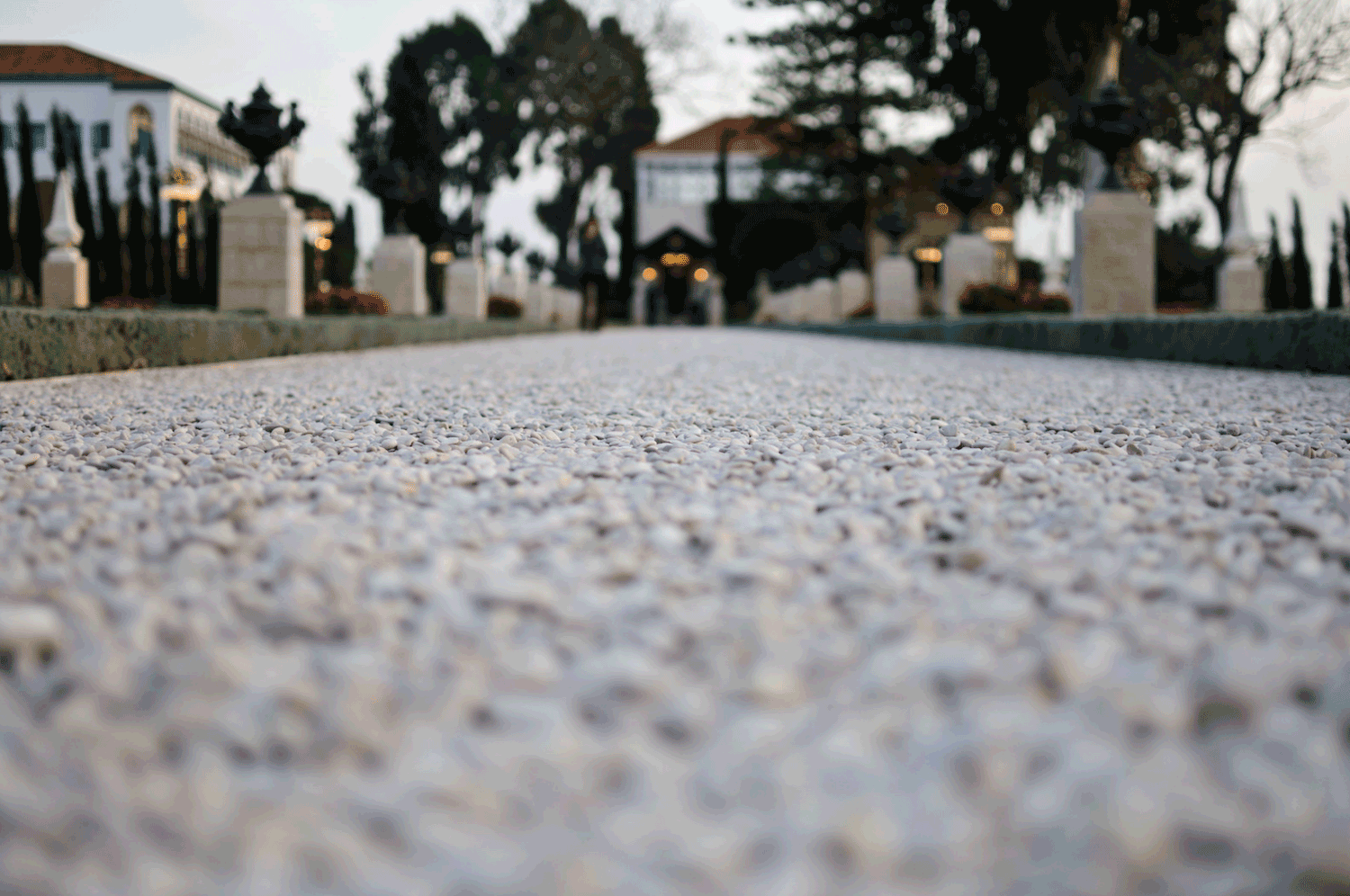
As an illustration for Edward Granville Browne’s nearsightedness when it came to the station of Bahá'u'lláh, an exquisite photograph that shows the pebbles on the ground in focus, while the Shrine of Bahá'u'lláh, the subject of the picture, is out of focus. The tragedy of E.G. Browne, despite the priceless bounty of spending five days near Bahá'u'lláh, is that he never truly understood His station. © Chad Mauger, all rights reserved, used with permission. Source: Flickr.
Bahá'u'lláh invited Edward Granville Browne be seated in a mild, dignified voice, then spoke momentous words: "Praise be to God that thou hast attained!…Thou hast come to see a prisoner and an exile… We desire but the good of the world and the happiness of the nations; yet they deem us a stirrer up of strife and sedition worthy of bondage and banishment…That all nations should become one in faith and all men as brothers; that the bonds of affection and unity between the sons of men should be strengthened; that diversity of religion should cease, and differences of race be annulled - what harm is there in this?…Yet so it shall be; these fruitless strifes, these ruinous wars shall pass away, and the 'Most Great Peace' shall come…Do not you in Europe need this also? Is not this that which Christ foretold?…Yet do we see your kings and rulers lavishing their treasures more freely on means for the destruction of the human race than on that which would conduce to the happiness of mankind…These strifes and this bloodshed and discord must cease, and all men be as one kindred and one family…Let not a man glory in this, that he loves his country; let him rather glory in this, that he loves his kind…"
Those words were the only ones Edward Granville Browne was able to recall later, although Bahá'u'lláh spoke much more to him in the twenty minutes the interview lasted. Browne also remembered that Bahá'u'lláh read excerpts from a long Tablet which has since been published as selection N° CXXXII in Gleanings from the Writings of Bahá'u'lláh, and contains two celebrated excerpts: “The Purpose of the one true God, exalted be His glory, in revealing Himself unto men is to lay bare those gems that lie hidden within the mine of their true and inmost selves,” and “The utterance of God is a lamp, whose light is these words: Ye are the fruits of one tree, and the leaves of one branch. Deal ye one with another with the utmost love and harmony, with friendliness and fellowship.”
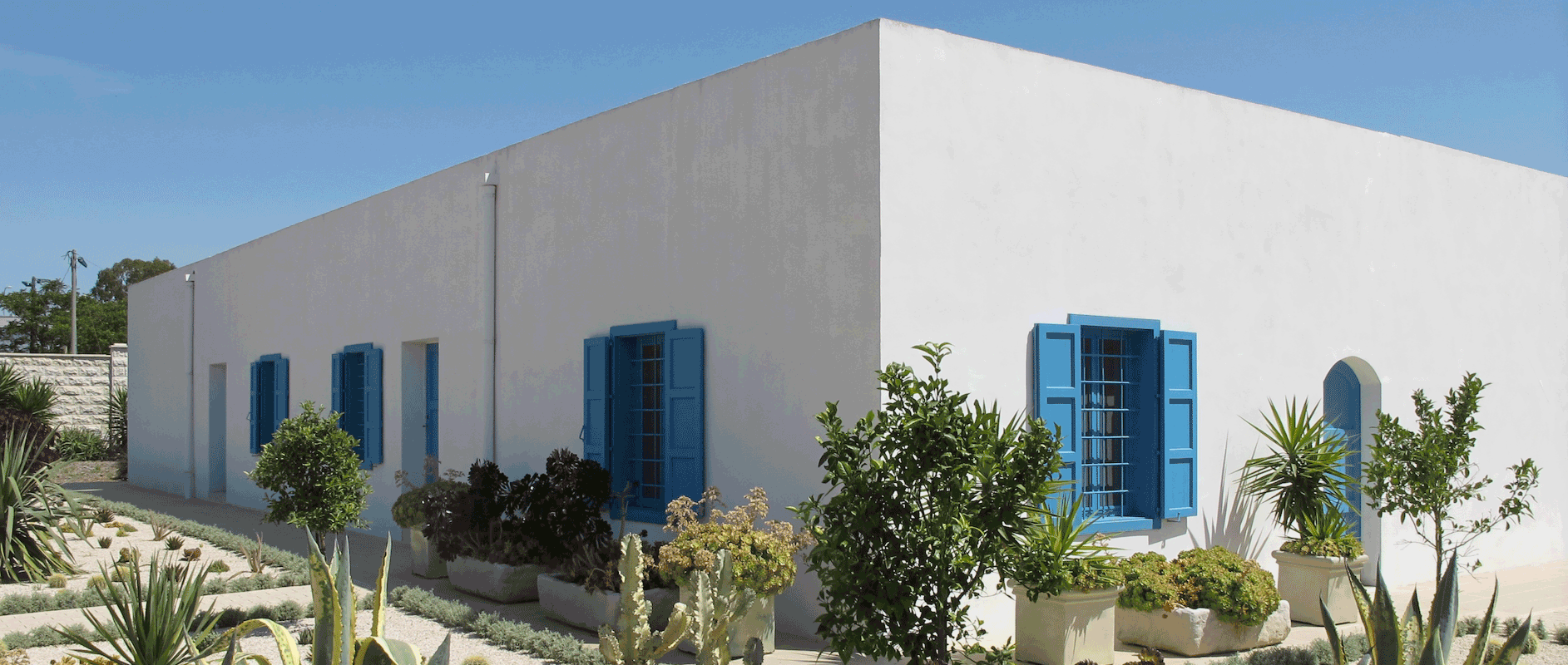
A modern view of the garden at Junaynih, one of the last places Edward Granville Browne saw Bahá'u'lláh before he left the Holy Land on 20 April 1890. Source: Reflections on the Bahá'í Writings.
Between 15 and 20 April 1890, Edward Granville Browne entered Bahá'u'lláh’s presence four times, each interview taking place an hour or two before lunch and lasting between between 20 and 30 minutes, with Mírzá Áqá Ján present on one occasion. Browne also caught sight of Bahá'u'lláh in the garden of Junaynih, walking with some believers.
E.G. Browne spent five memorable days in Bahjí, meeting eminent Bahá'ís, and surrounded with a profoundly spiritual atmosphere. Soon after his arrival, he had expressed a strong desire to learn more about the “later history of the Bábí” movement, and was given an anonymous Persian manuscript called Maqáliy-i-Shakhṣ-i-Sayyáḥ in the handwriting of Zaynu’l-Muqarrabín, the most eminent of transcriber of Bahá’u’lláh’s Writings. The book was A Traveler’s Narrative, authored by 'Abdu'l-Bahá Himself, and Browne would translate and publish in 1893.
In the course of his stay, Browne mentioned that his copy of the Kitáb-i-Íqán had suffered damage and was illegible in parts and he received a new copy of the Íqán, also transcribed by Zaynu’l-Muqarrabín, as a gift. When it was time for Edward Granville Browne to return to Cambridge, the Bahá'ís in the Holy Land helped him with his travel arrangement, insisting Ḥájí Siyyid ‘Alí accompany him overland to Beirut.
Bahá'u'lláh mentioned Edward Granville Browne in only one Tablet, offering a prayer for the success of his spiritual endeavors: “The youth mentioned therein [Edward Granville Browne] attained Our presence. Although this Wronged One had not consorted for many years past with people from foreign lands, We received him on several occasions. Portents of sincerity could be discerned on his visage. We beseech God to aid him in such undertakings which would be conducive to the effacement of mischief and the promotion of the betterment of the world.”
H.M. Balyuzi, Edward Granville Browne and the Bahá'í Faith, pages 14-61.
Edward Granville Browne’s introduction to 'Abdu'l-Bahá, A Traveler’s Narrative, pages i to xlv.
Wikipedia: Edward Granville Browne.
David S. Ruhe, Door of Hope: The Bahá’í Faith in the Holy Land, page 120.
TABLET READ BY BAHÁ'U'LLÁH TO EDWARD GRANVILLE BROWNE
Partial Inventory ID: BH00272
Original Tablet in Mixed Persian and Arabic on Bahá'í Reference Library.
First excerpt/Partial translation from Shoghi Effendi in Gleanings from the Writings of Bahá'u'lláh, N°CXXVI
Second excerpt/Partial translation from Shoghi Effendi in Gleanings from the Writings of Bahá'u'lláh, N°CXXXII
- Edward Granville Browne mentions in his introduction to A Traveler’s Narrative, on page xli that the excerpt is on pages 70-71.
- Using the version of the original edition of A Traveler’s Narrative from the Internet Archive, the relevant excerpt on pages 70-71 was found.
- Relevant excerpt on Bahá'í Reference Library: 'Abdu'l-Bahá, A Traveler’s Narrative,
TABLET OF BAHÁ'U'LLÁH MENTIONING EDWARD GRANVILLE BROWNE
Partial Inventory ID: BH03065
Many thanks to Adib Masumian for helping source the Tablets of Bahá'u'lláh and providing photographs for both Tablets in the original language.
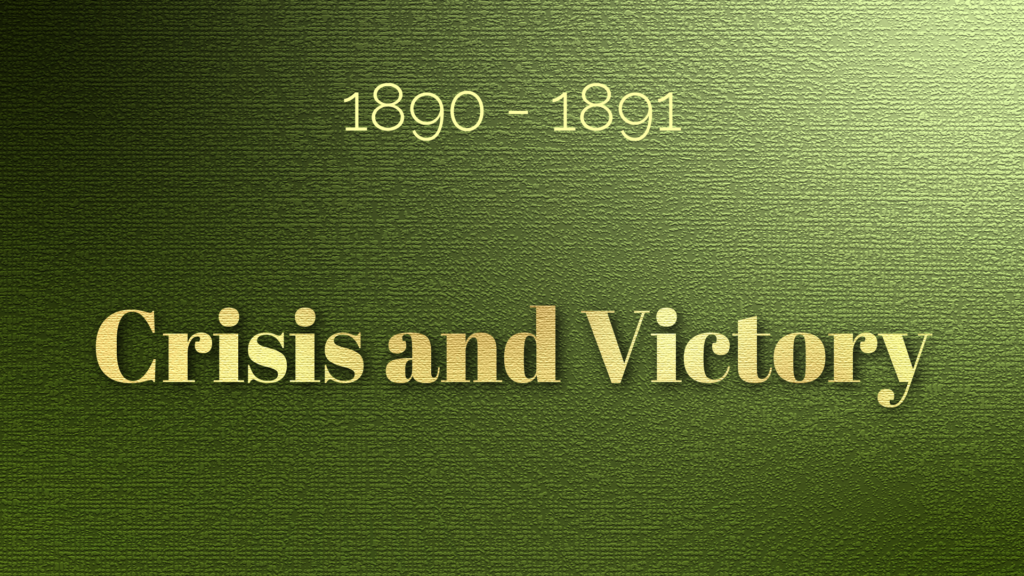
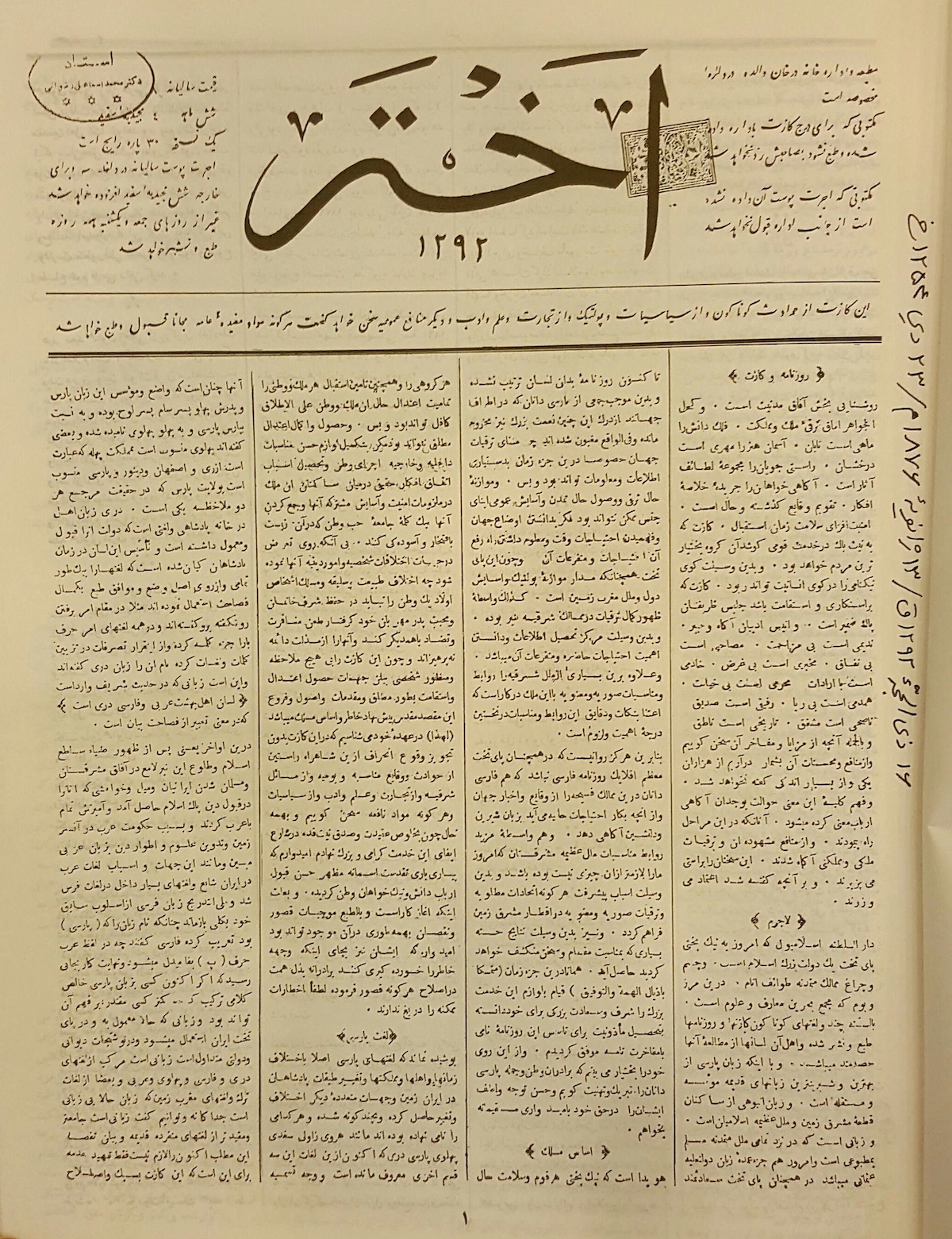
Front page of Akhtár issue N° 1 dated 13 January 1876. Source: Wikimedia Commons.
In the late 1880s and early 1890s, Constantinople became a center for the activities of the Azalís, form where they did their utmost to inflict harm on Bahá'u'lláh and the Bahá'í Faith, and a powerful tool at their disposal: their very own newspaper, in which they had the freedom to publish any lie, fabrication or insult they wanted about the Bahá'í Faith. Akhtar (Star) was a Persian newspaper, and the Azalís took control of it from its owner, using it to their own nefarious end. Bahá'u'lláh summarized the Azalís’ media activities in Epistle to the Son of the Wolf: “they have incited a great many such as Akhtar and others, and are busying themselves in spreading calumnies.”
The Azalís’ malevolent activities in Constantinople cast a dark shadow over Baha'u'llah's last years, the following being a small sample of their evil deeds: they began a widespread defamation campaign against Bahá'u'lláh and the Bahá'í Faith, stole from Bahá'í businesses and accused innocent people of their crimes, destroyed the reputation of eminent Bahá'ís, including Afnán-i-Kabír, in the pages of Akhtar, including, spread despicable rumors about a Bahá'í named Ḥájí Shaykh Muḥammad-‘Alí which drove him to suicide, and lodged a complaint with the Persian Embassy claiming Bahá'ís had robbed them.
Bahá'u'lláh listed many of their wicked activities in Epistle to the Son of the Wolf, after denouncing them and the behavior of Ottoman officials: “In the Great City [Constantinople] they have roused a considerable number of people to oppose this Wronged One. Things have come to such a pass that the officials in that city have acted in a manner which hath brought shame to both the government and the people.”
Bahá'u'lláh sent several Bahá'ís to Constantinople to investigate malicious rumours, help resolve situations, and settle the affairs of Bahá'ís, including Ḥájí Javád Siyyid-i-Yazdí, Ḥájí Mírzá ‘Abu’l-Qásim-i-Náẓir, Áqá ‘Azízulláh-i-Jadhdháb, and asked Hand of the Cause Ḥájí Amín to help resolve an explosive situation relating to the Afnán’s trading house.
Unable to cope with the Azalí’s constant attacks, Ḥájí Shaykh Muḥammad-‘Alí committed suicide. The Persian ambassador attended his memorial service, and lamented the loss of such a kind, wise, knowledgeable man: “We had one merchant, wise, sagacious, a man of high integrity; and now we have lost him.”
H.M. Balyuzi, Bahá'u'lláh: The King of Glory, pages 385-402.
Adib Taherzadeh, The Revelation of Bahá'u'lláh Volume 4: Mazra’ih and Bahjí 1877-1892, pages 391-412.
Bahá'u'lláh, Epistle to the Son of the Wolf excerpt on the Azalís in Constantinople, excerpt on Akhtar.
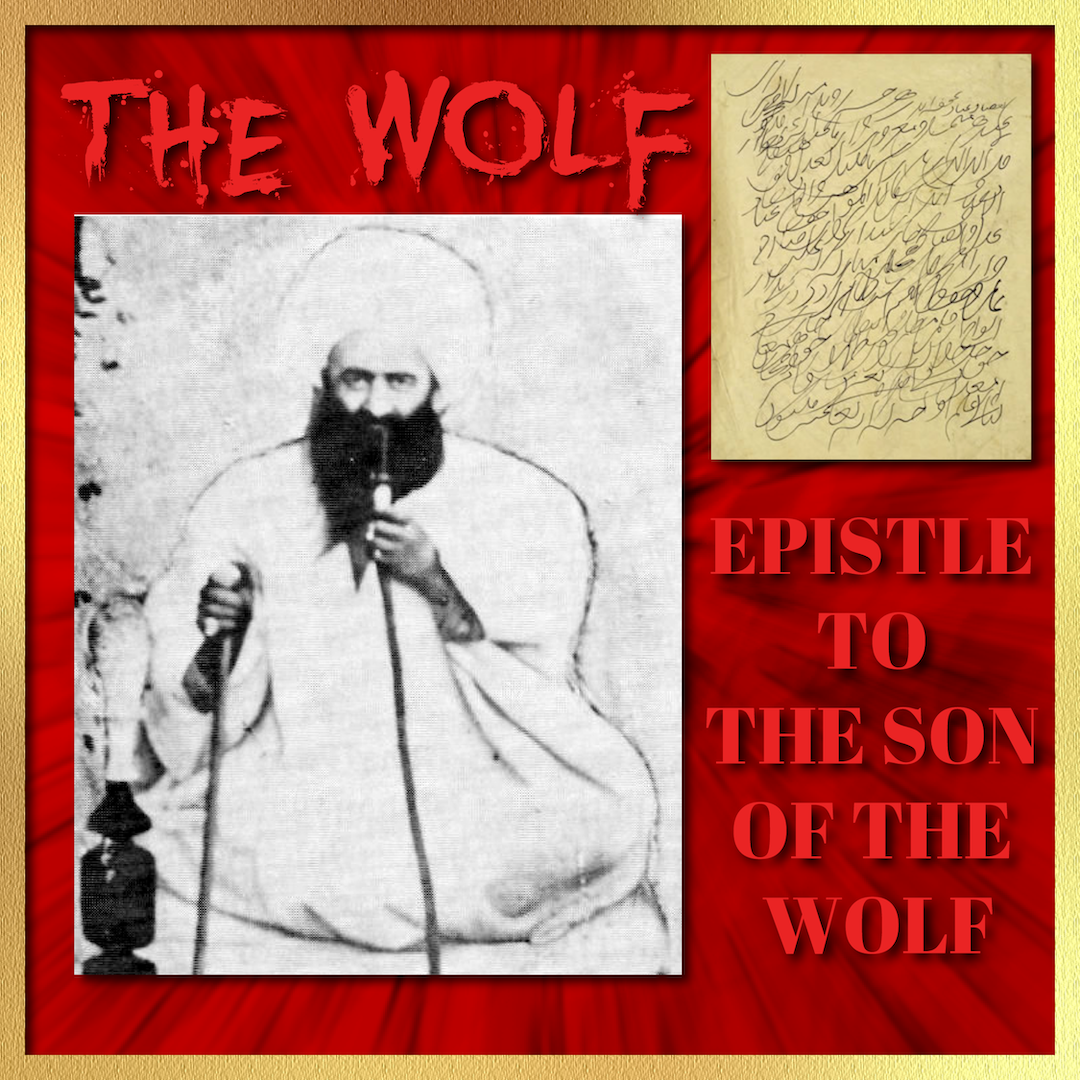
Shaykh Muḥammad-Taqí, known as Áqá Najafí, and addressed to as the “Son of the Wolf,” of the sons of Shaykh Báqir (the Wolf), responsible for the deaths of the King and Beloved of martyrs. Source: Wikimedia Commons. Leaf from Lawḥ-i-Ibn-i-Dhi’b (The Epistle to the Son of the Wolf), addressed to this same Shaykh, in the "Revelation" handwriting of Mírzá Áqá Ján, Bahá’u’lláh’s amanuensis. Source: The Life of Bahá'u'lláh: A Photographic Narrative, © Bahá'í International Community. Red background overlaid over a blurred closeup of the same sheet of Revelation Writing.
Lawḥ-i-Ibn-i-Dhi’b (The Epistle to the Son of the Wolf) was Bahá'u'lláh’s last major work and His third longest, revealed sometime between February and July 1891. In this weighty book, Bahá'u'lláh calls on an inveterate enemy of the Faith and one of His most formidable opponents, Shaykh Muḥammad-Taqí, known as Áqá Najafí. Áqá Najafí was one of the sons of Shaykh Muhammad-Báqir, stigmatized by Bahá'u'lláh as “The Wolf,” and responsible for the deaths of the King and Beloved of Martyrs.
In Epistle to the Son of the Wolf, Bahá'u'lláh calls on the Shaykh to repent for his role in the persecution and massacre of Bahá'ís, frequently quoting from some of the most celebrated passages from His own Writings, and establishing the incontrovertible truth of the Bahá'í Faith.
With Shaykh Muḥammad-Taqí and his father, the apple did not fall far from the tree. The “Son” took over from the “the Wolf” in 1883 as one of Iṣfahán’s leading mujtahids, after helping his father hunt down and murder Bahá'ís in his misspent youth, even rolling up his sleeves in 1879 and volunteer to execute the King and Beloved of Martyrs personally. Epistle to the Son of the Wolf is filled with counsels for Áqá Najafí’s spiritual rehabilitation, but despite Bahá'u'lláh’s warnings, the Shaykh continued his opposition to the Faith despite Bahá'u'lláh’s efforts to make him see the error of His ways and offering sincere prayers for his soul. In one particularly moving passage, Bahá'u'lláh gives Áqá Najafí the words to beg God's forgiveness for his wicked deeds: “Alas, alas, for my waywardness, and my shame, and my sinfulness, and my wrong-doing...alas, alas! and again alas, alas! for my wretchedness and the grievousness of my transgressions!”
Partial Inventory ID: BH00005
Bahá'u'lláh, Epistle to the son of the Wolf.
Adib Taherzadeh, The Revelation of Bahá'u'lláh Volume 4: Mazra’ih and Bahjí 1877-1892, pages 368-390.
H.M. Balyuzi, Bahá'u'lláh: The King of Glory, pages 382-384.
DATE
The Leiden List, itself obtained from Vahid Ra’fati in Pazúhish-Námih (Canadian Association for Bahá’í Studies), Volume 2, Number 1.
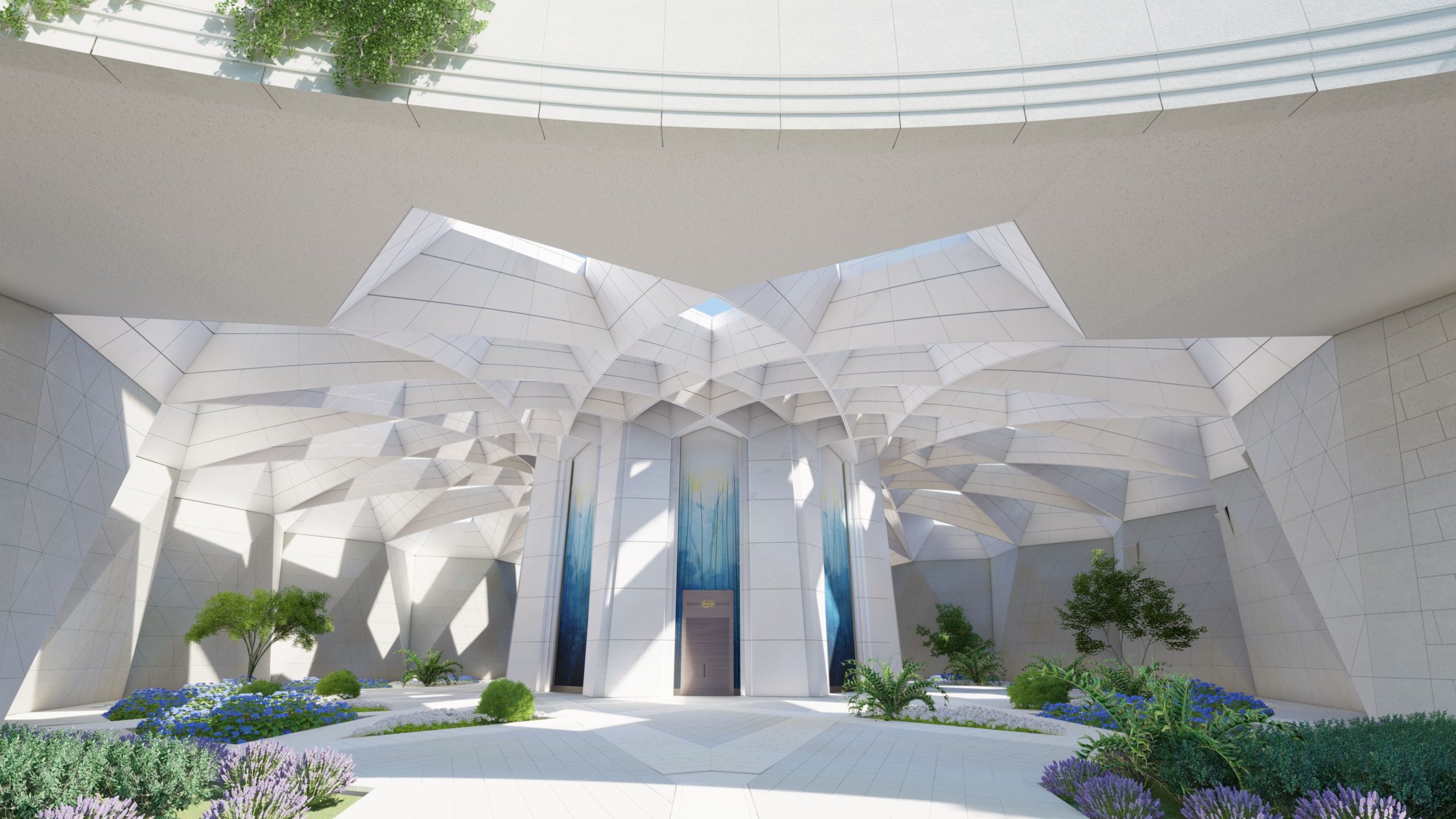
The healing presence of 'Abdu'l-Bahá, of which Bahá'u'lláh speaks in the collection of stories below, His station, His powers, all of these are embodied in the extraordinary tribute to His greatness and His power, His lifelong humility and His station as Center of the Covenant that is His Shrine. Graphic rendering of the Shrine of 'Abdu'l-Bahá. Source: Bahá'í Media Bank © Bahá'í International Community.
Increasing numbers of pilgrim notes from 1879 to 1892 make reference to Bahá'u'lláh’s statements about the exalted station, superhuman powers, and healing presence of 'Abdu'l-Bahá. When Ḥájí Mírzá Ḥaydar-‘Alí made a compilation of Islámic traditions regarding 'Abdu'l-Bahá, Bahá'u'lláh applauded his effort, confirmed his conclusions and added “The force of the utterance of the Most Great Branch and His powers are not as yet fully revealed. In the future it will be seen how He, alone and unaided, shall raise the banner of the Most Great Name in the midmost heart of the world, with power and authority and Divine effulgence. It will be seen how He shall gather together the peoples of the earth under the tent of peace and concord.”
Bahá’u’lláh was deeply saddened by the behavior of Bahá'ís living in His home one day, and told Ḥájí Mírzá Ḥaydar-‘Alí, that, were it possible, He would direct all arriving pilgrims to enter the presence of 'Abdu'l-Bahá, meet steadfast Bahá'ís, and return home, explaining that, “in the Master’s presence the friends are not subjected to tainted human thoughts and deeds. All they experience is heavenly sanctity,” and that believers who had entered the presence of 'Abdu'l-Bahá would be so transformed as to be unaffected by hearing of odious deeds committed under His roof.
One day in 1891, Bahá'u'lláh invited all the pilgrims and resident Bahá'ís to Junaynih for the day. It was a beautiful morning, the air fresh and invigorating, and Junaynih was heavenly: the garden paths were charming, the trees and flower danced in the breeze, and birds sang sweetly on branches. Several hours later, when 'Abdu'l-Bahá arrived, Bahá'u'lláh sent all the believers to rush and meet Him. When 'Abdu'l-Bahá arrived in His presence, Bahá'u'lláh welcomed Him with deeply touching words, spoken in front of the entire Bahá'í community of 'Akká: “From morning until now this garden was not pleasant, but now with the presence of the Master it has become truly most delightful.”
'Abdu'l-Bahá explained He had been unavoidably detained by several hours of meetings with the Governor and 'Akká residents, to which Bahá'u'lláh smiled, and responded: "Áqá is Our shield and the shield of everyone else; all live at ease, all know utmost comfort and tranquility. Consorting with men such as these is very, very difficult. It is Áqá who stands up to everything and supplies the means for the well-being and peace of all. May God preserve Him from the evil of all the envious and the inimical.”
H.M. Balyuzi, Bahá'u'lláh: The King of Glory, pages 378-380 and 415-416.
H.M. Balyuzi, ‘Abdu’l-Bahá: The Centre of the Covenant of Bahá’u’lláh, page 44.
Ḥájí Mírzá Ḥabíbu'lláh Afnán, Memories of the Báb, Bahá'u'lláh and 'Abdu'l-Bahá, translated and annotated by Ahang Rabbani, an electronic publication of Kalimat Press, January 2005, PDF page 38.
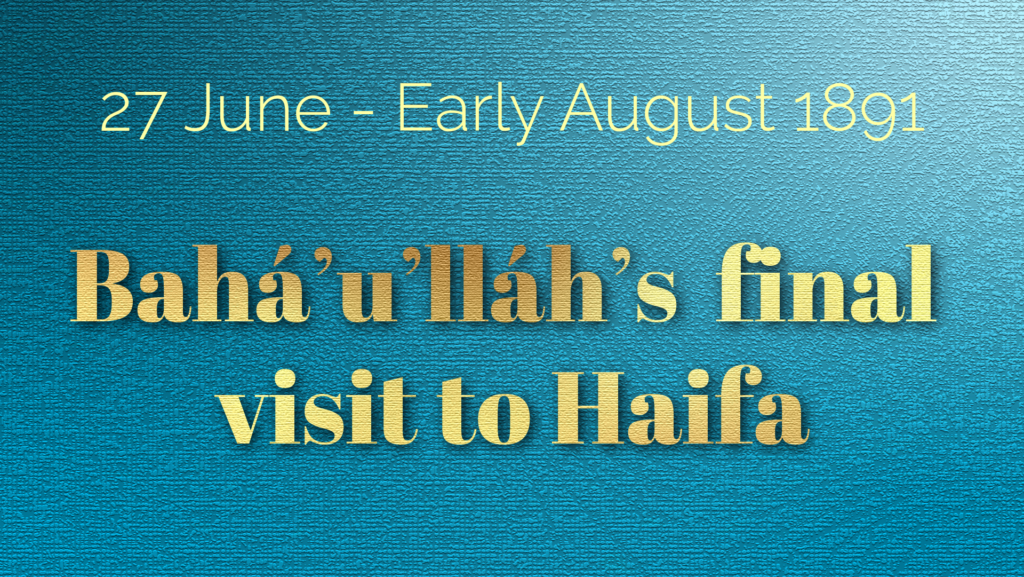
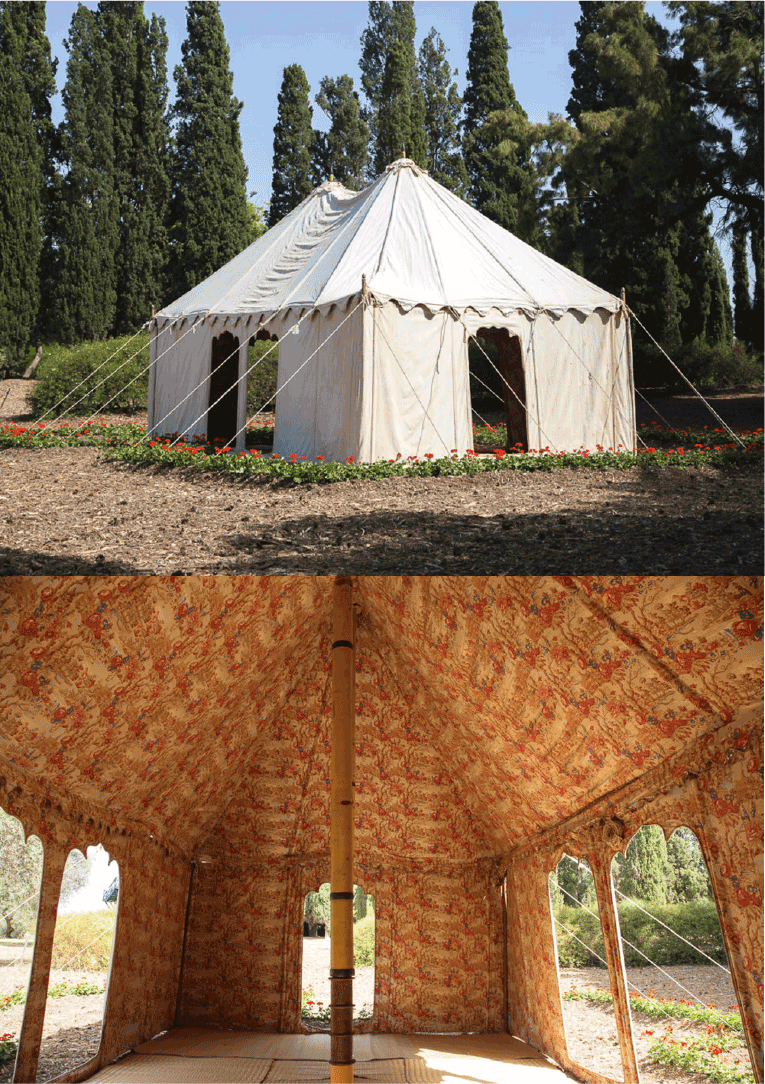
The outside and inside of a tent which Bahá'ís living in India had sent Bahá’u’lláh. These tents provided shelter during His visits to the countryside and were also sometimes pitched close to where Bahá’u’lláh was staying to provide space for Him to receive pilgrims and visitors. Disclaimer: it is not known if the tent pictured here was used during this visit. Source: Bicentenary of the Birth of Bahá'u'lláh, © Bahá'í International Community.
In the summer of 1891, less than a year before His passing, Bahá'u'lláh spent five weeks in Haifa from 27 June to early August 1891, the longest and most significant of His visits, in terms of its impact on the destiny of the Bahá'í Faith.
Bahá'u'lláh pitched His tent in at least three places that summer. He first lived in Bayt Abyad, a house belonging to Ilyas Abyad, near the German Templer Colony, and His tent was pitched across the street, then pitched His tent on a vacant plot of land on the corner of Hagefen Street and Morad Keramin Lane, at the very base of Mount Carmel, and visited the house next door.
At some point during His summer in Haifa, Bahá'u'lláh suffered from a brief illness, and He was invited into the house of a German Templer family, the Pfanders while He was being treated by a Templer doctor, possibly Dr. J. Schmidt. The Pfanders’ house was one of those in the Colony that bore the prophetic inscription “Der Herr ist nahe” (The Lord is near).
The Pfander’s four-year old girl, Wilhelmine, most probably born around 1887, recalled 90 years later that she remembered seeing Bahá'u'lláh in the room at the northwest corner of the ground floor.
Reflections on the Bahai Writings: Bahá’u’lláh’s Visits to Haifa.
Fuad Izadinia, The Major Opus: A study of the German Templers movement and its relationship with the Bahá'í Faith.
H.M. Balyuzi, Bahá'u'lláh: The King of Glory, page 374.
David S. Ruhe, Door of Hope: The Bahá’í Faith in the Holy Land, page 229, note 5.
Audio talk on Bahá'í Works: Dhikru’lláh Khádem, Carmel - The Mountain of God, timestamp: 23:41 (for the mention of a few days between the two events), and timestamp: 24:00 (For the reference on Bahá'u'lláh instituting both spiritual and administrative centers of the Bahá'í within a few days of each other in June 1891)
DATE AND DURATION
It is commonly believed that Bahá'u'lláh’s last visit in Haifa lasted three months, but recent research by Dr. Vahid Rafati has shown that Bahá'u'lláh Celebrated the Twin Holy Days in Bahjí on 6 and 7 August 189, meaning Bahá'u'lláh’s fourth visit to Haifa lasted five weeks.More details, including quotes from the Persian Article by Dr. Rafati, Jamál-i-Qadam dar Haifa (Bahá'u'lláh in Haifa) published in Pazhuheshnameh Number 3 – page 85, can be found.
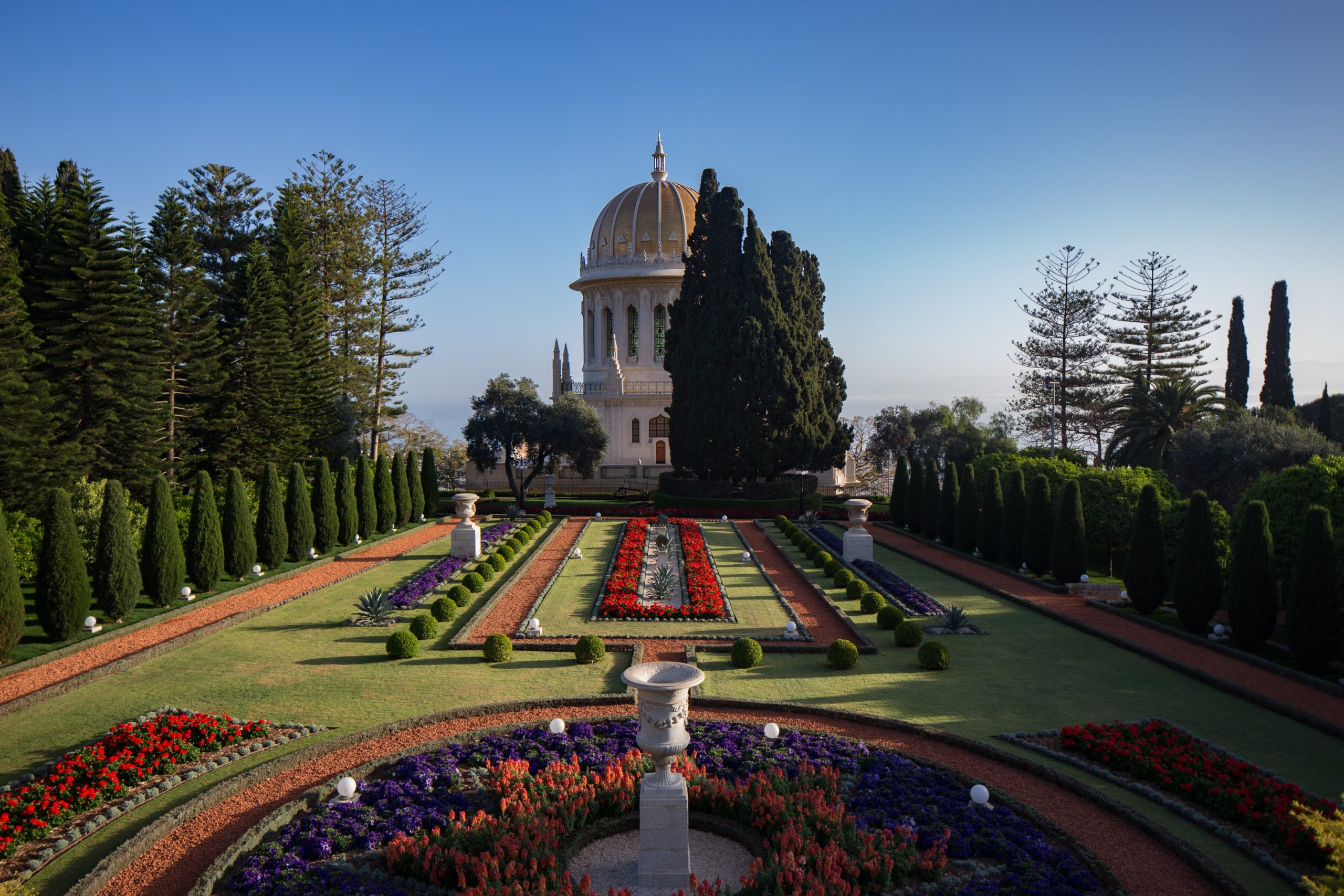
In the story below, Bahá'u'lláh stood in the grove of young cypresses, and pointed to a spot immediately below, indicating to 'Abdu'l-Bahá where He should erect the Shrine of the Báb. This photographs offers a view of both the grove of cypresses, and the completed Shrine. Source: Bahá'í Media Bank © Bahá'í International Community.
One day in late June 1891, Bahá'u'lláh and 'Abdu'l-Bahá were seated in a circle of 15 very young, wispy cypress trees, about halfway up the slopes of Mount Carmel. Bahá'u'lláh had previously visited this enchanting spot, clean and beautiful, on Mount Carmel, which reminded Him of one of His favorite mountain retreats in the outskirts of Ṭihrán called Murgh-Maḥallih (the Abode of the Birds).
That day, Bahá’u’lláh gave ‘Abdu’l-Bahá what would become one of the three chief objectives of His own ministry. Standing from His seat, Bahá'u'lláh pointed to rocky stony expanse a little lower on the mountain, and directed 'Abdu'l-Bahá to purchase it, build a shrine on the land, and inter the sacred remains of the Báb in the Shrine. With a single gesture, Bahá'u'lláh had made Haifa a Holy Place, a spiritual center for the Bahá'í Faith for centuries to come.
H.M. Balyuzi, Bahá'u'lláh: The King of Glory, pages 374-375.
Michael V. Day, Journey to a Mountain: The story of the Shrine of the Báb. Vol. I: 1850–1921, Kindle Edition, locations 576 to 628.
Audio talk on Bahá'í Works: Dhikru’lláh Khádem, Carmel - The Mountain of God, timestamp: 24:00 (For the reference on Bahá'u'lláh instituting both spiritual and administrative centers of the Bahá'í within a few days of each other in June 1891)
DATE
Michael V. Day in Journey to a Mountain: The story of the Shrine of the Báb, Kindle locations 576 and 603.
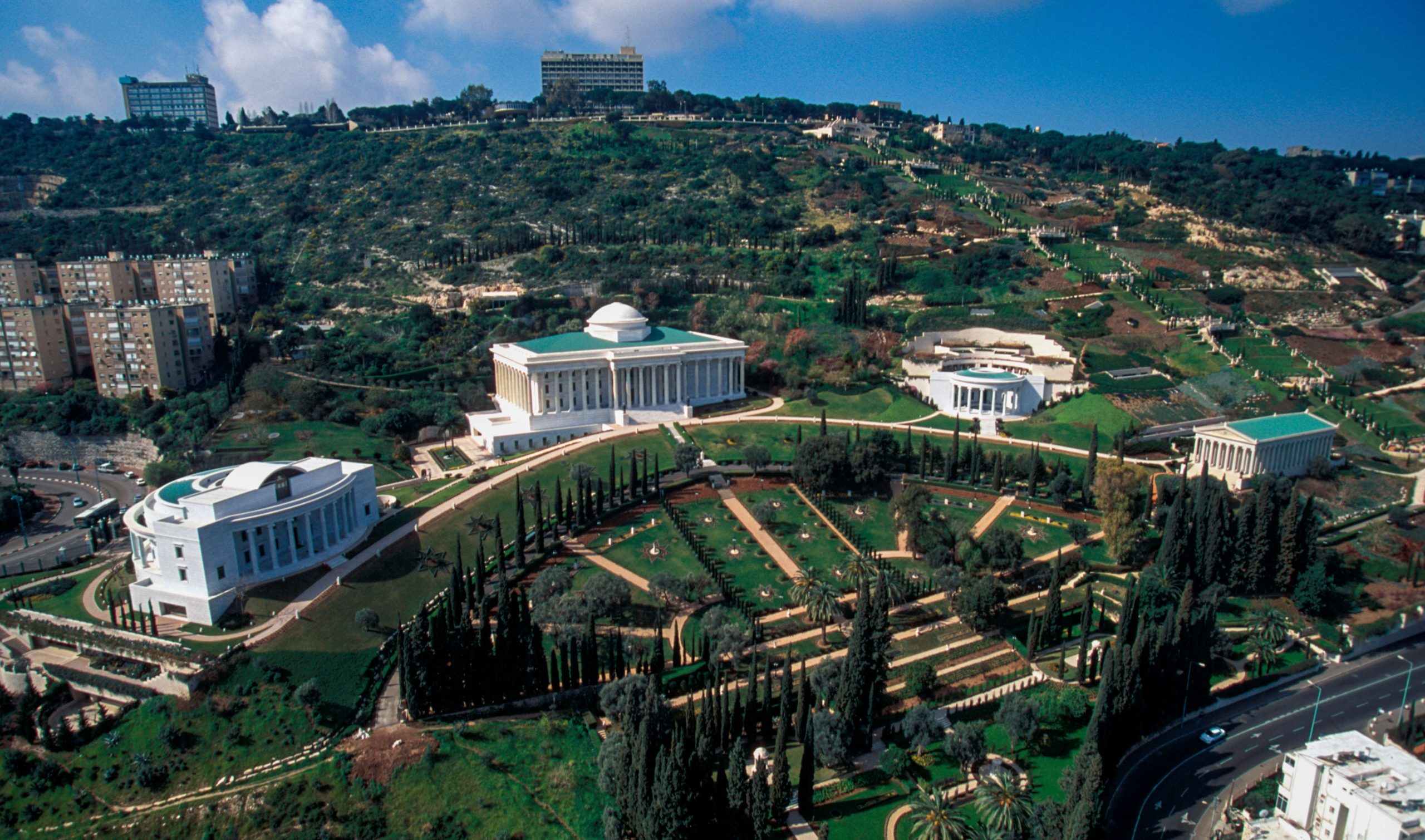
The Arc on Mount Carmel, the heart of the Bahá'í Administrative order, and an illustration for the following in the Tablet of Carmel, in which Bahá'u'lláh speaks to the mountain, referring to the Seat of the House of Justice, in the center of the photograph: “Ere long will God sail His Ark upon thee...” Source: Bahá'í Media Bank © Bahá'í International Community.
A few days later, Bahá'u'lláh, accompanied by 'Abdu'l-Bahá and some believers visited the “upper” Cave of Elijah on the Western edge of Mount Carmel, located inside the Carmelite monastery before walking away from the monastery.
Bahá’u’lláh summoned Mírzá Áqá Ján to transcribe, and began revealing the Tablet of Carmel, chanting with a loud and clear voice in such forceful ringing tones, that His melodious voice reverberated around the mountaintop, heard all the way inside the monastery. Shoghi Effendi described this moment: “Such was the commotion created on that historical event, … the earth seemed to shake, while all those present were overpowered by His mighty and wondrous spirit.”
The Tablet of Carmel is considered the charter of the development of the Bahá'í World Centre, prefacing as it does, both the Holy Places and the Seats of the Bahá'í Administrative Order both to be erected on Mount Carmel itself. Shoghi Effendi had interpreted the two references, explaining that the “Ark” referred to by Bahá'u'lláh in this Tablet is the Seat of the Universal House of Justice: “Ere long will God sail His Ark upon thee, and will manifest the people of Bahá who have been mentioned in the Book of Names,” and that the Shrine of the Báb is intended by the terms “City of God,” and the “celestial Kaaba.”
David S. Ruhe, Door of Hope: The Bahá’í Faith in the Holy Land, page 177.
Reflections on the Bahai Writings: Bahá’u’lláh’s Visits to Haifa.
Michael V. Day, Journey to a Mountain: The story of the Shrine of the Báb. Vol. I: 1850–1921, Kindle Edition, locations 628. (For the correct order in which Bahá'u'lláh visited the cave of Elijah first, then revealed the Tablet of Carmel)
Ugo Giachery, Shoghi Effendi, page 210.
David S. Ruhe, Door of Hope: The Bahá’í Faith in the Holy Land, pages 175 and 177.
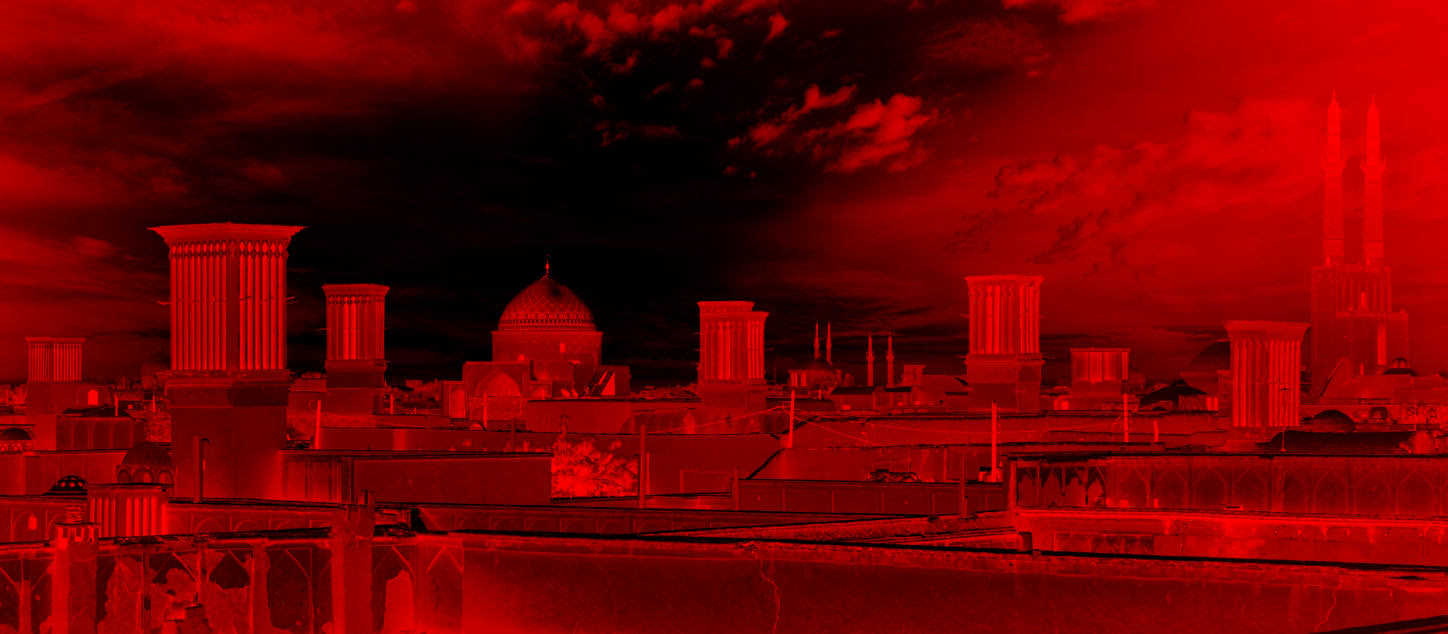
The city of Yazd, bathed in the blood of Bahá'í martyrs. Source of the original image.
Shortly after Áqá Mírzá Áqá, the father of the Afnáns, arrived from Port Said, Bahá'u'lláh learned of the atrocities perpetrated on the Seven Martyrs of Yazd. Six weeks earlier, on 19 May 1891, Maḥmúd Mírzá, the Governor of Yazd and son of Naṣiri'd-Dín Sháh had executed seven Bahá'ís in the most horrific manner in the streets of Yazd, their bodies desecrated by a frenzied crowd. The news plunged Bahá'u'lláh into a state of deep sorrow. He put a stop to Revelation for nine days and admitted no one into His presence.
Shoghi Effendi, God Passes By.
H.M. Balyuzi, Bahá'u'lláh: The King of Glory, page 409.
DATE
Áqá Mírzá Áqá arrived shortly after his older son had left Haifa, 15 days after they arrived on 17 July 1891. The arrival date was obtained from Adib Taherzadeh, The Revelation of Bahá'u'lláh Volume 4: Mazra’ih and Bahjí 1877-1892, page 332. Fifteen days after 17 July 1891 is 1 August 1891.
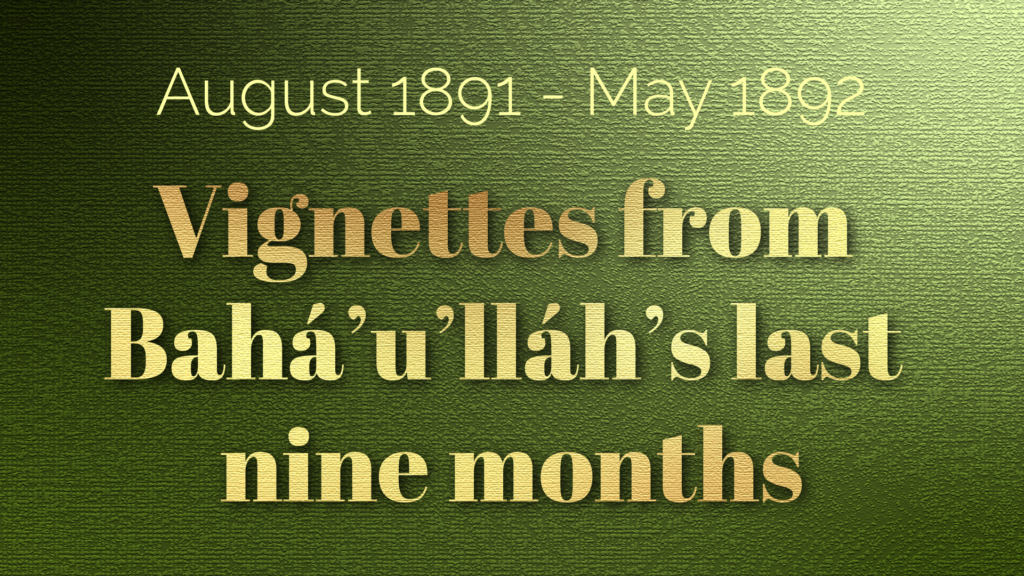
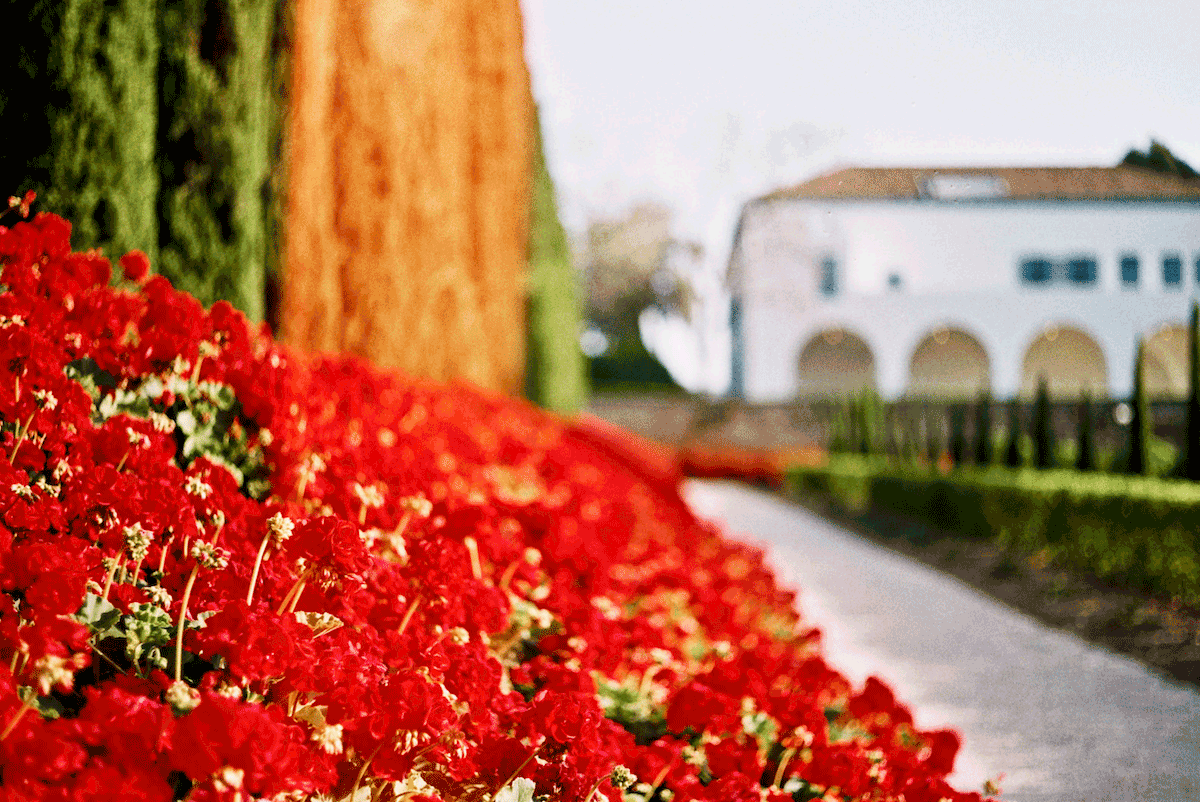
As an illustration of the better world promised by Bahá'u'lláh in the Lawḥ-i-Dunyá (Tablet of the World) in which He speaks of the “freedom, well-being, tranquility, exaltation and advancement of all men,” a heavenly vista of the Mansion of Bahjí where this Tablet was revealed. © Chad Mauger, all rights reserved, used with permission. Source: Flickr.
The first Tablet Bahá'u'lláh revealed after hearing the news about the Seven Martyrs of Yazd was the Lawḥ-i-Dunyá (Tablet of the World), in which He reiterates many of the central teachings of His Faith. Some of Bahá'u'lláh’s teachings in this Tablet are personal guidance for individuals such as detachment from the promptings of self, dedicating oneself to the advancement of the entire human race, contributing to the betterment of the world through “pure and goodly deeds, through commendable and seemly conduct” (this universally well-known Bahá'í aphorism comes from the Lawḥ-i-Dunyá), associating with the followers of all religions with not only friendliness but also fellowship, and staying away from contention and conflict and practicing courtesy.
In a series of particularly memorable excerpts, Bahá'u'lláh speaks about the duty of all people to carry forward an ever-advancing civilization by cleaving “unto whatsoever will promote the interests, and exalt the station, of all nations and just governments,” and “will ensure the freedom, well-being, tranquility, exaltation and advancement of all men,” by following the essential prerequisites laid down by Bahá'u'lláh of “concord, of understanding, of complete and enduring unity,” and following His counsels constituting the “supreme animating power for the advancement of the world and the exaltation of its peoples.” Bahá'u'lláh further states He revealed in the Crimson Book that “which is conducive to the advancement of mankind and to the reconstruction of the world,” and that all men should dedicated themselves to “that which will promote fellowship, kindliness and unity.”
Other themes developed by Bahá'u'lláh in the Lawḥ-i-Dunyá are universal and aimed at the rebuilding of society, such as enjoining the members of the Universal House of Justice to “promote the Lesser Peace,” calling the peoples of the world to “embrace one universal faith,” to adopt a universal language and script, to contribute to and champion the universal education of children, and to ”pay special regard” and recognize the importance of agriculture.
Partial Inventory ID: BH00238
Bahá'u'lláh, Lawḥ-i-Dunyá (Tablet of the World).
Adib Taherzadeh, The Revelation of Bahá'u'lláh Volume 4: Mazra’ih and Bahjí 1877-1892, pages 337 and 341.
DATE
In H.M. Balyuzi, Bahá'u'lláh: The King of Glory, page 410 it is recorded that the Lawḥ-i-Dunyá was the first Tablet revealed after Bahá'u'lláh put a stop to Revelation for nine days around 1 August 1891.
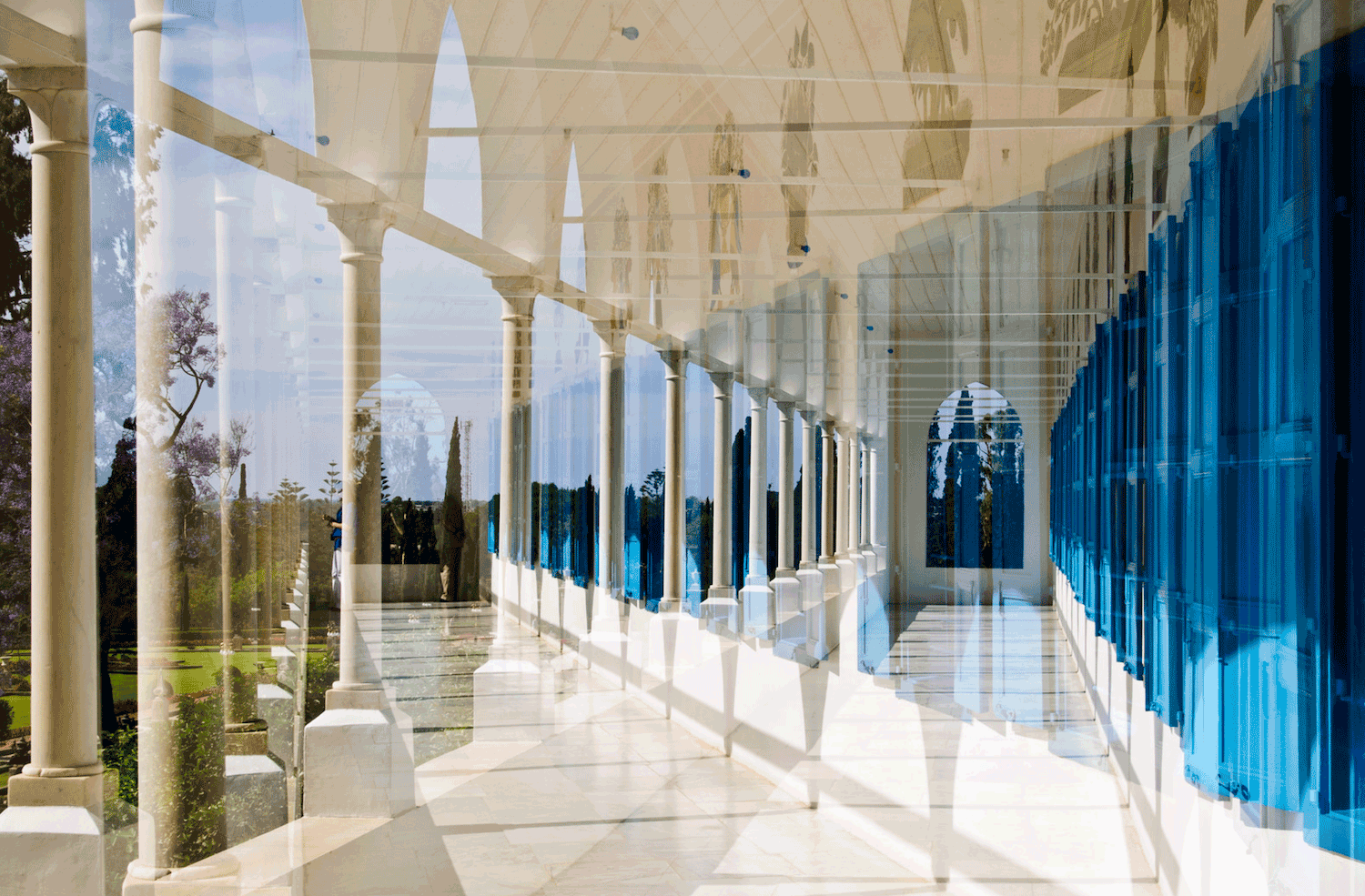
In an homage to Bahá'u'lláh’s last Twin Holy Days celebration in the Mansion of Bahjí, an artful double exposure of the colonnaded balcony on the upper floor. © Chad Mauger, all rights reserved, used with permission. Source: Flickr.
Shortly after His return from Haifa, Bahá'u'lláh celebrated the Twin Holy Days of His ministry. In the Muslim lunar calendar, the Báb’s birthday of 20 October 1819 fell on 1 Muḥarram 1235 A.H., and Bahá'u'lláh’s 12 November 1817 date of birth occurred on 2 Muḥarram 1233 A.H., making their birthdays consecutive, and celebrated by Bahá'ís as back-to-back Twin Holy Days. Bahá'u'lláh revealed a short Tablet, on the occasion of the birth of the Báb, containing a significant passage regarding the Twin Holy Days: “O concourse of earth and heaven! This is that first night, which God hath made to be a sign of that second night, whereon was born He Whom no praise can befittingly extol and no attribute describe.
In 1891, the Twin Holy Days of 1 and 2 Muḥarram took place on 6 and 7 August 1891, immediately after Bahá'u'lláh’s return from Haifa. On 6 August 1891, the Holy Day of the birth of the Báb, Bahá'u'lláh expounded on the history of division and disunity in religion from Islám to the Bábí Faith, mainly caused by people to selectively interpret the Holy Writings. Bahá'u'lláh distributed pieces of a báqlavá, a middle-eastern nut-based sweet, to the assembled believers, and spoke about the significance of this Holy Day: "This is the day on which ḤaḍrAt-i-Mubashshir [the Báb] set foot in this world and illumined it with His light. There is every reason for to rejoice. "
The next day, 7 august 1891 (2 Muḥarram 1309), was the Festival of the birth of Bahá'u'lláh, and the Bahá'ís in 'Akká were summoned to His presence. Bahá'u'lláh spoke to them about the sublimity of His advent, the power of the Most Exalted Pen, the circumstances of His banishments, and His arrival in the Most Great Prison, and addressed the fleeting nature of any persecutions heaped upon the Faith by tyrants and religious leaders, by quoting two lines from Ḥafíẓ: “These times more bitter than venom shall pass away, And once again, times as sweet as sugar shall come this way.”
Ḥájí Mírzá Ḥabíbu'lláh Afnán, Memories of the Báb, Bahá'u'lláh and 'Abdu'l-Bahá, translated and annotated by Ahang Rabbani, an electronic publication of Kalimat Press, January 2005, PDF page 33-34.
H.M. Balyuzi, Bahá'u'lláh: The King of Glory, pages 411-413.
Bahá'u'lláh, Kitáb-i-Aqdas, Note 138.
Bahá'u'lláh, Days of Remembrance: Selection N° 40: The birth of the Báb.
Wikipedia: Muharram.
Bahá'u'lláh, Days of Remembrance: Selection N° 43.
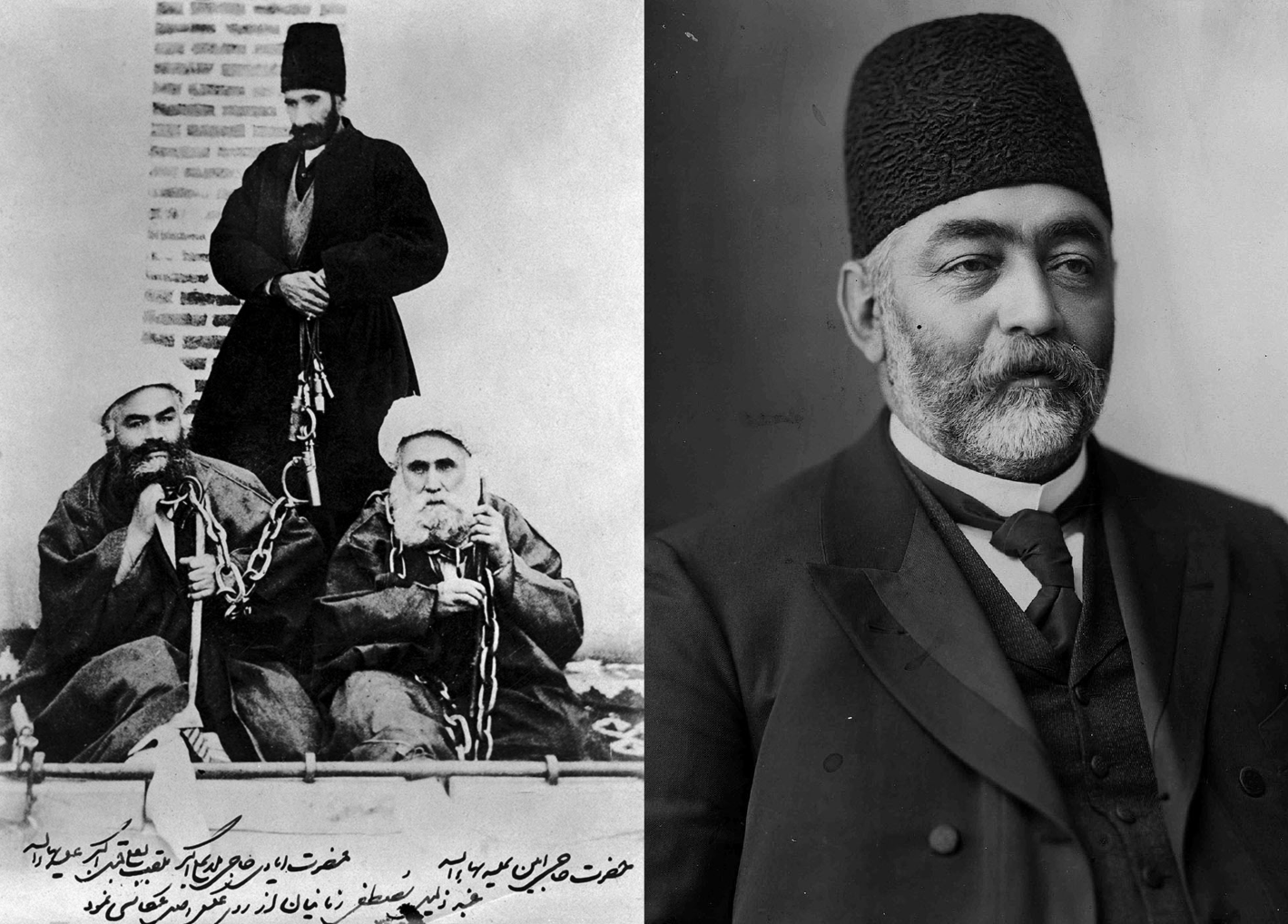
Prime Minister. Those of whom Bahá'u'lláh speaks in His Tablet to the Prime Minister of Persia: Ḥájí Akhúnd, and Ḥájí Amín in the prison of Qazvín, their feet in stocks, their necks in chains and their jailer in attendance. Source: Archives of Bahá'í Persecution in Iran. The addressee of that same Tablet, one of Bahá'u'lláh’s very last , the Prime Minister of the Sháh of Persia, ‘Alí Asghar Khán. Source: Wikimedia Commons.
In 1891, Hands of the Cause Hájí Ákhúnd, and Hájí Amín were imprisoned in Qazvín, where they stayed for two years. 'Alí-Asghar Khán, the Sháh’s Prime Minister knew their incarceration was unjust and had made kind remarks about the Hands of the Cause. Not long before His Ascension, Bahá'u'lláh said to 'Abdu'l-Bahá that the following message should be conveyed to 'Alí-Asghar Khán: “You took steps to help the prisoners; you freely rendered them a befitting service; this service will not be forgotten. Rest assured that it will bring you honor and call down a blessing upon all your affairs. O Amínu's-Sultán! Every house that is raised up will one day fall to ruin, except the house of God; that will grow more massive and be better guarded day by day. Then serve the Court of God with all your might, that you may discover the way to a home in Heaven, and found an edifice that will endure forever.”
'Alí-Asghar Khán received Bahá'u'lláh’s message after His Ascension.
Adib Taherzadeh, The Revelation of Bahá'u'lláh Volume 4: Mazra’ih and Bahjí 1877-1892, page 185.
Translated in 'Abdu'l-Bahá, Memorials of the Faithful: Sulaymán Khán-i-Tunukábání.
̉
